SITHKOP004 Develop Menus for Special Dietary Requirements - Student Assessment Pack
VerifiedAdded on 2022/11/23
|47
|10796
|153
AI Summary
This Student Assessment Pack is for the unit SITHKOP004 Develop Menus for Special Dietary Requirements. It includes information on assessment methods, instructions for learners and assessors, and resources.
Contribute Materials
Your contribution can guide someone’s learning journey. Share your
documents today.
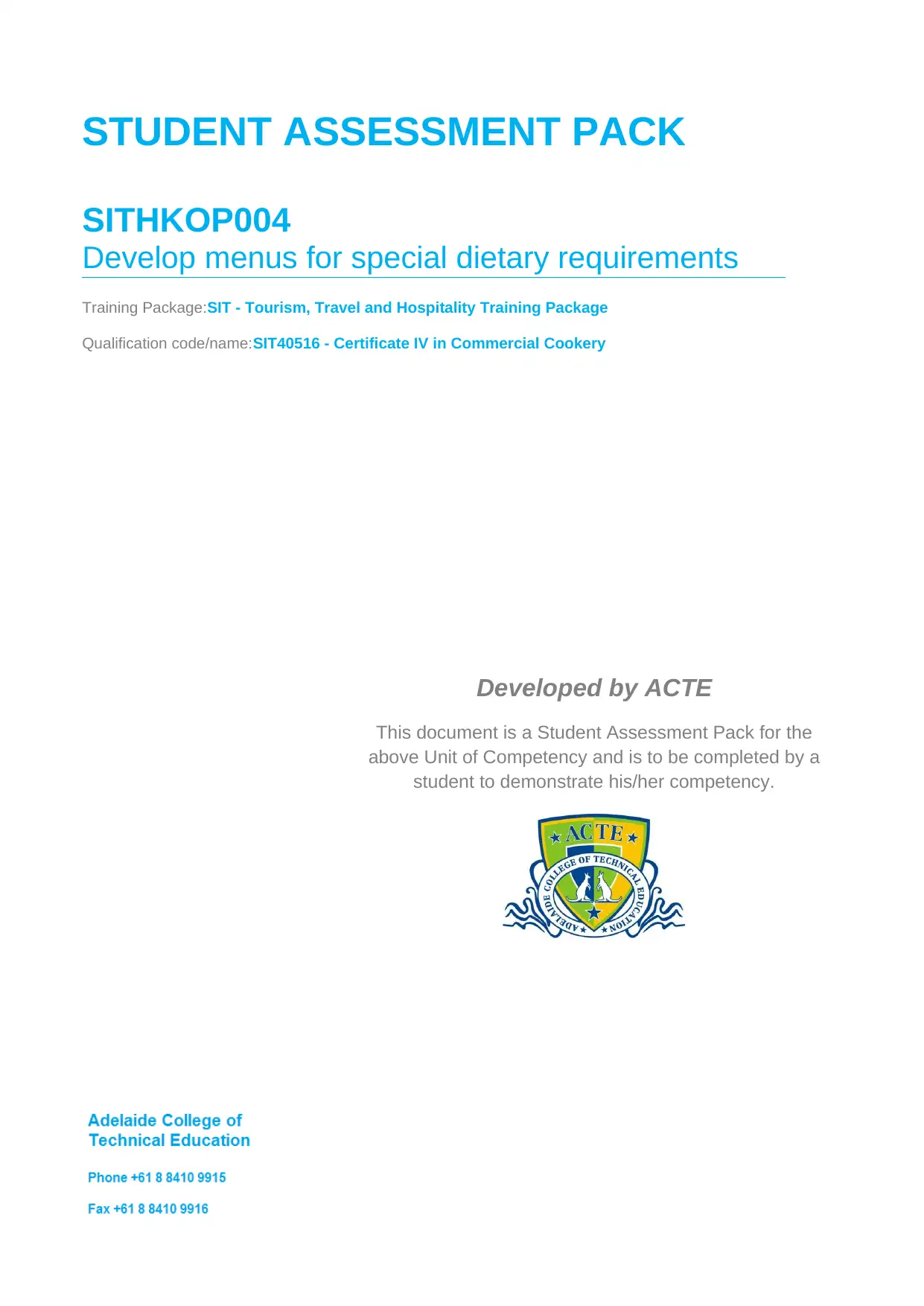
Developed by ACTE
This document is a Student Assessment Pack for the
above Unit of Competency and is to be completed by a
student to demonstrate his/her competency.
STUDENT ASSESSMENT PACK
SITHKOP004
Develop menus for special dietary requirements
Training Package:SIT - Tourism, Travel and Hospitality Training Package
Qualification code/name:SIT40516 - Certificate IV in Commercial Cookery
This document is a Student Assessment Pack for the
above Unit of Competency and is to be completed by a
student to demonstrate his/her competency.
STUDENT ASSESSMENT PACK
SITHKOP004
Develop menus for special dietary requirements
Training Package:SIT - Tourism, Travel and Hospitality Training Package
Qualification code/name:SIT40516 - Certificate IV in Commercial Cookery
Secure Best Marks with AI Grader
Need help grading? Try our AI Grader for instant feedback on your assignments.
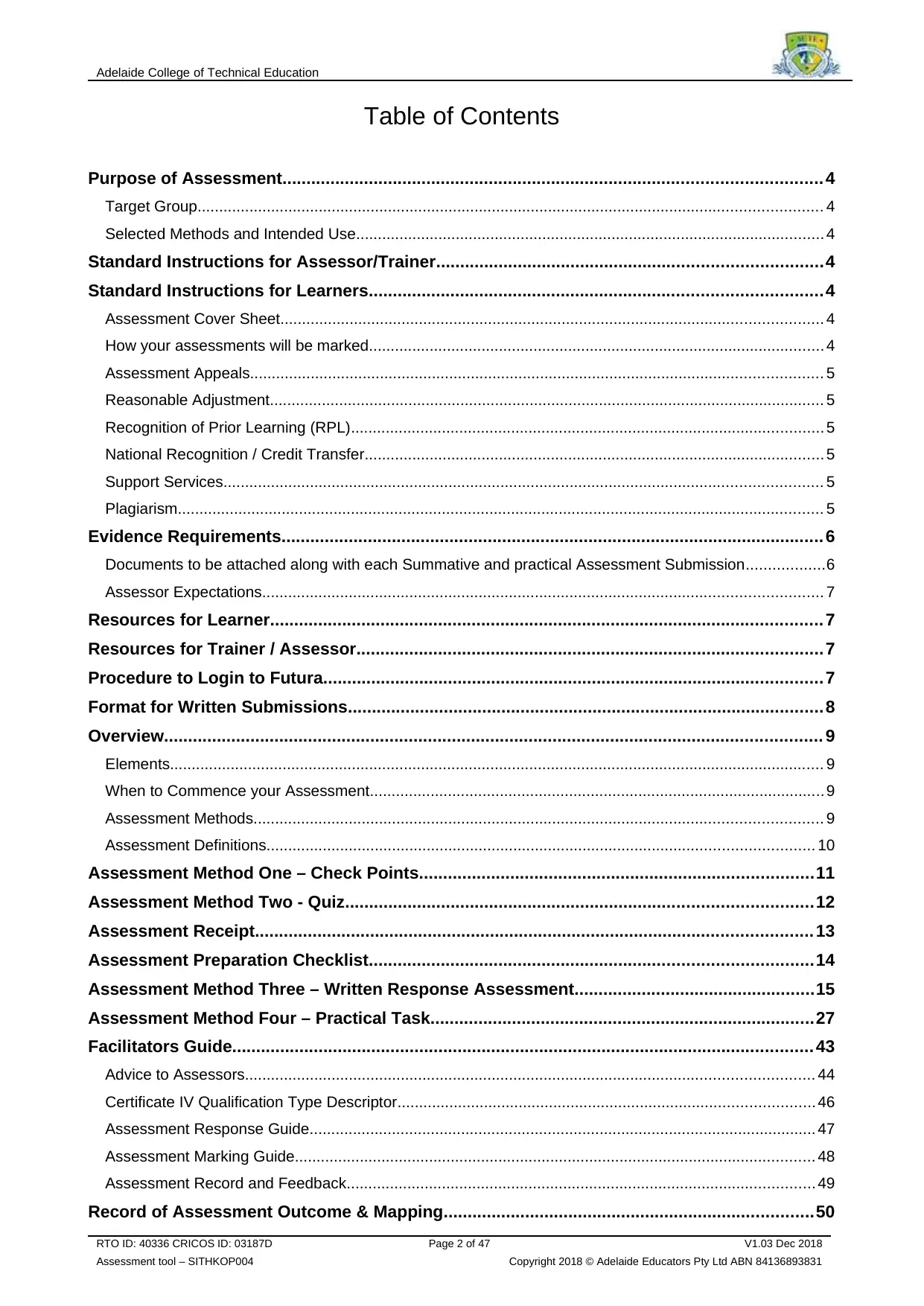
Adelaide College of Technical Education
Table of Contents
Purpose of Assessment................................................................................................................ 4
Target Group................................................................................................................................................ 4
Selected Methods and Intended Use............................................................................................................ 4
Standard Instructions for Assessor/Trainer................................................................................4
Standard Instructions for Learners..............................................................................................4
Assessment Cover Sheet............................................................................................................................. 4
How your assessments will be marked......................................................................................................... 4
Assessment Appeals.................................................................................................................................... 5
Reasonable Adjustment................................................................................................................................ 5
Recognition of Prior Learning (RPL)............................................................................................................. 5
National Recognition / Credit Transfer.......................................................................................................... 5
Support Services.......................................................................................................................................... 5
Plagiarism..................................................................................................................................................... 5
Evidence Requirements................................................................................................................. 6
Documents to be attached along with each Summative and practical Assessment Submission..................6
Assessor Expectations................................................................................................................................. 7
Resources for Learner................................................................................................................... 7
Resources for Trainer / Assessor.................................................................................................7
Procedure to Login to Futura........................................................................................................7
Format for Written Submissions...................................................................................................8
Overview......................................................................................................................................... 9
Elements....................................................................................................................................................... 9
When to Commence your Assessment......................................................................................................... 9
Assessment Methods................................................................................................................................... 9
Assessment Definitions.............................................................................................................................. 10
Assessment Method One – Check Points..................................................................................11
Assessment Method Two - Quiz.................................................................................................12
Assessment Receipt.................................................................................................................... 13
Assessment Preparation Checklist............................................................................................14
Assessment Method Three – Written Response Assessment..................................................15
Assessment Method Four – Practical Task................................................................................27
Facilitators Guide......................................................................................................................... 43
Advice to Assessors................................................................................................................................... 44
Certificate IV Qualification Type Descriptor................................................................................................ 46
Assessment Response Guide..................................................................................................................... 47
Assessment Marking Guide........................................................................................................................ 48
Assessment Record and Feedback............................................................................................................ 49
Record of Assessment Outcome & Mapping.............................................................................50
RTO ID: 40336 CRICOS ID: 03187D Page 2 of 47 V1.03 Dec 2018
Assessment tool – SITHKOP004 Copyright 2018 © Adelaide Educators Pty Ltd ABN 84136893831
Table of Contents
Purpose of Assessment................................................................................................................ 4
Target Group................................................................................................................................................ 4
Selected Methods and Intended Use............................................................................................................ 4
Standard Instructions for Assessor/Trainer................................................................................4
Standard Instructions for Learners..............................................................................................4
Assessment Cover Sheet............................................................................................................................. 4
How your assessments will be marked......................................................................................................... 4
Assessment Appeals.................................................................................................................................... 5
Reasonable Adjustment................................................................................................................................ 5
Recognition of Prior Learning (RPL)............................................................................................................. 5
National Recognition / Credit Transfer.......................................................................................................... 5
Support Services.......................................................................................................................................... 5
Plagiarism..................................................................................................................................................... 5
Evidence Requirements................................................................................................................. 6
Documents to be attached along with each Summative and practical Assessment Submission..................6
Assessor Expectations................................................................................................................................. 7
Resources for Learner................................................................................................................... 7
Resources for Trainer / Assessor.................................................................................................7
Procedure to Login to Futura........................................................................................................7
Format for Written Submissions...................................................................................................8
Overview......................................................................................................................................... 9
Elements....................................................................................................................................................... 9
When to Commence your Assessment......................................................................................................... 9
Assessment Methods................................................................................................................................... 9
Assessment Definitions.............................................................................................................................. 10
Assessment Method One – Check Points..................................................................................11
Assessment Method Two - Quiz.................................................................................................12
Assessment Receipt.................................................................................................................... 13
Assessment Preparation Checklist............................................................................................14
Assessment Method Three – Written Response Assessment..................................................15
Assessment Method Four – Practical Task................................................................................27
Facilitators Guide......................................................................................................................... 43
Advice to Assessors................................................................................................................................... 44
Certificate IV Qualification Type Descriptor................................................................................................ 46
Assessment Response Guide..................................................................................................................... 47
Assessment Marking Guide........................................................................................................................ 48
Assessment Record and Feedback............................................................................................................ 49
Record of Assessment Outcome & Mapping.............................................................................50
RTO ID: 40336 CRICOS ID: 03187D Page 2 of 47 V1.03 Dec 2018
Assessment tool – SITHKOP004 Copyright 2018 © Adelaide Educators Pty Ltd ABN 84136893831
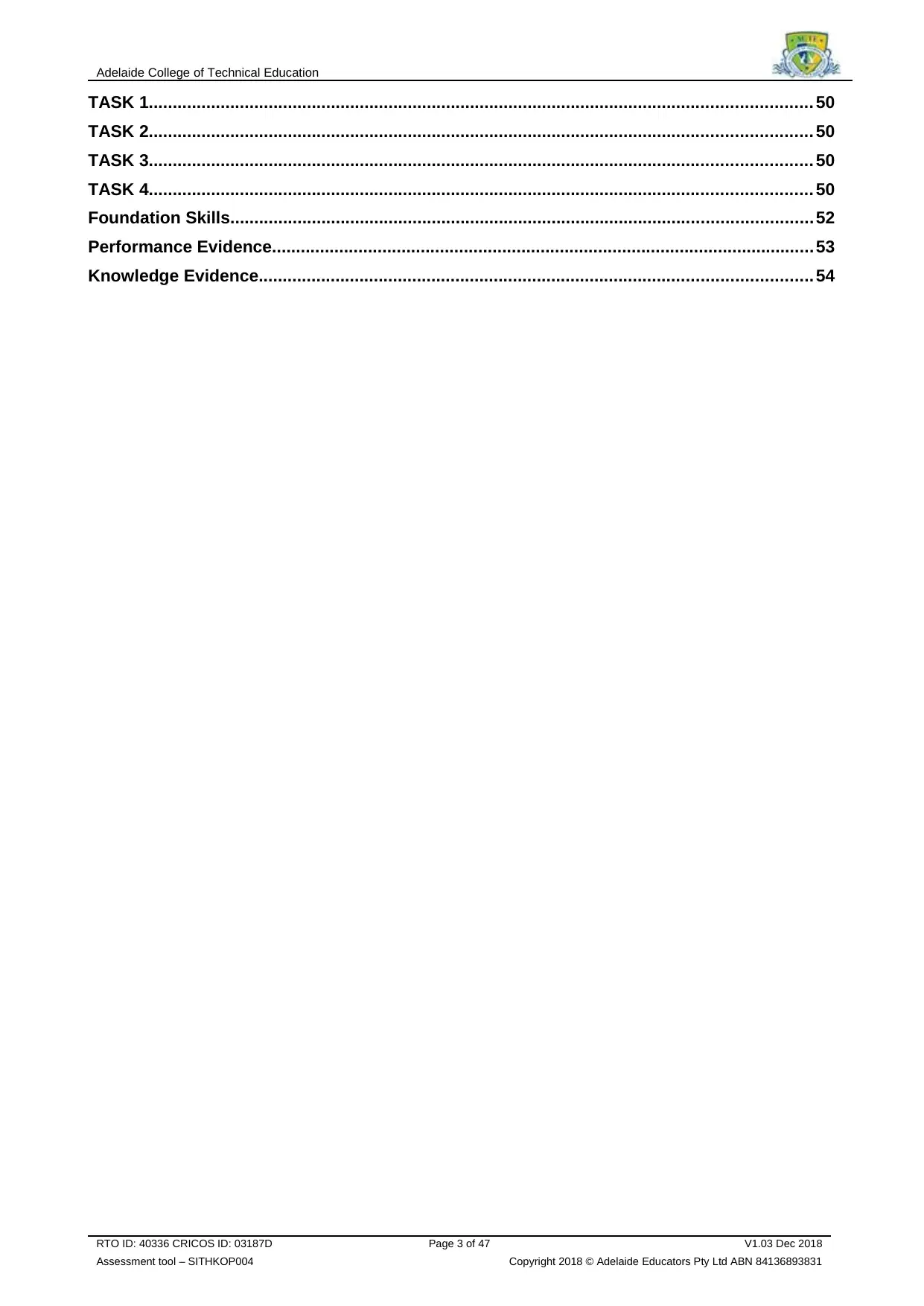
Adelaide College of Technical Education
TASK 1.......................................................................................................................................... 50
TASK 2.......................................................................................................................................... 50
TASK 3.......................................................................................................................................... 50
TASK 4.......................................................................................................................................... 50
Foundation Skills......................................................................................................................... 52
Performance Evidence................................................................................................................. 53
Knowledge Evidence................................................................................................................... 54
RTO ID: 40336 CRICOS ID: 03187D Page 3 of 47 V1.03 Dec 2018
Assessment tool – SITHKOP004 Copyright 2018 © Adelaide Educators Pty Ltd ABN 84136893831
TASK 1.......................................................................................................................................... 50
TASK 2.......................................................................................................................................... 50
TASK 3.......................................................................................................................................... 50
TASK 4.......................................................................................................................................... 50
Foundation Skills......................................................................................................................... 52
Performance Evidence................................................................................................................. 53
Knowledge Evidence................................................................................................................... 54
RTO ID: 40336 CRICOS ID: 03187D Page 3 of 47 V1.03 Dec 2018
Assessment tool – SITHKOP004 Copyright 2018 © Adelaide Educators Pty Ltd ABN 84136893831
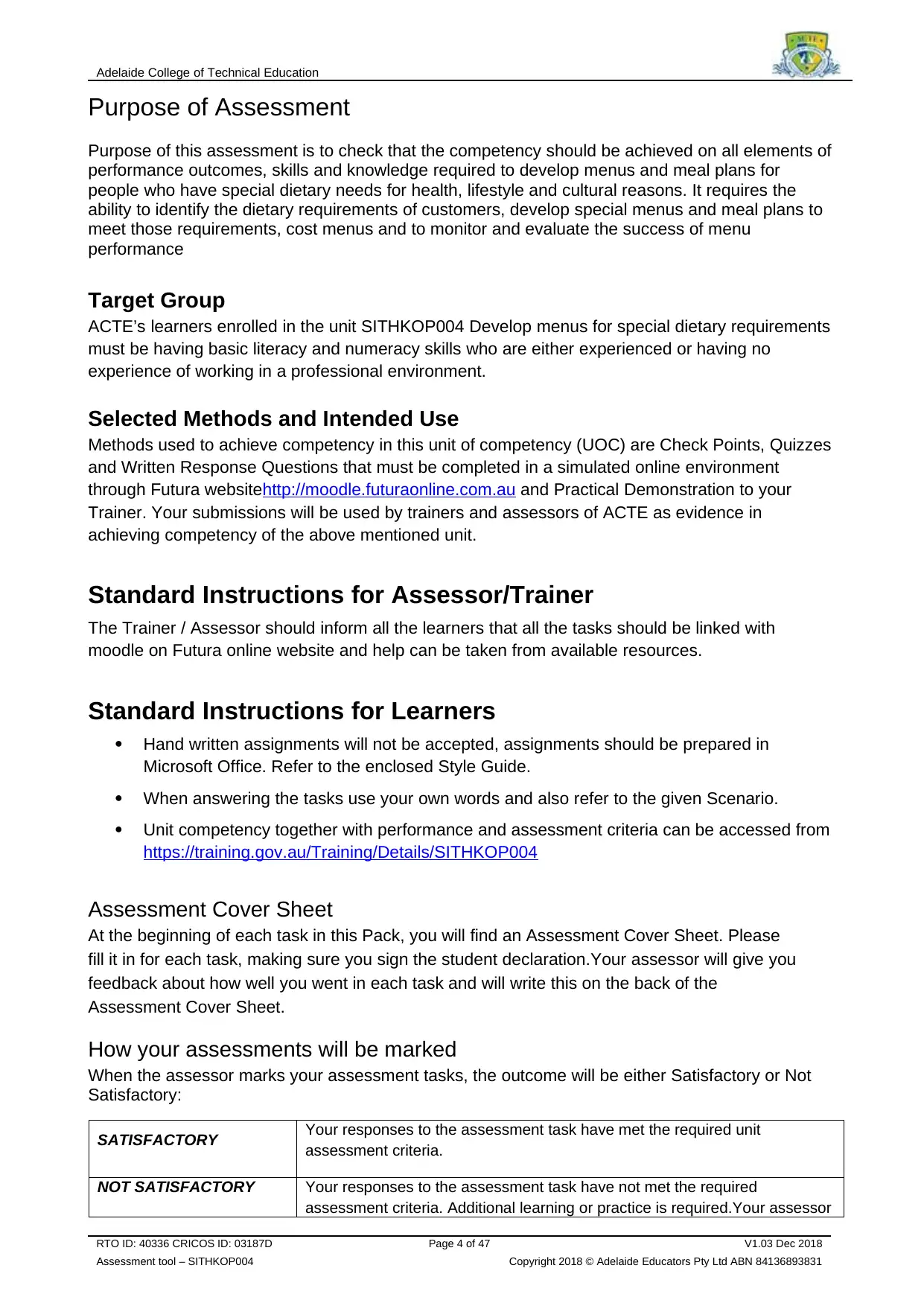
Adelaide College of Technical Education
Purpose of Assessment
Purpose of this assessment is to check that the competency should be achieved on all elements of
performance outcomes, skills and knowledge required to develop menus and meal plans for
people who have special dietary needs for health, lifestyle and cultural reasons. It requires the
ability to identify the dietary requirements of customers, develop special menus and meal plans to
meet those requirements, cost menus and to monitor and evaluate the success of menu
performance
Target Group
ACTE’s learners enrolled in the unit SITHKOP004 Develop menus for special dietary requirements
must be having basic literacy and numeracy skills who are either experienced or having no
experience of working in a professional environment.
Selected Methods and Intended Use
Methods used to achieve competency in this unit of competency (UOC) are Check Points, Quizzes
and Written Response Questions that must be completed in a simulated online environment
through Futura websitehttp://moodle.futuraonline.com.au and Practical Demonstration to your
Trainer. Your submissions will be used by trainers and assessors of ACTE as evidence in
achieving competency of the above mentioned unit.
Standard Instructions for Assessor/Trainer
The Trainer / Assessor should inform all the learners that all the tasks should be linked with
moodle on Futura online website and help can be taken from available resources.
Standard Instructions for Learners
Hand written assignments will not be accepted, assignments should be prepared in
Microsoft Office. Refer to the enclosed Style Guide.
When answering the tasks use your own words and also refer to the given Scenario.
Unit competency together with performance and assessment criteria can be accessed from
https://training.gov.au/Training/Details/SITHKOP004
Assessment Cover Sheet
At the beginning of each task in this Pack, you will find an Assessment Cover Sheet. Please
fill it in for each task, making sure you sign the student declaration.Your assessor will give you
feedback about how well you went in each task and will write this on the back of the
Assessment Cover Sheet.
How your assessments will be marked
When the assessor marks your assessment tasks, the outcome will be either Satisfactory or Not
Satisfactory:
SATISFACTORY Your responses to the assessment task have met the required unit
assessment criteria.
NOT SATISFACTORY Your responses to the assessment task have not met the required
assessment criteria. Additional learning or practice is required.Your assessor
RTO ID: 40336 CRICOS ID: 03187D Page 4 of 47 V1.03 Dec 2018
Assessment tool – SITHKOP004 Copyright 2018 © Adelaide Educators Pty Ltd ABN 84136893831
Purpose of Assessment
Purpose of this assessment is to check that the competency should be achieved on all elements of
performance outcomes, skills and knowledge required to develop menus and meal plans for
people who have special dietary needs for health, lifestyle and cultural reasons. It requires the
ability to identify the dietary requirements of customers, develop special menus and meal plans to
meet those requirements, cost menus and to monitor and evaluate the success of menu
performance
Target Group
ACTE’s learners enrolled in the unit SITHKOP004 Develop menus for special dietary requirements
must be having basic literacy and numeracy skills who are either experienced or having no
experience of working in a professional environment.
Selected Methods and Intended Use
Methods used to achieve competency in this unit of competency (UOC) are Check Points, Quizzes
and Written Response Questions that must be completed in a simulated online environment
through Futura websitehttp://moodle.futuraonline.com.au and Practical Demonstration to your
Trainer. Your submissions will be used by trainers and assessors of ACTE as evidence in
achieving competency of the above mentioned unit.
Standard Instructions for Assessor/Trainer
The Trainer / Assessor should inform all the learners that all the tasks should be linked with
moodle on Futura online website and help can be taken from available resources.
Standard Instructions for Learners
Hand written assignments will not be accepted, assignments should be prepared in
Microsoft Office. Refer to the enclosed Style Guide.
When answering the tasks use your own words and also refer to the given Scenario.
Unit competency together with performance and assessment criteria can be accessed from
https://training.gov.au/Training/Details/SITHKOP004
Assessment Cover Sheet
At the beginning of each task in this Pack, you will find an Assessment Cover Sheet. Please
fill it in for each task, making sure you sign the student declaration.Your assessor will give you
feedback about how well you went in each task and will write this on the back of the
Assessment Cover Sheet.
How your assessments will be marked
When the assessor marks your assessment tasks, the outcome will be either Satisfactory or Not
Satisfactory:
SATISFACTORY Your responses to the assessment task have met the required unit
assessment criteria.
NOT SATISFACTORY Your responses to the assessment task have not met the required
assessment criteria. Additional learning or practice is required.Your assessor
RTO ID: 40336 CRICOS ID: 03187D Page 4 of 47 V1.03 Dec 2018
Assessment tool – SITHKOP004 Copyright 2018 © Adelaide Educators Pty Ltd ABN 84136893831
Secure Best Marks with AI Grader
Need help grading? Try our AI Grader for instant feedback on your assignments.
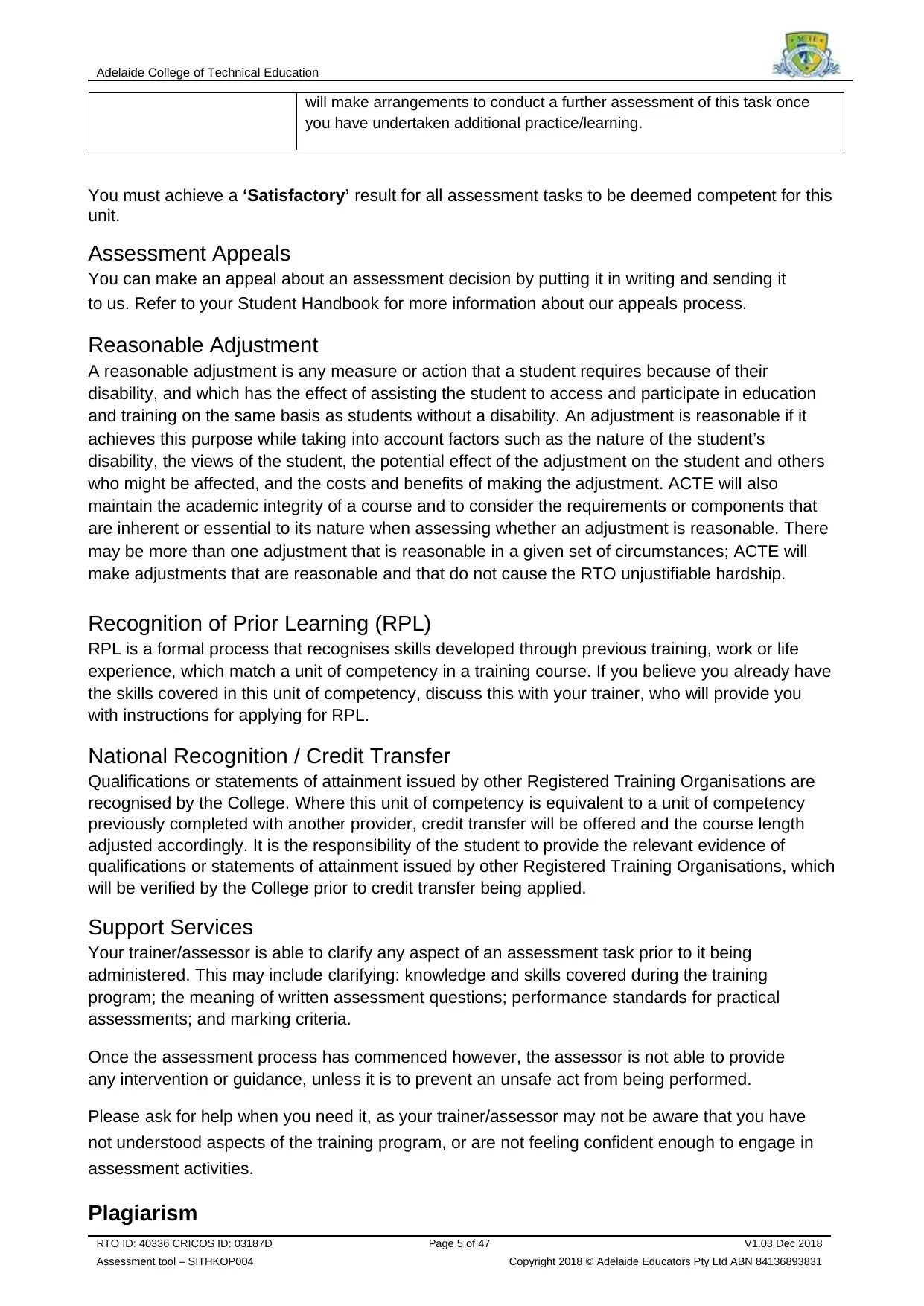
Adelaide College of Technical Education
will make arrangements to conduct a further assessment of this task once
you have undertaken additional practice/learning.
You must achieve a ‘Satisfactory’ result for all assessment tasks to be deemed competent for this
unit.
Assessment Appeals
You can make an appeal about an assessment decision by putting it in writing and sending it
to us. Refer to your Student Handbook for more information about our appeals process.
Reasonable Adjustment
A reasonable adjustment is any measure or action that a student requires because of their
disability, and which has the effect of assisting the student to access and participate in education
and training on the same basis as students without a disability. An adjustment is reasonable if it
achieves this purpose while taking into account factors such as the nature of the student’s
disability, the views of the student, the potential effect of the adjustment on the student and others
who might be affected, and the costs and benefits of making the adjustment. ACTE will also
maintain the academic integrity of a course and to consider the requirements or components that
are inherent or essential to its nature when assessing whether an adjustment is reasonable. There
may be more than one adjustment that is reasonable in a given set of circumstances; ACTE will
make adjustments that are reasonable and that do not cause the RTO unjustifiable hardship.
Recognition of Prior Learning (RPL)
RPL is a formal process that recognises skills developed through previous training, work or life
experience, which match a unit of competency in a training course. If you believe you already have
the skills covered in this unit of competency, discuss this with your trainer, who will provide you
with instructions for applying for RPL.
National Recognition / Credit Transfer
Qualifications or statements of attainment issued by other Registered Training Organisations are
recognised by the College. Where this unit of competency is equivalent to a unit of competency
previously completed with another provider, credit transfer will be offered and the course length
adjusted accordingly. It is the responsibility of the student to provide the relevant evidence of
qualifications or statements of attainment issued by other Registered Training Organisations, which
will be verified by the College prior to credit transfer being applied.
Support Services
Your trainer/assessor is able to clarify any aspect of an assessment task prior to it being
administered. This may include clarifying: knowledge and skills covered during the training
program; the meaning of written assessment questions; performance standards for practical
assessments; and marking criteria.
Once the assessment process has commenced however, the assessor is not able to provide
any intervention or guidance, unless it is to prevent an unsafe act from being performed.
Please ask for help when you need it, as your trainer/assessor may not be aware that you have
not understood aspects of the training program, or are not feeling confident enough to engage in
assessment activities.
Plagiarism
RTO ID: 40336 CRICOS ID: 03187D Page 5 of 47 V1.03 Dec 2018
Assessment tool – SITHKOP004 Copyright 2018 © Adelaide Educators Pty Ltd ABN 84136893831
will make arrangements to conduct a further assessment of this task once
you have undertaken additional practice/learning.
You must achieve a ‘Satisfactory’ result for all assessment tasks to be deemed competent for this
unit.
Assessment Appeals
You can make an appeal about an assessment decision by putting it in writing and sending it
to us. Refer to your Student Handbook for more information about our appeals process.
Reasonable Adjustment
A reasonable adjustment is any measure or action that a student requires because of their
disability, and which has the effect of assisting the student to access and participate in education
and training on the same basis as students without a disability. An adjustment is reasonable if it
achieves this purpose while taking into account factors such as the nature of the student’s
disability, the views of the student, the potential effect of the adjustment on the student and others
who might be affected, and the costs and benefits of making the adjustment. ACTE will also
maintain the academic integrity of a course and to consider the requirements or components that
are inherent or essential to its nature when assessing whether an adjustment is reasonable. There
may be more than one adjustment that is reasonable in a given set of circumstances; ACTE will
make adjustments that are reasonable and that do not cause the RTO unjustifiable hardship.
Recognition of Prior Learning (RPL)
RPL is a formal process that recognises skills developed through previous training, work or life
experience, which match a unit of competency in a training course. If you believe you already have
the skills covered in this unit of competency, discuss this with your trainer, who will provide you
with instructions for applying for RPL.
National Recognition / Credit Transfer
Qualifications or statements of attainment issued by other Registered Training Organisations are
recognised by the College. Where this unit of competency is equivalent to a unit of competency
previously completed with another provider, credit transfer will be offered and the course length
adjusted accordingly. It is the responsibility of the student to provide the relevant evidence of
qualifications or statements of attainment issued by other Registered Training Organisations, which
will be verified by the College prior to credit transfer being applied.
Support Services
Your trainer/assessor is able to clarify any aspect of an assessment task prior to it being
administered. This may include clarifying: knowledge and skills covered during the training
program; the meaning of written assessment questions; performance standards for practical
assessments; and marking criteria.
Once the assessment process has commenced however, the assessor is not able to provide
any intervention or guidance, unless it is to prevent an unsafe act from being performed.
Please ask for help when you need it, as your trainer/assessor may not be aware that you have
not understood aspects of the training program, or are not feeling confident enough to engage in
assessment activities.
Plagiarism
RTO ID: 40336 CRICOS ID: 03187D Page 5 of 47 V1.03 Dec 2018
Assessment tool – SITHKOP004 Copyright 2018 © Adelaide Educators Pty Ltd ABN 84136893831
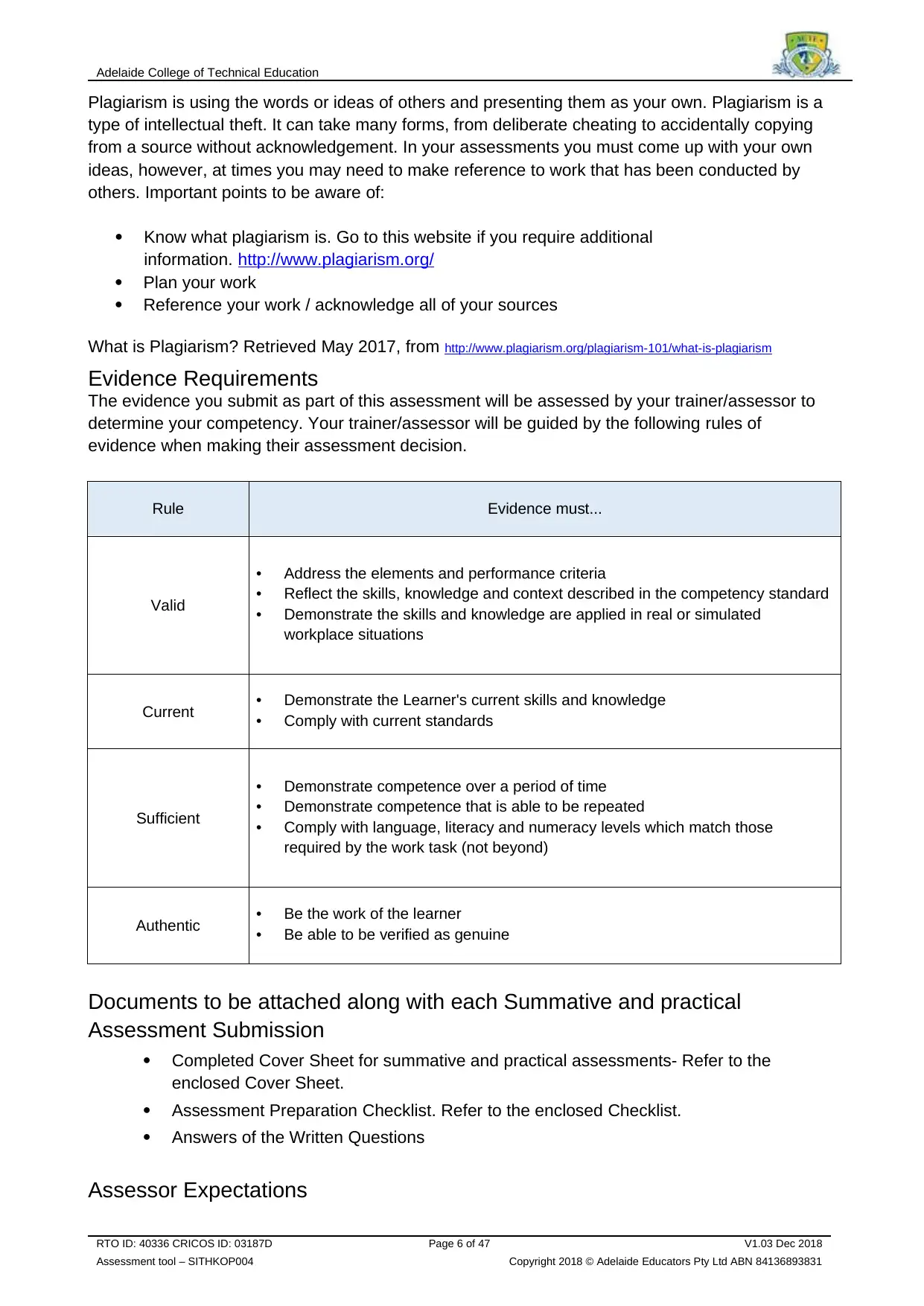
Adelaide College of Technical Education
Plagiarism is using the words or ideas of others and presenting them as your own. Plagiarism is a
type of intellectual theft. It can take many forms, from deliberate cheating to accidentally copying
from a source without acknowledgement. In your assessments you must come up with your own
ideas, however, at times you may need to make reference to work that has been conducted by
others. Important points to be aware of:
Know what plagiarism is. Go to this website if you require additional
information. http://www.plagiarism.org/
Plan your work
Reference your work / acknowledge all of your sources
What is Plagiarism? Retrieved May 2017, from http://www.plagiarism.org/plagiarism-101/what-is-plagiarism
Evidence Requirements
The evidence you submit as part of this assessment will be assessed by your trainer/assessor to
determine your competency. Your trainer/assessor will be guided by the following rules of
evidence when making their assessment decision.
Rule Evidence must...
Valid
• Address the elements and performance criteria
• Reflect the skills, knowledge and context described in the competency standard
• Demonstrate the skills and knowledge are applied in real or simulated
workplace situations
Current • Demonstrate the Learner's current skills and knowledge
• Comply with current standards
Sufficient
• Demonstrate competence over a period of time
• Demonstrate competence that is able to be repeated
• Comply with language, literacy and numeracy levels which match those
required by the work task (not beyond)
Authentic • Be the work of the learner
• Be able to be verified as genuine
Documents to be attached along with each Summative and practical
Assessment Submission
Completed Cover Sheet for summative and practical assessments- Refer to the
enclosed Cover Sheet.
Assessment Preparation Checklist. Refer to the enclosed Checklist.
Answers of the Written Questions
Assessor Expectations
RTO ID: 40336 CRICOS ID: 03187D Page 6 of 47 V1.03 Dec 2018
Assessment tool – SITHKOP004 Copyright 2018 © Adelaide Educators Pty Ltd ABN 84136893831
Plagiarism is using the words or ideas of others and presenting them as your own. Plagiarism is a
type of intellectual theft. It can take many forms, from deliberate cheating to accidentally copying
from a source without acknowledgement. In your assessments you must come up with your own
ideas, however, at times you may need to make reference to work that has been conducted by
others. Important points to be aware of:
Know what plagiarism is. Go to this website if you require additional
information. http://www.plagiarism.org/
Plan your work
Reference your work / acknowledge all of your sources
What is Plagiarism? Retrieved May 2017, from http://www.plagiarism.org/plagiarism-101/what-is-plagiarism
Evidence Requirements
The evidence you submit as part of this assessment will be assessed by your trainer/assessor to
determine your competency. Your trainer/assessor will be guided by the following rules of
evidence when making their assessment decision.
Rule Evidence must...
Valid
• Address the elements and performance criteria
• Reflect the skills, knowledge and context described in the competency standard
• Demonstrate the skills and knowledge are applied in real or simulated
workplace situations
Current • Demonstrate the Learner's current skills and knowledge
• Comply with current standards
Sufficient
• Demonstrate competence over a period of time
• Demonstrate competence that is able to be repeated
• Comply with language, literacy and numeracy levels which match those
required by the work task (not beyond)
Authentic • Be the work of the learner
• Be able to be verified as genuine
Documents to be attached along with each Summative and practical
Assessment Submission
Completed Cover Sheet for summative and practical assessments- Refer to the
enclosed Cover Sheet.
Assessment Preparation Checklist. Refer to the enclosed Checklist.
Answers of the Written Questions
Assessor Expectations
RTO ID: 40336 CRICOS ID: 03187D Page 6 of 47 V1.03 Dec 2018
Assessment tool – SITHKOP004 Copyright 2018 © Adelaide Educators Pty Ltd ABN 84136893831
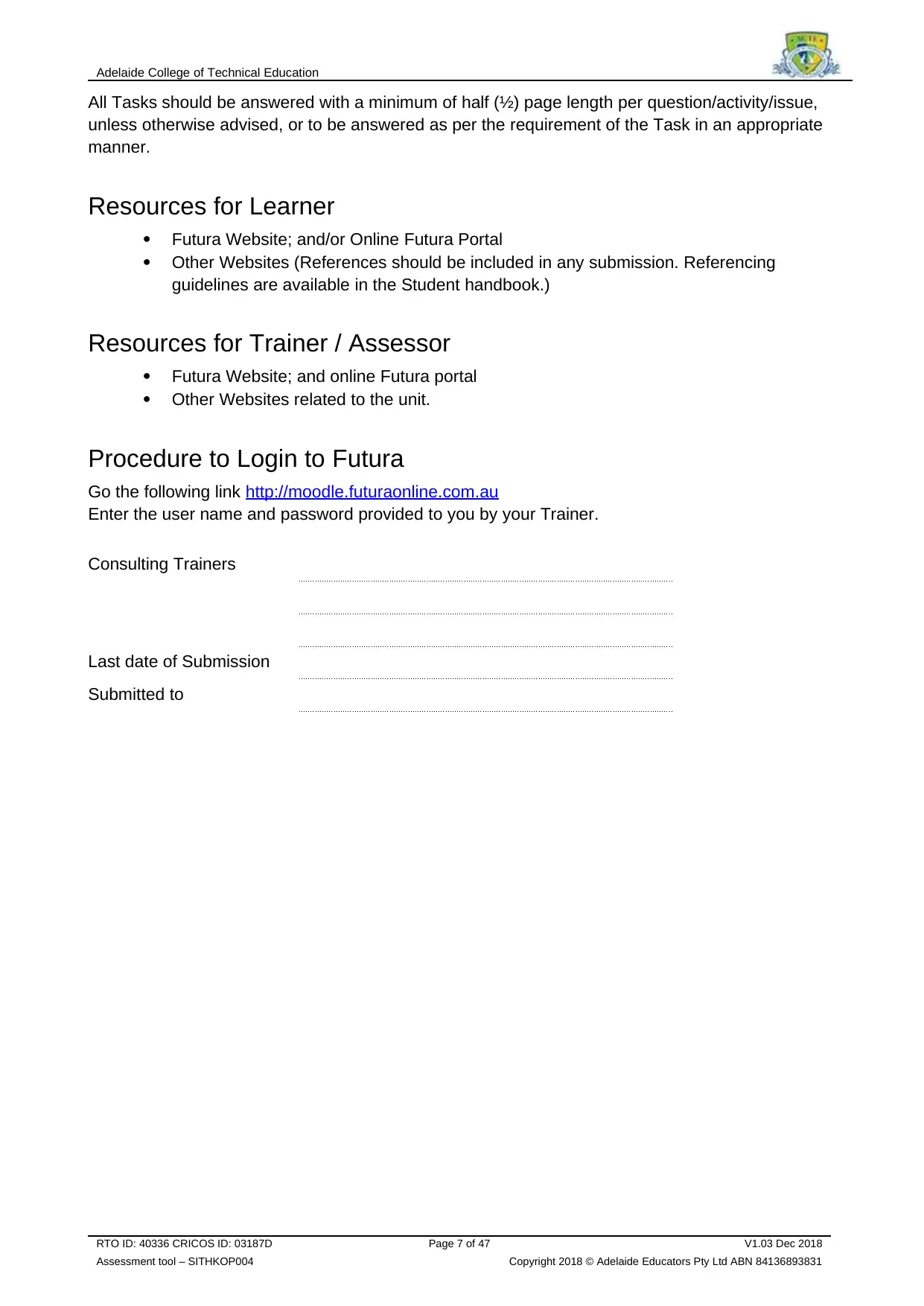
Adelaide College of Technical Education
All Tasks should be answered with a minimum of half (½) page length per question/activity/issue,
unless otherwise advised, or to be answered as per the requirement of the Task in an appropriate
manner.
Resources for Learner
Futura Website; and/or Online Futura Portal
Other Websites (References should be included in any submission. Referencing
guidelines are available in the Student handbook.)
Resources for Trainer / Assessor
Futura Website; and online Futura portal
Other Websites related to the unit.
Procedure to Login to Futura
Go the following link http://moodle.futuraonline.com.au
Enter the user name and password provided to you by your Trainer.
Consulting Trainers
Last date of Submission
Submitted to
RTO ID: 40336 CRICOS ID: 03187D Page 7 of 47 V1.03 Dec 2018
Assessment tool – SITHKOP004 Copyright 2018 © Adelaide Educators Pty Ltd ABN 84136893831
All Tasks should be answered with a minimum of half (½) page length per question/activity/issue,
unless otherwise advised, or to be answered as per the requirement of the Task in an appropriate
manner.
Resources for Learner
Futura Website; and/or Online Futura Portal
Other Websites (References should be included in any submission. Referencing
guidelines are available in the Student handbook.)
Resources for Trainer / Assessor
Futura Website; and online Futura portal
Other Websites related to the unit.
Procedure to Login to Futura
Go the following link http://moodle.futuraonline.com.au
Enter the user name and password provided to you by your Trainer.
Consulting Trainers
Last date of Submission
Submitted to
RTO ID: 40336 CRICOS ID: 03187D Page 7 of 47 V1.03 Dec 2018
Assessment tool – SITHKOP004 Copyright 2018 © Adelaide Educators Pty Ltd ABN 84136893831
Paraphrase This Document
Need a fresh take? Get an instant paraphrase of this document with our AI Paraphraser
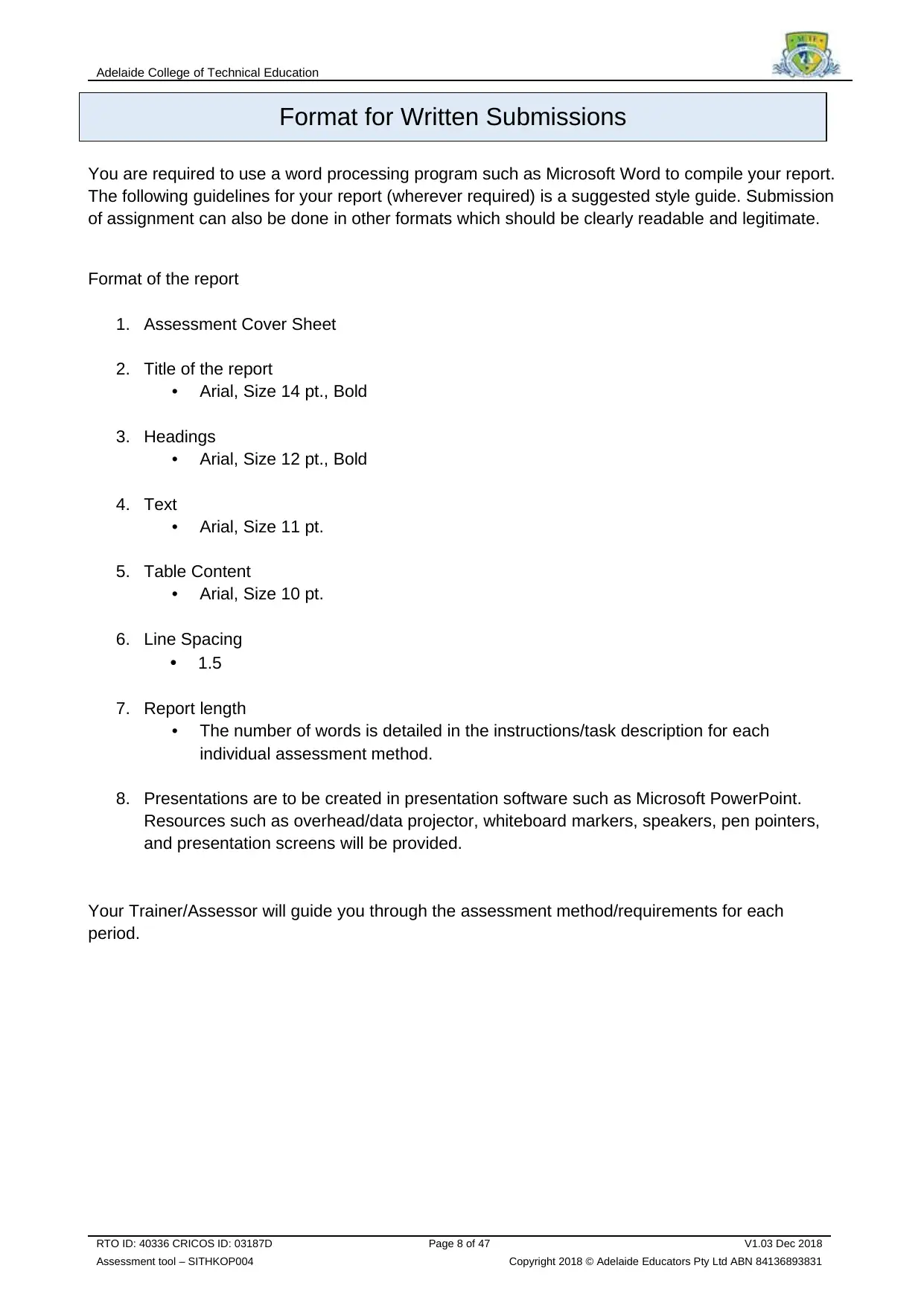
Adelaide College of Technical Education
Format for Written Submissions
You are required to use a word processing program such as Microsoft Word to compile your report.
The following guidelines for your report (wherever required) is a suggested style guide. Submission
of assignment can also be done in other formats which should be clearly readable and legitimate.
Format of the report
1. Assessment Cover Sheet
2. Title of the report
• Arial, Size 14 pt., Bold
3. Headings
• Arial, Size 12 pt., Bold
4. Text
• Arial, Size 11 pt.
5. Table Content
• Arial, Size 10 pt.
6. Line Spacing
• 1.5
7. Report length
• The number of words is detailed in the instructions/task description for each
individual assessment method.
8. Presentations are to be created in presentation software such as Microsoft PowerPoint.
Resources such as overhead/data projector, whiteboard markers, speakers, pen pointers,
and presentation screens will be provided.
Your Trainer/Assessor will guide you through the assessment method/requirements for each
period.
RTO ID: 40336 CRICOS ID: 03187D Page 8 of 47 V1.03 Dec 2018
Assessment tool – SITHKOP004 Copyright 2018 © Adelaide Educators Pty Ltd ABN 84136893831
Format for Written Submissions
You are required to use a word processing program such as Microsoft Word to compile your report.
The following guidelines for your report (wherever required) is a suggested style guide. Submission
of assignment can also be done in other formats which should be clearly readable and legitimate.
Format of the report
1. Assessment Cover Sheet
2. Title of the report
• Arial, Size 14 pt., Bold
3. Headings
• Arial, Size 12 pt., Bold
4. Text
• Arial, Size 11 pt.
5. Table Content
• Arial, Size 10 pt.
6. Line Spacing
• 1.5
7. Report length
• The number of words is detailed in the instructions/task description for each
individual assessment method.
8. Presentations are to be created in presentation software such as Microsoft PowerPoint.
Resources such as overhead/data projector, whiteboard markers, speakers, pen pointers,
and presentation screens will be provided.
Your Trainer/Assessor will guide you through the assessment method/requirements for each
period.
RTO ID: 40336 CRICOS ID: 03187D Page 8 of 47 V1.03 Dec 2018
Assessment tool – SITHKOP004 Copyright 2018 © Adelaide Educators Pty Ltd ABN 84136893831
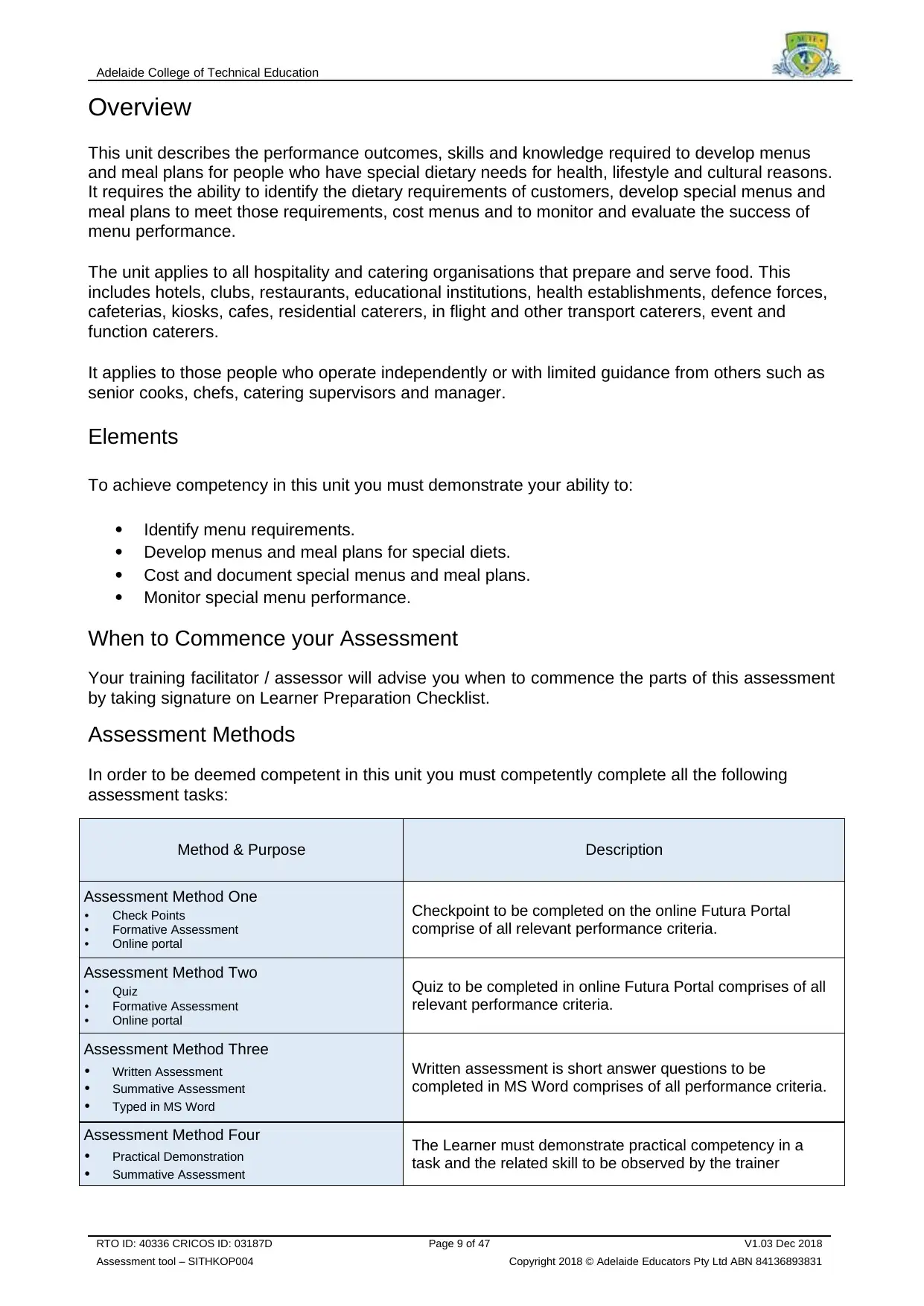
Adelaide College of Technical Education
Overview
This unit describes the performance outcomes, skills and knowledge required to develop menus
and meal plans for people who have special dietary needs for health, lifestyle and cultural reasons.
It requires the ability to identify the dietary requirements of customers, develop special menus and
meal plans to meet those requirements, cost menus and to monitor and evaluate the success of
menu performance.
The unit applies to all hospitality and catering organisations that prepare and serve food. This
includes hotels, clubs, restaurants, educational institutions, health establishments, defence forces,
cafeterias, kiosks, cafes, residential caterers, in flight and other transport caterers, event and
function caterers.
It applies to those people who operate independently or with limited guidance from others such as
senior cooks, chefs, catering supervisors and manager.
Elements
To achieve competency in this unit you must demonstrate your ability to:
Identify menu requirements.
Develop menus and meal plans for special diets.
Cost and document special menus and meal plans.
Monitor special menu performance.
When to Commence your Assessment
Your training facilitator / assessor will advise you when to commence the parts of this assessment
by taking signature on Learner Preparation Checklist.
Assessment Methods
In order to be deemed competent in this unit you must competently complete all the following
assessment tasks:
Method & Purpose Description
Assessment Method One
• Check Points
• Formative Assessment
• Online portal
Checkpoint to be completed on the online Futura Portal
comprise of all relevant performance criteria.
Assessment Method Two
• Quiz
• Formative Assessment
• Online portal
Quiz to be completed in online Futura Portal comprises of all
relevant performance criteria.
Assessment Method Three
• Written Assessment
• Summative Assessment
• Typed in MS Word
Written assessment is short answer questions to be
completed in MS Word comprises of all performance criteria.
Assessment Method Four
• Practical Demonstration
• Summative Assessment
The Learner must demonstrate practical competency in a
task and the related skill to be observed by the trainer
RTO ID: 40336 CRICOS ID: 03187D Page 9 of 47 V1.03 Dec 2018
Assessment tool – SITHKOP004 Copyright 2018 © Adelaide Educators Pty Ltd ABN 84136893831
Overview
This unit describes the performance outcomes, skills and knowledge required to develop menus
and meal plans for people who have special dietary needs for health, lifestyle and cultural reasons.
It requires the ability to identify the dietary requirements of customers, develop special menus and
meal plans to meet those requirements, cost menus and to monitor and evaluate the success of
menu performance.
The unit applies to all hospitality and catering organisations that prepare and serve food. This
includes hotels, clubs, restaurants, educational institutions, health establishments, defence forces,
cafeterias, kiosks, cafes, residential caterers, in flight and other transport caterers, event and
function caterers.
It applies to those people who operate independently or with limited guidance from others such as
senior cooks, chefs, catering supervisors and manager.
Elements
To achieve competency in this unit you must demonstrate your ability to:
Identify menu requirements.
Develop menus and meal plans for special diets.
Cost and document special menus and meal plans.
Monitor special menu performance.
When to Commence your Assessment
Your training facilitator / assessor will advise you when to commence the parts of this assessment
by taking signature on Learner Preparation Checklist.
Assessment Methods
In order to be deemed competent in this unit you must competently complete all the following
assessment tasks:
Method & Purpose Description
Assessment Method One
• Check Points
• Formative Assessment
• Online portal
Checkpoint to be completed on the online Futura Portal
comprise of all relevant performance criteria.
Assessment Method Two
• Quiz
• Formative Assessment
• Online portal
Quiz to be completed in online Futura Portal comprises of all
relevant performance criteria.
Assessment Method Three
• Written Assessment
• Summative Assessment
• Typed in MS Word
Written assessment is short answer questions to be
completed in MS Word comprises of all performance criteria.
Assessment Method Four
• Practical Demonstration
• Summative Assessment
The Learner must demonstrate practical competency in a
task and the related skill to be observed by the trainer
RTO ID: 40336 CRICOS ID: 03187D Page 9 of 47 V1.03 Dec 2018
Assessment tool – SITHKOP004 Copyright 2018 © Adelaide Educators Pty Ltd ABN 84136893831
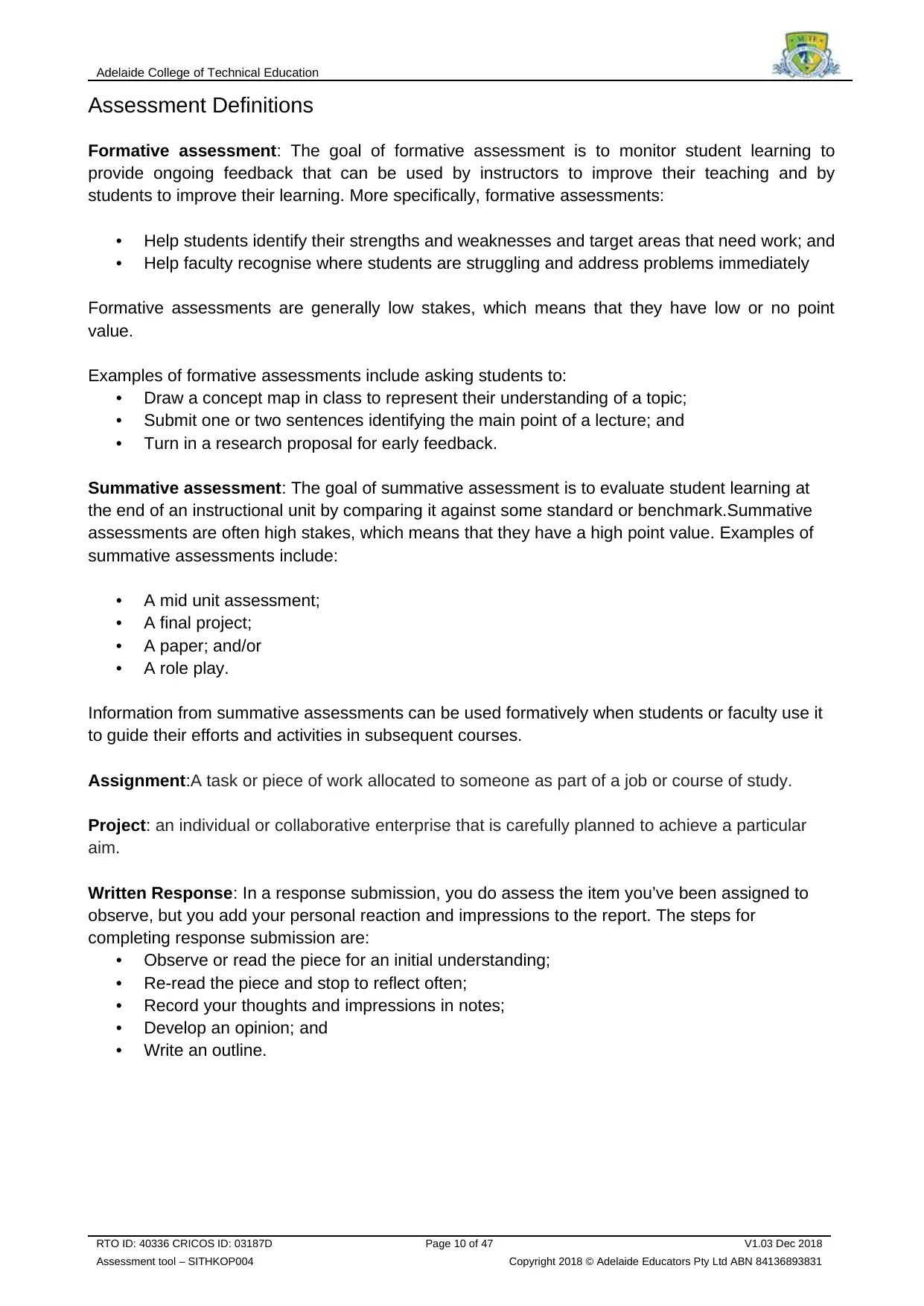
Adelaide College of Technical Education
Assessment Definitions
Formative assessment: The goal of formative assessment is to monitor student learning to
provide ongoing feedback that can be used by instructors to improve their teaching and by
students to improve their learning. More specifically, formative assessments:
• Help students identify their strengths and weaknesses and target areas that need work; and
• Help faculty recognise where students are struggling and address problems immediately
Formative assessments are generally low stakes, which means that they have low or no point
value.
Examples of formative assessments include asking students to:
• Draw a concept map in class to represent their understanding of a topic;
• Submit one or two sentences identifying the main point of a lecture; and
• Turn in a research proposal for early feedback.
Summative assessment: The goal of summative assessment is to evaluate student learning at
the end of an instructional unit by comparing it against some standard or benchmark.Summative
assessments are often high stakes, which means that they have a high point value. Examples of
summative assessments include:
• A mid unit assessment;
• A final project;
• A paper; and/or
• A role play.
Information from summative assessments can be used formatively when students or faculty use it
to guide their efforts and activities in subsequent courses.
Assignment:A task or piece of work allocated to someone as part of a job or course of study.
Project: an individual or collaborative enterprise that is carefully planned to achieve a particular
aim.
Written Response: In a response submission, you do assess the item you’ve been assigned to
observe, but you add your personal reaction and impressions to the report. The steps for
completing response submission are:
• Observe or read the piece for an initial understanding;
• Re-read the piece and stop to reflect often;
• Record your thoughts and impressions in notes;
• Develop an opinion; and
• Write an outline.
RTO ID: 40336 CRICOS ID: 03187D Page 10 of 47 V1.03 Dec 2018
Assessment tool – SITHKOP004 Copyright 2018 © Adelaide Educators Pty Ltd ABN 84136893831
Assessment Definitions
Formative assessment: The goal of formative assessment is to monitor student learning to
provide ongoing feedback that can be used by instructors to improve their teaching and by
students to improve their learning. More specifically, formative assessments:
• Help students identify their strengths and weaknesses and target areas that need work; and
• Help faculty recognise where students are struggling and address problems immediately
Formative assessments are generally low stakes, which means that they have low or no point
value.
Examples of formative assessments include asking students to:
• Draw a concept map in class to represent their understanding of a topic;
• Submit one or two sentences identifying the main point of a lecture; and
• Turn in a research proposal for early feedback.
Summative assessment: The goal of summative assessment is to evaluate student learning at
the end of an instructional unit by comparing it against some standard or benchmark.Summative
assessments are often high stakes, which means that they have a high point value. Examples of
summative assessments include:
• A mid unit assessment;
• A final project;
• A paper; and/or
• A role play.
Information from summative assessments can be used formatively when students or faculty use it
to guide their efforts and activities in subsequent courses.
Assignment:A task or piece of work allocated to someone as part of a job or course of study.
Project: an individual or collaborative enterprise that is carefully planned to achieve a particular
aim.
Written Response: In a response submission, you do assess the item you’ve been assigned to
observe, but you add your personal reaction and impressions to the report. The steps for
completing response submission are:
• Observe or read the piece for an initial understanding;
• Re-read the piece and stop to reflect often;
• Record your thoughts and impressions in notes;
• Develop an opinion; and
• Write an outline.
RTO ID: 40336 CRICOS ID: 03187D Page 10 of 47 V1.03 Dec 2018
Assessment tool – SITHKOP004 Copyright 2018 © Adelaide Educators Pty Ltd ABN 84136893831
Secure Best Marks with AI Grader
Need help grading? Try our AI Grader for instant feedback on your assignments.
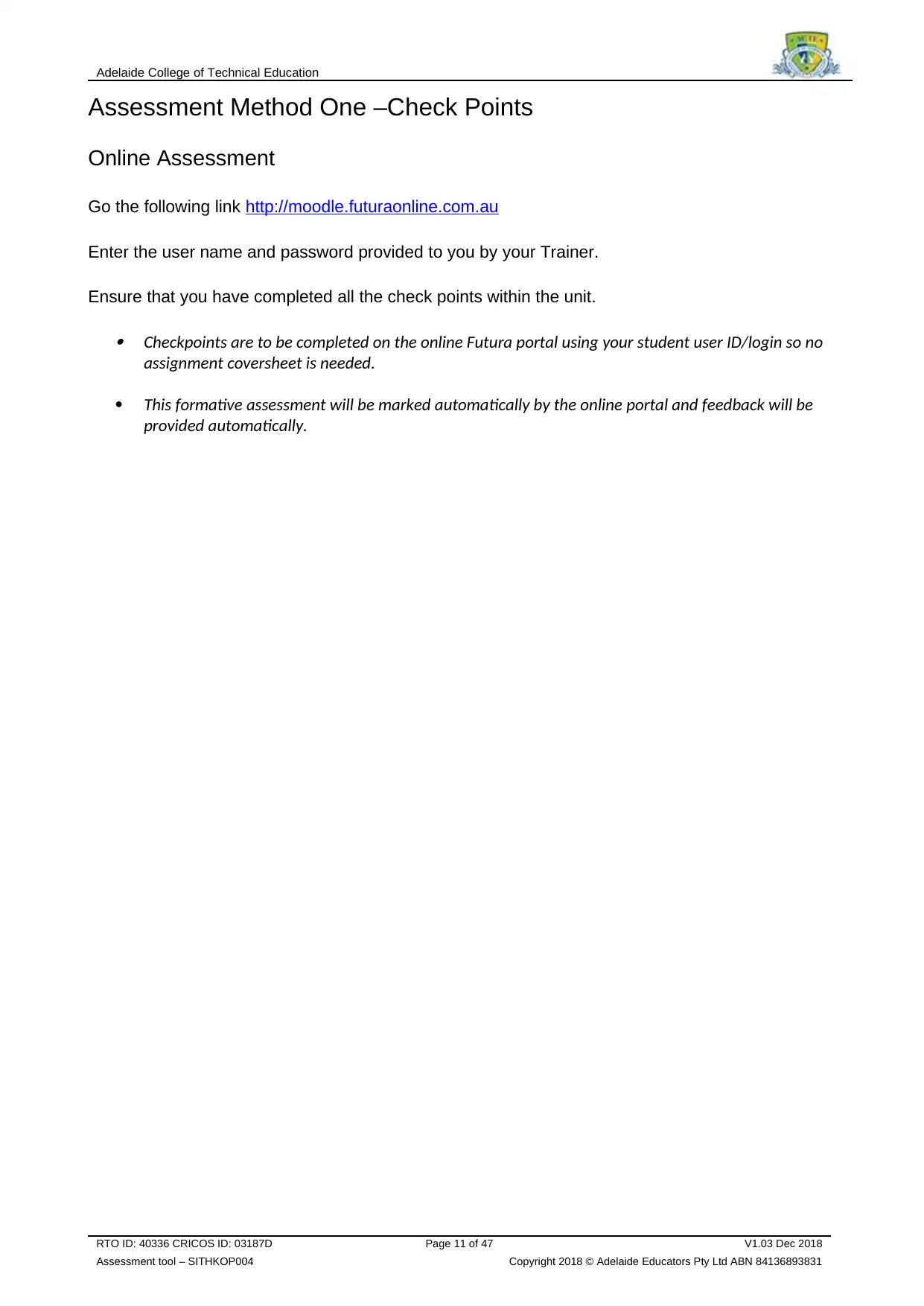
Adelaide College of Technical Education
Assessment Method One –Check Points
Online Assessment
Go the following link http://moodle.futuraonline.com.au
Enter the user name and password provided to you by your Trainer.
Ensure that you have completed all the check points within the unit.
Checkpoints are to be completed on the online Futura portal using your student user ID/login so no
assignment coversheet is needed.
This formative assessment will be marked automatically by the online portal and feedback will be
provided automatically.
RTO ID: 40336 CRICOS ID: 03187D Page 11 of 47 V1.03 Dec 2018
Assessment tool – SITHKOP004 Copyright 2018 © Adelaide Educators Pty Ltd ABN 84136893831
Assessment Method One –Check Points
Online Assessment
Go the following link http://moodle.futuraonline.com.au
Enter the user name and password provided to you by your Trainer.
Ensure that you have completed all the check points within the unit.
Checkpoints are to be completed on the online Futura portal using your student user ID/login so no
assignment coversheet is needed.
This formative assessment will be marked automatically by the online portal and feedback will be
provided automatically.
RTO ID: 40336 CRICOS ID: 03187D Page 11 of 47 V1.03 Dec 2018
Assessment tool – SITHKOP004 Copyright 2018 © Adelaide Educators Pty Ltd ABN 84136893831
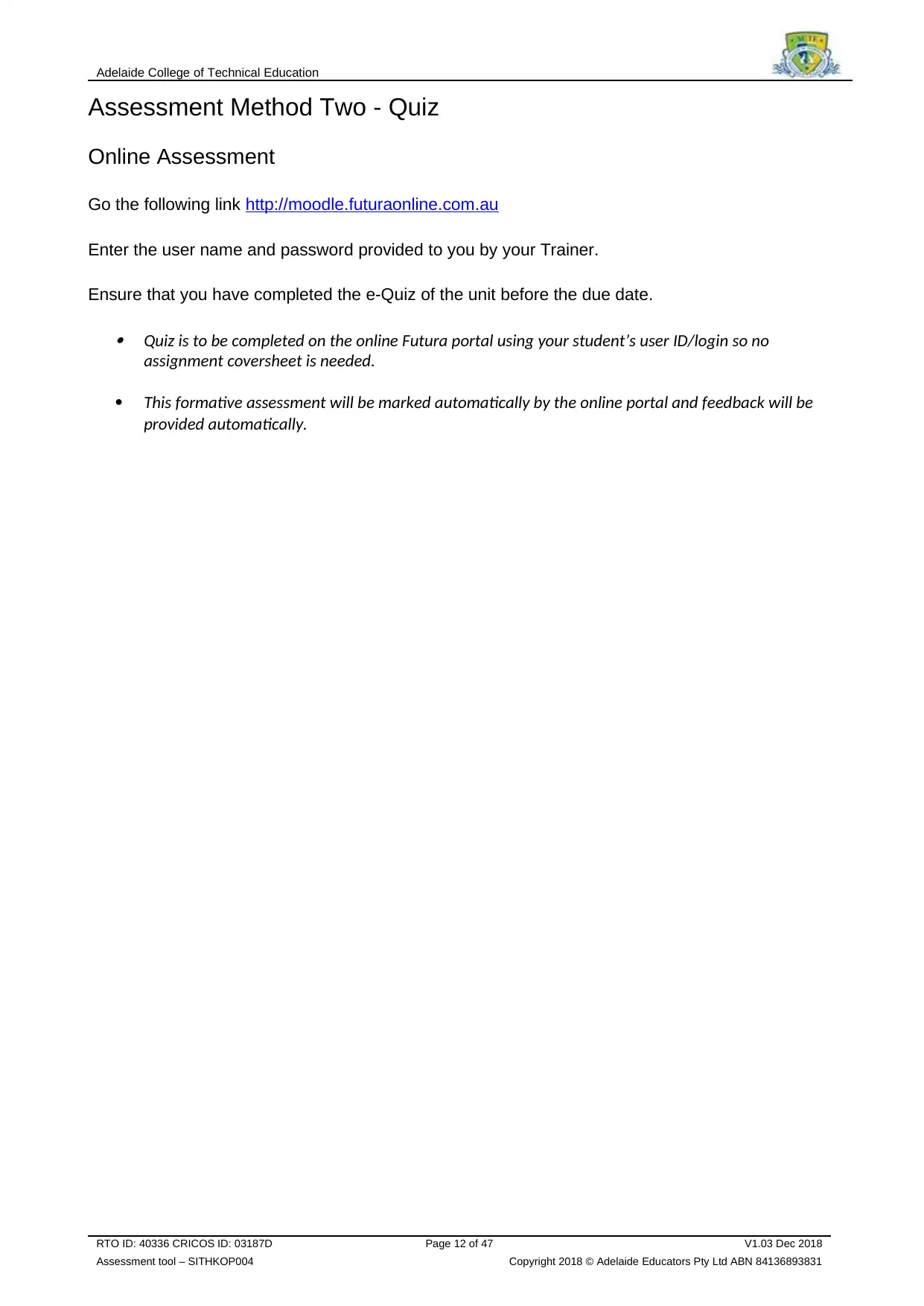
Adelaide College of Technical Education
Assessment Method Two - Quiz
Online Assessment
Go the following link http://moodle.futuraonline.com.au
Enter the user name and password provided to you by your Trainer.
Ensure that you have completed the e-Quiz of the unit before the due date.
Quiz is to be completed on the online Futura portal using your student’s user ID/login so no
assignment coversheet is needed.
This formative assessment will be marked automatically by the online portal and feedback will be
provided automatically.
RTO ID: 40336 CRICOS ID: 03187D Page 12 of 47 V1.03 Dec 2018
Assessment tool – SITHKOP004 Copyright 2018 © Adelaide Educators Pty Ltd ABN 84136893831
Assessment Method Two - Quiz
Online Assessment
Go the following link http://moodle.futuraonline.com.au
Enter the user name and password provided to you by your Trainer.
Ensure that you have completed the e-Quiz of the unit before the due date.
Quiz is to be completed on the online Futura portal using your student’s user ID/login so no
assignment coversheet is needed.
This formative assessment will be marked automatically by the online portal and feedback will be
provided automatically.
RTO ID: 40336 CRICOS ID: 03187D Page 12 of 47 V1.03 Dec 2018
Assessment tool – SITHKOP004 Copyright 2018 © Adelaide Educators Pty Ltd ABN 84136893831
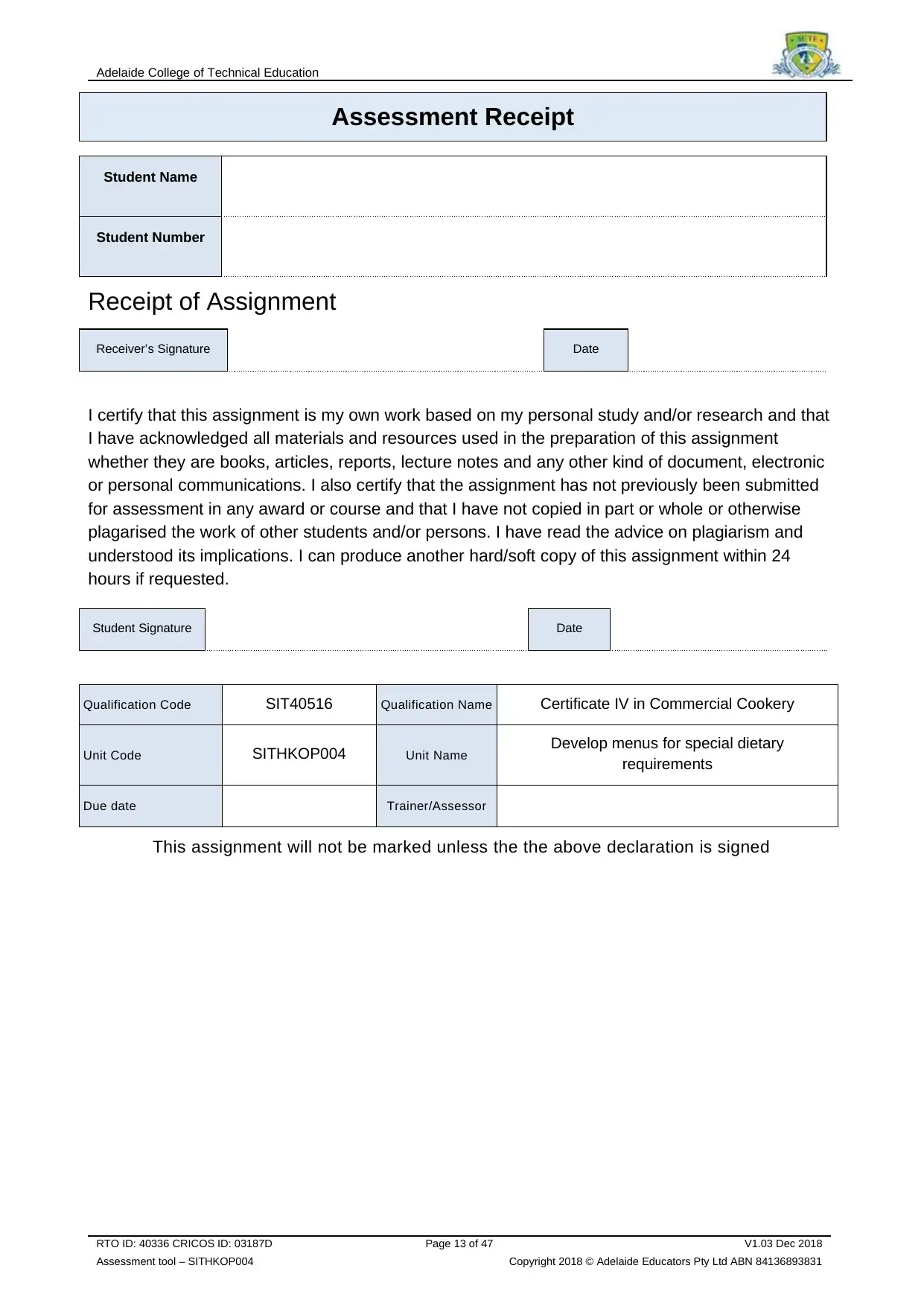
Adelaide College of Technical Education
Assessment Receipt
Student Name
Student Number
Receipt of Assignment
Receiver’s Signature Date
I certify that this assignment is my own work based on my personal study and/or research and that
I have acknowledged all materials and resources used in the preparation of this assignment
whether they are books, articles, reports, lecture notes and any other kind of document, electronic
or personal communications. I also certify that the assignment has not previously been submitted
for assessment in any award or course and that I have not copied in part or whole or otherwise
plagarised the work of other students and/or persons. I have read the advice on plagiarism and
understood its implications. I can produce another hard/soft copy of this assignment within 24
hours if requested.
Student Signature Date
Qualification Code SIT40516 Qualification Name Certificate IV in Commercial Cookery
Unit Code SITHKOP004 Unit Name Develop menus for special dietary
requirements
Due date Trainer/Assessor
This assignment will not be marked unless the the above declaration is signed
RTO ID: 40336 CRICOS ID: 03187D Page 13 of 47 V1.03 Dec 2018
Assessment tool – SITHKOP004 Copyright 2018 © Adelaide Educators Pty Ltd ABN 84136893831
Assessment Receipt
Student Name
Student Number
Receipt of Assignment
Receiver’s Signature Date
I certify that this assignment is my own work based on my personal study and/or research and that
I have acknowledged all materials and resources used in the preparation of this assignment
whether they are books, articles, reports, lecture notes and any other kind of document, electronic
or personal communications. I also certify that the assignment has not previously been submitted
for assessment in any award or course and that I have not copied in part or whole or otherwise
plagarised the work of other students and/or persons. I have read the advice on plagiarism and
understood its implications. I can produce another hard/soft copy of this assignment within 24
hours if requested.
Student Signature Date
Qualification Code SIT40516 Qualification Name Certificate IV in Commercial Cookery
Unit Code SITHKOP004 Unit Name Develop menus for special dietary
requirements
Due date Trainer/Assessor
This assignment will not be marked unless the the above declaration is signed
RTO ID: 40336 CRICOS ID: 03187D Page 13 of 47 V1.03 Dec 2018
Assessment tool – SITHKOP004 Copyright 2018 © Adelaide Educators Pty Ltd ABN 84136893831
Paraphrase This Document
Need a fresh take? Get an instant paraphrase of this document with our AI Paraphraser
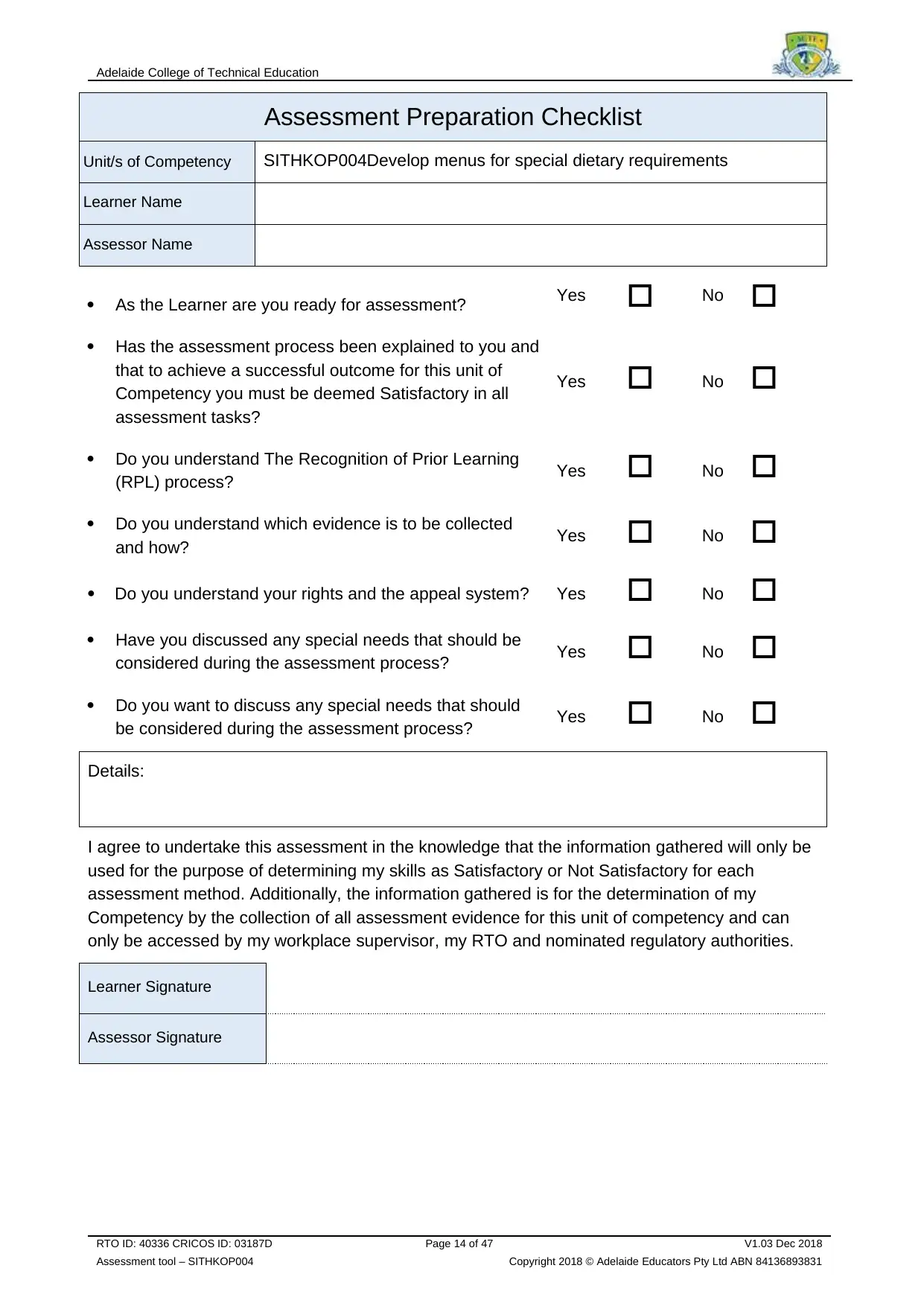
Adelaide College of Technical Education
Assessment Preparation Checklist
Unit/s of Competency SITHKOP004Develop menus for special dietary requirements
Learner Name
Assessor Name
As the Learner are you ready for assessment? Yes No
Has the assessment process been explained to you and
that to achieve a successful outcome for this unit of
Competency you must be deemed Satisfactory in all
assessment tasks?
Yes No
Do you understand The Recognition of Prior Learning
(RPL) process? Yes No
Do you understand which evidence is to be collected
and how? Yes No
Do you understand your rights and the appeal system? Yes No
Have you discussed any special needs that should be
considered during the assessment process? Yes No
Do you want to discuss any special needs that should
be considered during the assessment process? Yes No
Details:
I agree to undertake this assessment in the knowledge that the information gathered will only be
used for the purpose of determining my skills as Satisfactory or Not Satisfactory for each
assessment method. Additionally, the information gathered is for the determination of my
Competency by the collection of all assessment evidence for this unit of competency and can
only be accessed by my workplace supervisor, my RTO and nominated regulatory authorities.
Learner Signature
Assessor Signature
RTO ID: 40336 CRICOS ID: 03187D Page 14 of 47 V1.03 Dec 2018
Assessment tool – SITHKOP004 Copyright 2018 © Adelaide Educators Pty Ltd ABN 84136893831
Assessment Preparation Checklist
Unit/s of Competency SITHKOP004Develop menus for special dietary requirements
Learner Name
Assessor Name
As the Learner are you ready for assessment? Yes No
Has the assessment process been explained to you and
that to achieve a successful outcome for this unit of
Competency you must be deemed Satisfactory in all
assessment tasks?
Yes No
Do you understand The Recognition of Prior Learning
(RPL) process? Yes No
Do you understand which evidence is to be collected
and how? Yes No
Do you understand your rights and the appeal system? Yes No
Have you discussed any special needs that should be
considered during the assessment process? Yes No
Do you want to discuss any special needs that should
be considered during the assessment process? Yes No
Details:
I agree to undertake this assessment in the knowledge that the information gathered will only be
used for the purpose of determining my skills as Satisfactory or Not Satisfactory for each
assessment method. Additionally, the information gathered is for the determination of my
Competency by the collection of all assessment evidence for this unit of competency and can
only be accessed by my workplace supervisor, my RTO and nominated regulatory authorities.
Learner Signature
Assessor Signature
RTO ID: 40336 CRICOS ID: 03187D Page 14 of 47 V1.03 Dec 2018
Assessment tool – SITHKOP004 Copyright 2018 © Adelaide Educators Pty Ltd ABN 84136893831
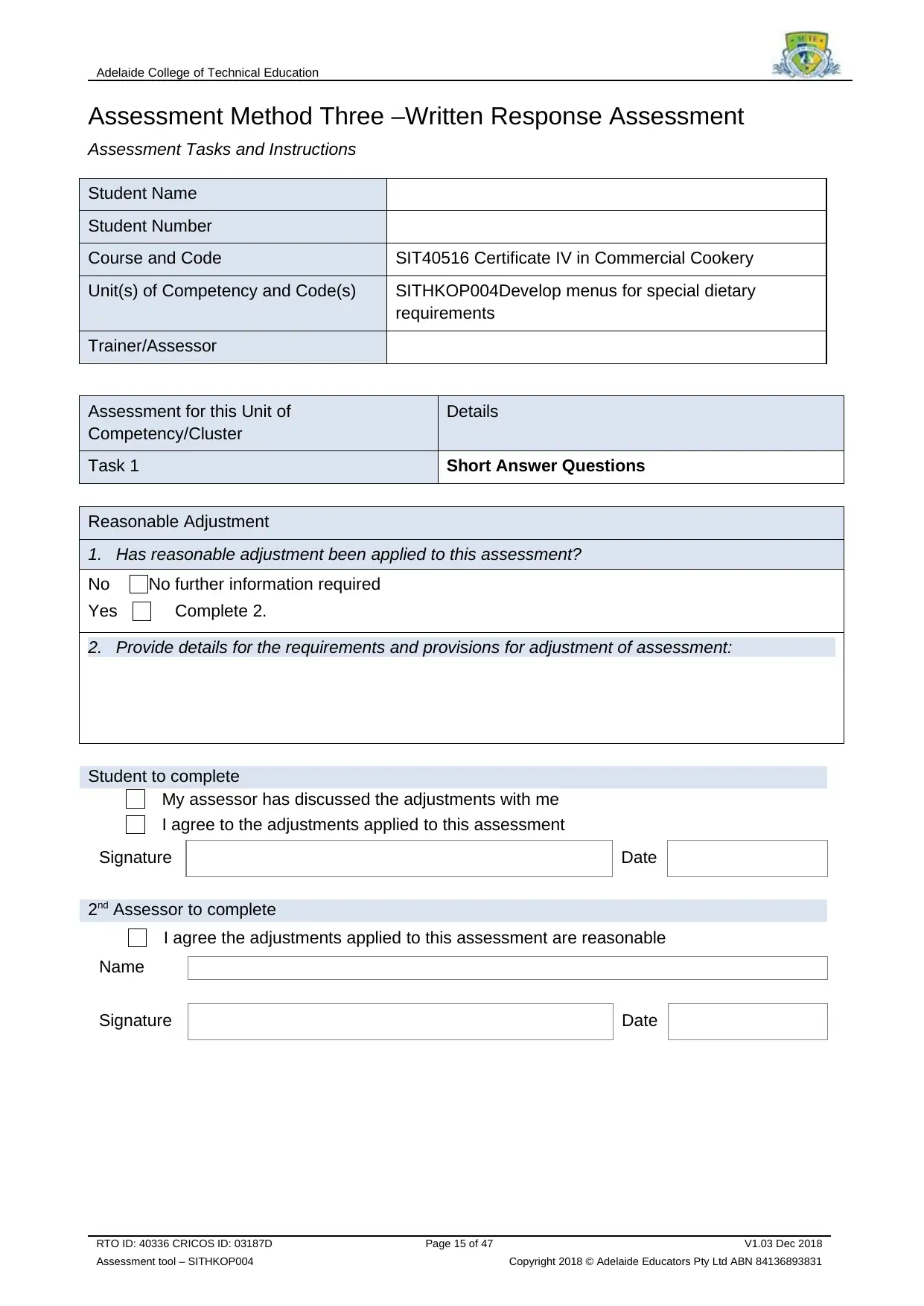
Adelaide College of Technical Education
Assessment Method Three –Written Response Assessment
Assessment Tasks and Instructions
Student Name
Student Number
Course and Code SIT40516 Certificate IV in Commercial Cookery
Unit(s) of Competency and Code(s) SITHKOP004Develop menus for special dietary
requirements
Trainer/Assessor
Assessment for this Unit of
Competency/Cluster
Details
Task 1 Short Answer Questions
Reasonable Adjustment
1. Has reasonable adjustment been applied to this assessment?
No No further information required
Yes Complete 2.
2. Provide details for the requirements and provisions for adjustment of assessment:
Student to complete
My assessor has discussed the adjustments with me
I agree to the adjustments applied to this assessment
Signature Date
2nd Assessor to complete
I agree the adjustments applied to this assessment are reasonable
Name
Signature Date
RTO ID: 40336 CRICOS ID: 03187D Page 15 of 47 V1.03 Dec 2018
Assessment tool – SITHKOP004 Copyright 2018 © Adelaide Educators Pty Ltd ABN 84136893831
Assessment Method Three –Written Response Assessment
Assessment Tasks and Instructions
Student Name
Student Number
Course and Code SIT40516 Certificate IV in Commercial Cookery
Unit(s) of Competency and Code(s) SITHKOP004Develop menus for special dietary
requirements
Trainer/Assessor
Assessment for this Unit of
Competency/Cluster
Details
Task 1 Short Answer Questions
Reasonable Adjustment
1. Has reasonable adjustment been applied to this assessment?
No No further information required
Yes Complete 2.
2. Provide details for the requirements and provisions for adjustment of assessment:
Student to complete
My assessor has discussed the adjustments with me
I agree to the adjustments applied to this assessment
Signature Date
2nd Assessor to complete
I agree the adjustments applied to this assessment are reasonable
Name
Signature Date
RTO ID: 40336 CRICOS ID: 03187D Page 15 of 47 V1.03 Dec 2018
Assessment tool – SITHKOP004 Copyright 2018 © Adelaide Educators Pty Ltd ABN 84136893831
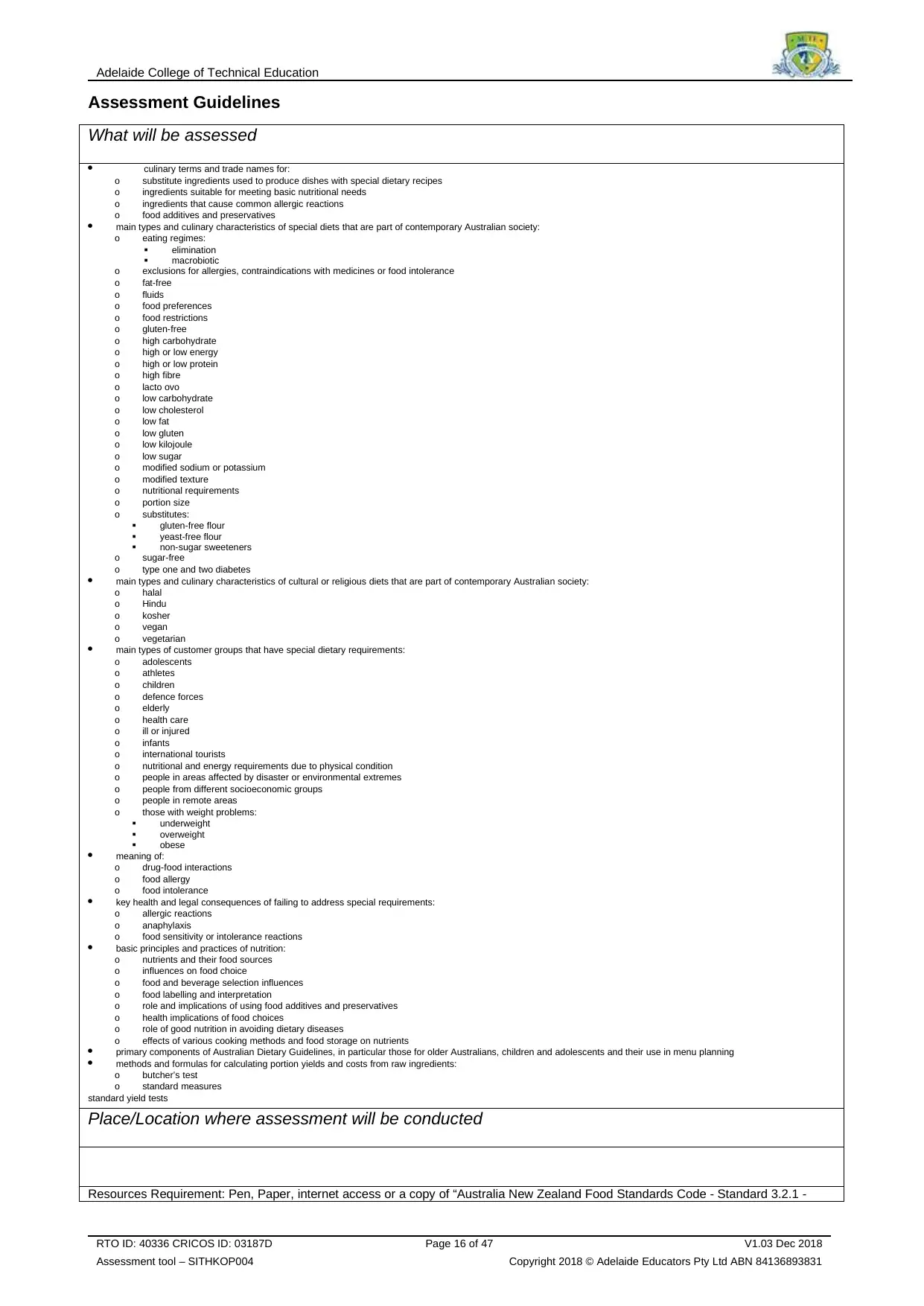
Adelaide College of Technical Education
Assessment Guidelines
What will be assessed
culinary terms and trade names for:
o substitute ingredients used to produce dishes with special dietary recipes
o ingredients suitable for meeting basic nutritional needs
o ingredients that cause common allergic reactions
o food additives and preservatives
main types and culinary characteristics of special diets that are part of contemporary Australian society:
o eating regimes:
elimination
macrobiotic
o exclusions for allergies, contraindications with medicines or food intolerance
o fat-free
o fluids
o food preferences
o food restrictions
o gluten-free
o high carbohydrate
o high or low energy
o high or low protein
o high fibre
o lacto ovo
o low carbohydrate
o low cholesterol
o low fat
o low gluten
o low kilojoule
o low sugar
o modified sodium or potassium
o modified texture
o nutritional requirements
o portion size
o substitutes:
gluten-free flour
yeast-free flour
non-sugar sweeteners
o sugar-free
o type one and two diabetes
main types and culinary characteristics of cultural or religious diets that are part of contemporary Australian society:
o halal
o Hindu
o kosher
o vegan
o vegetarian
main types of customer groups that have special dietary requirements:
o adolescents
o athletes
o children
o defence forces
o elderly
o health care
o ill or injured
o infants
o international tourists
o nutritional and energy requirements due to physical condition
o people in areas affected by disaster or environmental extremes
o people from different socioeconomic groups
o people in remote areas
o those with weight problems:
underweight
overweight
obese
meaning of:
o drug-food interactions
o food allergy
o food intolerance
key health and legal consequences of failing to address special requirements:
o allergic reactions
o anaphylaxis
o food sensitivity or intolerance reactions
basic principles and practices of nutrition:
o nutrients and their food sources
o influences on food choice
o food and beverage selection influences
o food labelling and interpretation
o role and implications of using food additives and preservatives
o health implications of food choices
o role of good nutrition in avoiding dietary diseases
o effects of various cooking methods and food storage on nutrients
primary components of Australian Dietary Guidelines, in particular those for older Australians, children and adolescents and their use in menu planning
methods and formulas for calculating portion yields and costs from raw ingredients:
o butcher’s test
o standard measures
standard yield tests
Place/Location where assessment will be conducted
Resources Requirement: Pen, Paper, internet access or a copy of “Australia New Zealand Food Standards Code - Standard 3.2.1 -
RTO ID: 40336 CRICOS ID: 03187D Page 16 of 47 V1.03 Dec 2018
Assessment tool – SITHKOP004 Copyright 2018 © Adelaide Educators Pty Ltd ABN 84136893831
Assessment Guidelines
What will be assessed
culinary terms and trade names for:
o substitute ingredients used to produce dishes with special dietary recipes
o ingredients suitable for meeting basic nutritional needs
o ingredients that cause common allergic reactions
o food additives and preservatives
main types and culinary characteristics of special diets that are part of contemporary Australian society:
o eating regimes:
elimination
macrobiotic
o exclusions for allergies, contraindications with medicines or food intolerance
o fat-free
o fluids
o food preferences
o food restrictions
o gluten-free
o high carbohydrate
o high or low energy
o high or low protein
o high fibre
o lacto ovo
o low carbohydrate
o low cholesterol
o low fat
o low gluten
o low kilojoule
o low sugar
o modified sodium or potassium
o modified texture
o nutritional requirements
o portion size
o substitutes:
gluten-free flour
yeast-free flour
non-sugar sweeteners
o sugar-free
o type one and two diabetes
main types and culinary characteristics of cultural or religious diets that are part of contemporary Australian society:
o halal
o Hindu
o kosher
o vegan
o vegetarian
main types of customer groups that have special dietary requirements:
o adolescents
o athletes
o children
o defence forces
o elderly
o health care
o ill or injured
o infants
o international tourists
o nutritional and energy requirements due to physical condition
o people in areas affected by disaster or environmental extremes
o people from different socioeconomic groups
o people in remote areas
o those with weight problems:
underweight
overweight
obese
meaning of:
o drug-food interactions
o food allergy
o food intolerance
key health and legal consequences of failing to address special requirements:
o allergic reactions
o anaphylaxis
o food sensitivity or intolerance reactions
basic principles and practices of nutrition:
o nutrients and their food sources
o influences on food choice
o food and beverage selection influences
o food labelling and interpretation
o role and implications of using food additives and preservatives
o health implications of food choices
o role of good nutrition in avoiding dietary diseases
o effects of various cooking methods and food storage on nutrients
primary components of Australian Dietary Guidelines, in particular those for older Australians, children and adolescents and their use in menu planning
methods and formulas for calculating portion yields and costs from raw ingredients:
o butcher’s test
o standard measures
standard yield tests
Place/Location where assessment will be conducted
Resources Requirement: Pen, Paper, internet access or a copy of “Australia New Zealand Food Standards Code - Standard 3.2.1 -
RTO ID: 40336 CRICOS ID: 03187D Page 16 of 47 V1.03 Dec 2018
Assessment tool – SITHKOP004 Copyright 2018 © Adelaide Educators Pty Ltd ABN 84136893831
Secure Best Marks with AI Grader
Need help grading? Try our AI Grader for instant feedback on your assignments.
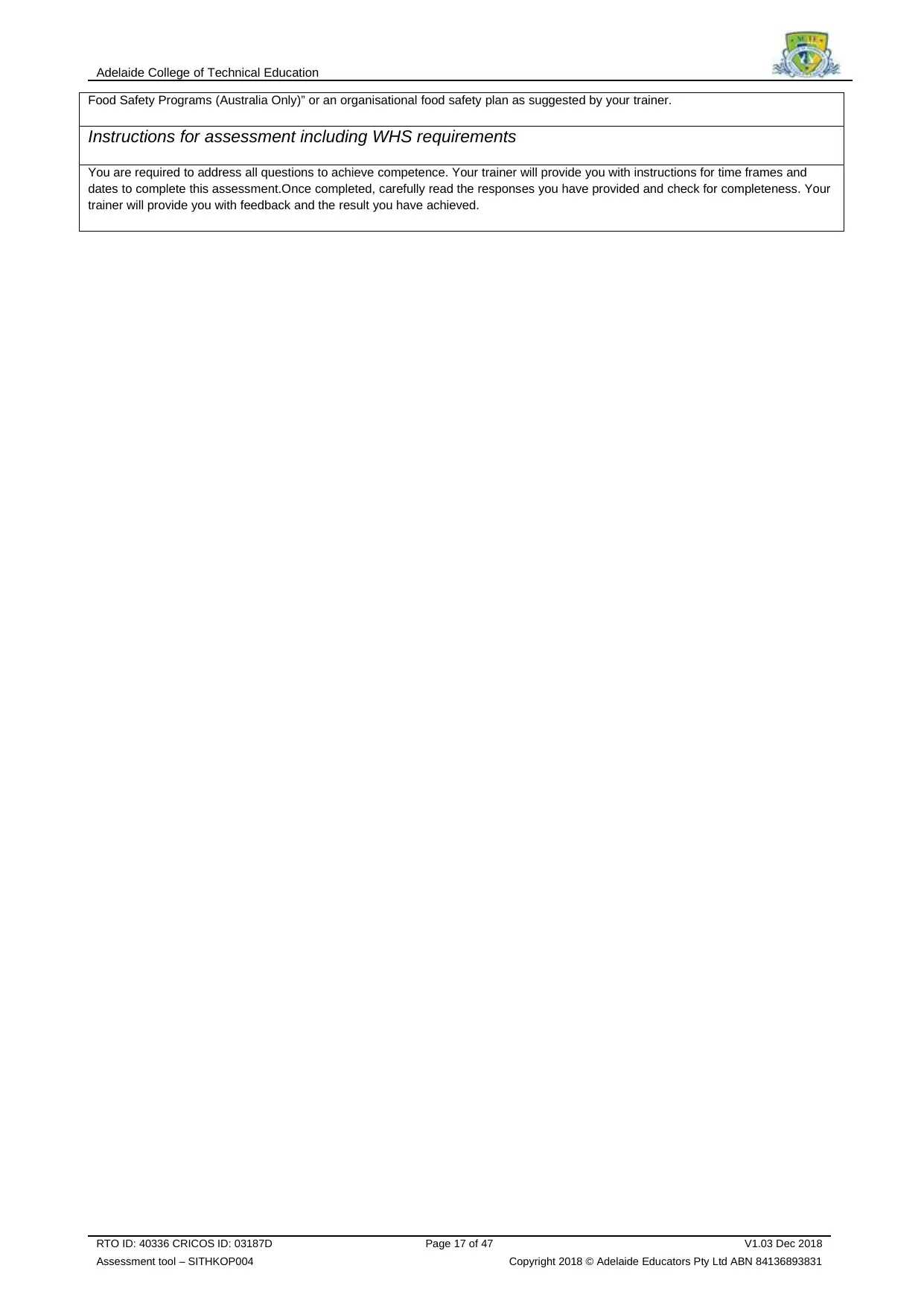
Adelaide College of Technical Education
Food Safety Programs (Australia Only)” or an organisational food safety plan as suggested by your trainer.
Instructions for assessment including WHS requirements
You are required to address all questions to achieve competence. Your trainer will provide you with instructions for time frames and
dates to complete this assessment.Once completed, carefully read the responses you have provided and check for completeness. Your
trainer will provide you with feedback and the result you have achieved.
RTO ID: 40336 CRICOS ID: 03187D Page 17 of 47 V1.03 Dec 2018
Assessment tool – SITHKOP004 Copyright 2018 © Adelaide Educators Pty Ltd ABN 84136893831
Food Safety Programs (Australia Only)” or an organisational food safety plan as suggested by your trainer.
Instructions for assessment including WHS requirements
You are required to address all questions to achieve competence. Your trainer will provide you with instructions for time frames and
dates to complete this assessment.Once completed, carefully read the responses you have provided and check for completeness. Your
trainer will provide you with feedback and the result you have achieved.
RTO ID: 40336 CRICOS ID: 03187D Page 17 of 47 V1.03 Dec 2018
Assessment tool – SITHKOP004 Copyright 2018 © Adelaide Educators Pty Ltd ABN 84136893831
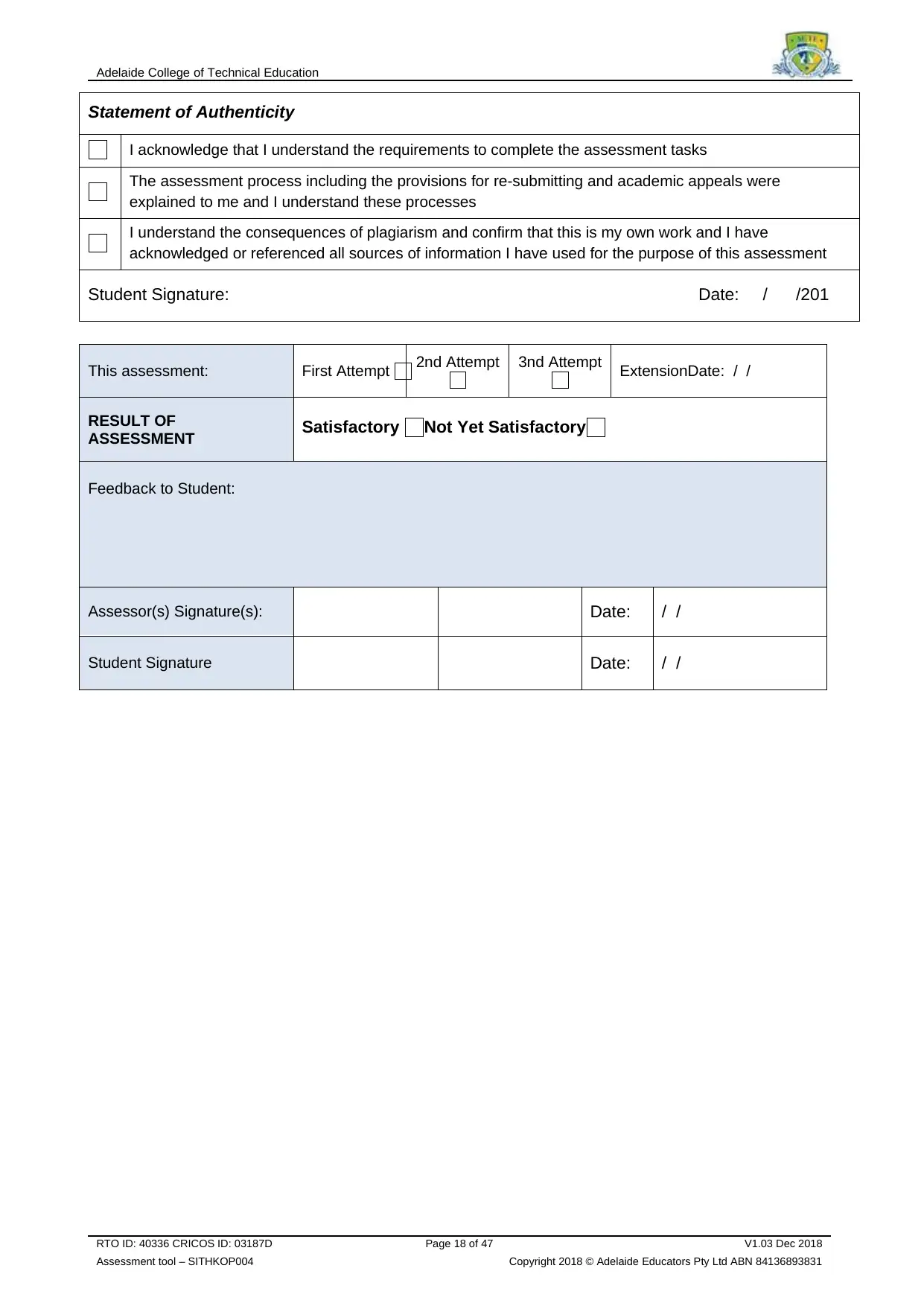
Adelaide College of Technical Education
Statement of Authenticity
I acknowledge that I understand the requirements to complete the assessment tasks
The assessment process including the provisions for re-submitting and academic appeals were
explained to me and I understand these processes
I understand the consequences of plagiarism and confirm that this is my own work and I have
acknowledged or referenced all sources of information I have used for the purpose of this assessment
Student Signature: Date: / /201
This assessment: First Attempt 2nd Attempt 3nd Attempt ExtensionDate: / /
RESULT OF
ASSESSMENT Satisfactory Not Yet Satisfactory
Feedback to Student:
Assessor(s) Signature(s): Date: / /
Student Signature Date: / /
RTO ID: 40336 CRICOS ID: 03187D Page 18 of 47 V1.03 Dec 2018
Assessment tool – SITHKOP004 Copyright 2018 © Adelaide Educators Pty Ltd ABN 84136893831
Statement of Authenticity
I acknowledge that I understand the requirements to complete the assessment tasks
The assessment process including the provisions for re-submitting and academic appeals were
explained to me and I understand these processes
I understand the consequences of plagiarism and confirm that this is my own work and I have
acknowledged or referenced all sources of information I have used for the purpose of this assessment
Student Signature: Date: / /201
This assessment: First Attempt 2nd Attempt 3nd Attempt ExtensionDate: / /
RESULT OF
ASSESSMENT Satisfactory Not Yet Satisfactory
Feedback to Student:
Assessor(s) Signature(s): Date: / /
Student Signature Date: / /
RTO ID: 40336 CRICOS ID: 03187D Page 18 of 47 V1.03 Dec 2018
Assessment tool – SITHKOP004 Copyright 2018 © Adelaide Educators Pty Ltd ABN 84136893831
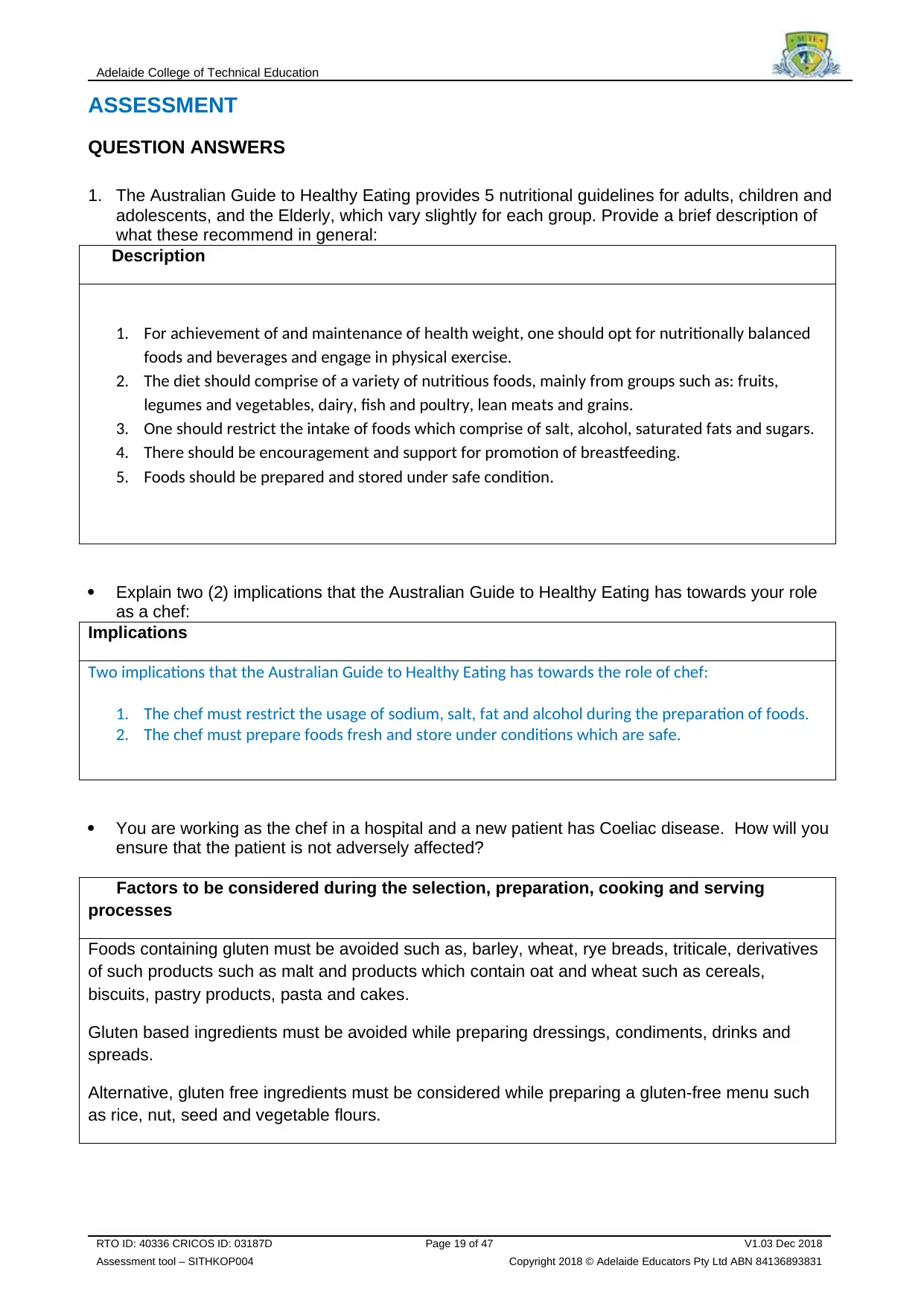
Adelaide College of Technical Education
ASSESSMENT
QUESTION ANSWERS
1. The Australian Guide to Healthy Eating provides 5 nutritional guidelines for adults, children and
adolescents, and the Elderly, which vary slightly for each group. Provide a brief description of
what these recommend in general:
Description
1. For achievement of and maintenance of health weight, one should opt for nutritionally balanced
foods and beverages and engage in physical exercise.
2. The diet should comprise of a variety of nutritious foods, mainly from groups such as: fruits,
legumes and vegetables, dairy, fish and poultry, lean meats and grains.
3. One should restrict the intake of foods which comprise of salt, alcohol, saturated fats and sugars.
4. There should be encouragement and support for promotion of breastfeeding.
5. Foods should be prepared and stored under safe condition.
Explain two (2) implications that the Australian Guide to Healthy Eating has towards your role
as a chef:
Implications
Two implications that the Australian Guide to Healthy Eating has towards the role of chef:
1. The chef must restrict the usage of sodium, salt, fat and alcohol during the preparation of foods.
2. The chef must prepare foods fresh and store under conditions which are safe.
You are working as the chef in a hospital and a new patient has Coeliac disease. How will you
ensure that the patient is not adversely affected?
Factors to be considered during the selection, preparation, cooking and serving
processes
Foods containing gluten must be avoided such as, barley, wheat, rye breads, triticale, derivatives
of such products such as malt and products which contain oat and wheat such as cereals,
biscuits, pastry products, pasta and cakes.
Gluten based ingredients must be avoided while preparing dressings, condiments, drinks and
spreads.
Alternative, gluten free ingredients must be considered while preparing a gluten-free menu such
as rice, nut, seed and vegetable flours.
RTO ID: 40336 CRICOS ID: 03187D Page 19 of 47 V1.03 Dec 2018
Assessment tool – SITHKOP004 Copyright 2018 © Adelaide Educators Pty Ltd ABN 84136893831
ASSESSMENT
QUESTION ANSWERS
1. The Australian Guide to Healthy Eating provides 5 nutritional guidelines for adults, children and
adolescents, and the Elderly, which vary slightly for each group. Provide a brief description of
what these recommend in general:
Description
1. For achievement of and maintenance of health weight, one should opt for nutritionally balanced
foods and beverages and engage in physical exercise.
2. The diet should comprise of a variety of nutritious foods, mainly from groups such as: fruits,
legumes and vegetables, dairy, fish and poultry, lean meats and grains.
3. One should restrict the intake of foods which comprise of salt, alcohol, saturated fats and sugars.
4. There should be encouragement and support for promotion of breastfeeding.
5. Foods should be prepared and stored under safe condition.
Explain two (2) implications that the Australian Guide to Healthy Eating has towards your role
as a chef:
Implications
Two implications that the Australian Guide to Healthy Eating has towards the role of chef:
1. The chef must restrict the usage of sodium, salt, fat and alcohol during the preparation of foods.
2. The chef must prepare foods fresh and store under conditions which are safe.
You are working as the chef in a hospital and a new patient has Coeliac disease. How will you
ensure that the patient is not adversely affected?
Factors to be considered during the selection, preparation, cooking and serving
processes
Foods containing gluten must be avoided such as, barley, wheat, rye breads, triticale, derivatives
of such products such as malt and products which contain oat and wheat such as cereals,
biscuits, pastry products, pasta and cakes.
Gluten based ingredients must be avoided while preparing dressings, condiments, drinks and
spreads.
Alternative, gluten free ingredients must be considered while preparing a gluten-free menu such
as rice, nut, seed and vegetable flours.
RTO ID: 40336 CRICOS ID: 03187D Page 19 of 47 V1.03 Dec 2018
Assessment tool – SITHKOP004 Copyright 2018 © Adelaide Educators Pty Ltd ABN 84136893831
Paraphrase This Document
Need a fresh take? Get an instant paraphrase of this document with our AI Paraphraser
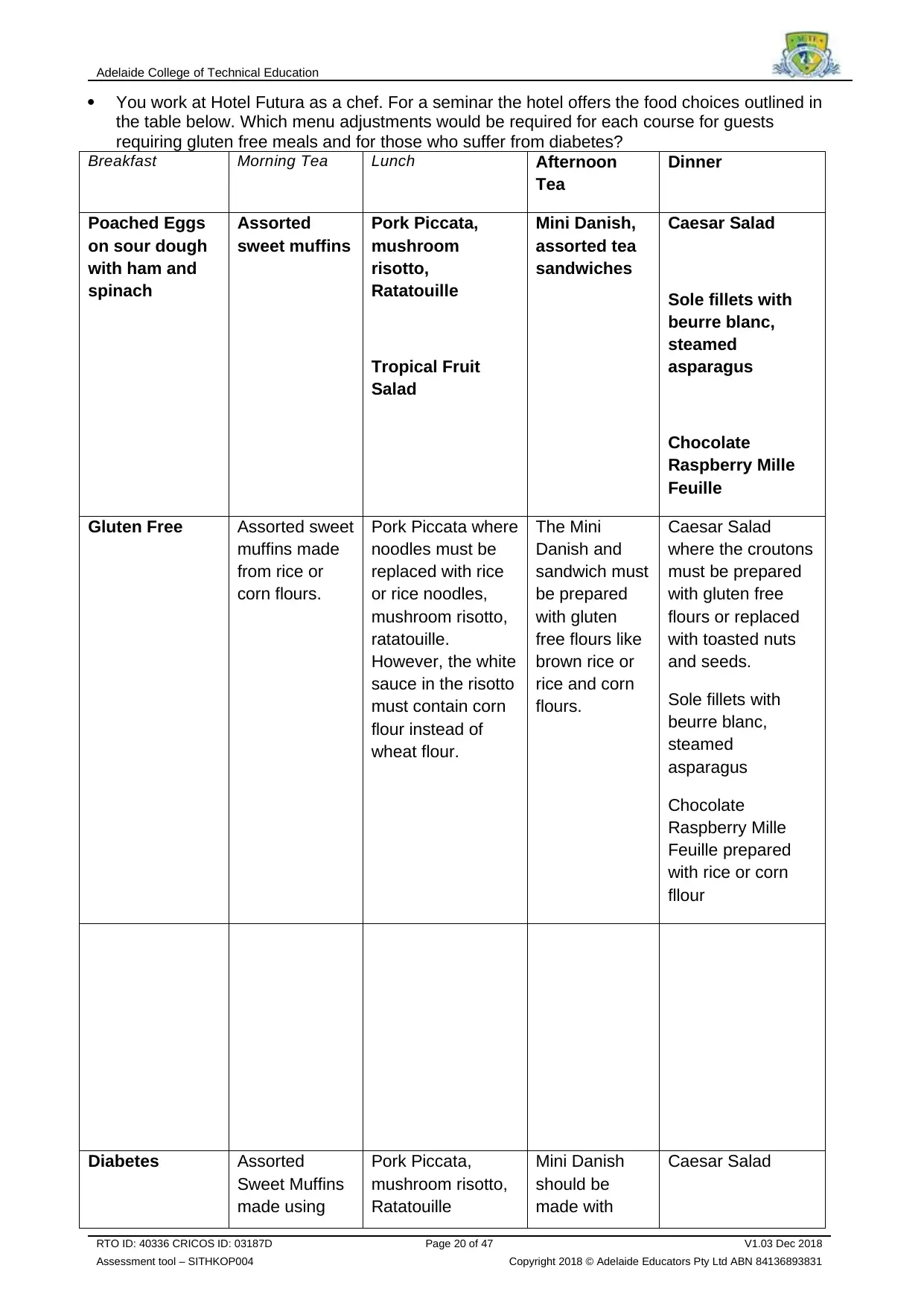
Adelaide College of Technical Education
You work at Hotel Futura as a chef. For a seminar the hotel offers the food choices outlined in
the table below. Which menu adjustments would be required for each course for guests
requiring gluten free meals and for those who suffer from diabetes?
Breakfast Morning Tea Lunch Afternoon
Tea
Dinner
Poached Eggs
on sour dough
with ham and
spinach
Assorted
sweet muffins
Pork Piccata,
mushroom
risotto,
Ratatouille
Tropical Fruit
Salad
Mini Danish,
assorted tea
sandwiches
Caesar Salad
Sole fillets with
beurre blanc,
steamed
asparagus
Chocolate
Raspberry Mille
Feuille
Gluten Free Assorted sweet
muffins made
from rice or
corn flours.
Pork Piccata where
noodles must be
replaced with rice
or rice noodles,
mushroom risotto,
ratatouille.
However, the white
sauce in the risotto
must contain corn
flour instead of
wheat flour.
The Mini
Danish and
sandwich must
be prepared
with gluten
free flours like
brown rice or
rice and corn
flours.
Caesar Salad
where the croutons
must be prepared
with gluten free
flours or replaced
with toasted nuts
and seeds.
Sole fillets with
beurre blanc,
steamed
asparagus
Chocolate
Raspberry Mille
Feuille prepared
with rice or corn
fllour
Diabetes Assorted
Sweet Muffins
made using
Pork Piccata,
mushroom risotto,
Ratatouille
Mini Danish
should be
made with
Caesar Salad
RTO ID: 40336 CRICOS ID: 03187D Page 20 of 47 V1.03 Dec 2018
Assessment tool – SITHKOP004 Copyright 2018 © Adelaide Educators Pty Ltd ABN 84136893831
You work at Hotel Futura as a chef. For a seminar the hotel offers the food choices outlined in
the table below. Which menu adjustments would be required for each course for guests
requiring gluten free meals and for those who suffer from diabetes?
Breakfast Morning Tea Lunch Afternoon
Tea
Dinner
Poached Eggs
on sour dough
with ham and
spinach
Assorted
sweet muffins
Pork Piccata,
mushroom
risotto,
Ratatouille
Tropical Fruit
Salad
Mini Danish,
assorted tea
sandwiches
Caesar Salad
Sole fillets with
beurre blanc,
steamed
asparagus
Chocolate
Raspberry Mille
Feuille
Gluten Free Assorted sweet
muffins made
from rice or
corn flours.
Pork Piccata where
noodles must be
replaced with rice
or rice noodles,
mushroom risotto,
ratatouille.
However, the white
sauce in the risotto
must contain corn
flour instead of
wheat flour.
The Mini
Danish and
sandwich must
be prepared
with gluten
free flours like
brown rice or
rice and corn
flours.
Caesar Salad
where the croutons
must be prepared
with gluten free
flours or replaced
with toasted nuts
and seeds.
Sole fillets with
beurre blanc,
steamed
asparagus
Chocolate
Raspberry Mille
Feuille prepared
with rice or corn
fllour
Diabetes Assorted
Sweet Muffins
made using
Pork Piccata,
mushroom risotto,
Ratatouille
Mini Danish
should be
made with
Caesar Salad
RTO ID: 40336 CRICOS ID: 03187D Page 20 of 47 V1.03 Dec 2018
Assessment tool – SITHKOP004 Copyright 2018 © Adelaide Educators Pty Ltd ABN 84136893831
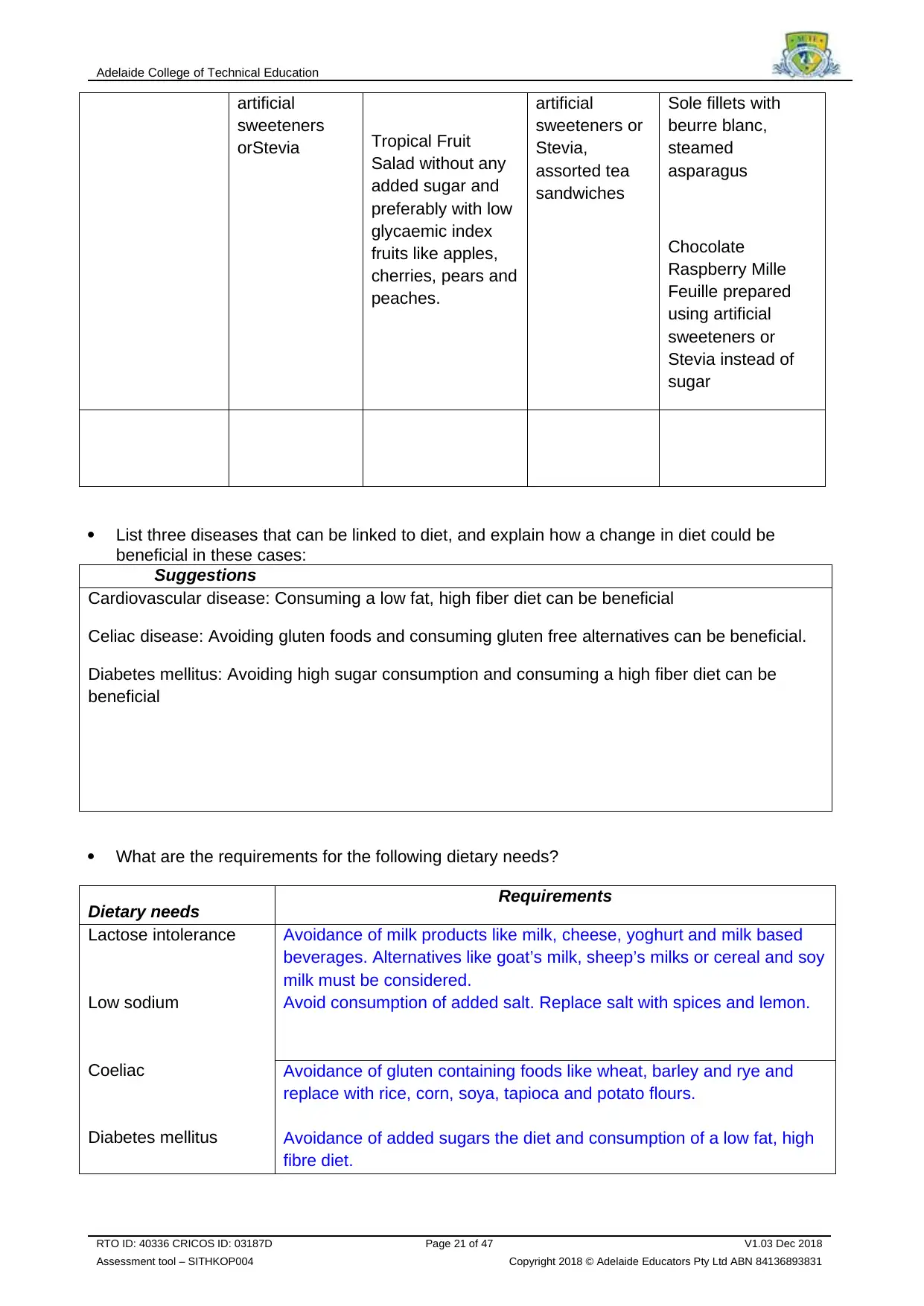
Adelaide College of Technical Education
artificial
sweeteners
orStevia Tropical Fruit
Salad without any
added sugar and
preferably with low
glycaemic index
fruits like apples,
cherries, pears and
peaches.
artificial
sweeteners or
Stevia,
assorted tea
sandwiches
Sole fillets with
beurre blanc,
steamed
asparagus
Chocolate
Raspberry Mille
Feuille prepared
using artificial
sweeteners or
Stevia instead of
sugar
List three diseases that can be linked to diet, and explain how a change in diet could be
beneficial in these cases:
Suggestions
Cardiovascular disease: Consuming a low fat, high fiber diet can be beneficial
Celiac disease: Avoiding gluten foods and consuming gluten free alternatives can be beneficial.
Diabetes mellitus: Avoiding high sugar consumption and consuming a high fiber diet can be
beneficial
What are the requirements for the following dietary needs?
Dietary needs Requirements
Lactose intolerance
Low sodium
Coeliac
Diabetes mellitus
Avoidance of milk products like milk, cheese, yoghurt and milk based
beverages. Alternatives like goat’s milk, sheep’s milks or cereal and soy
milk must be considered.
Avoid consumption of added salt. Replace salt with spices and lemon.
Avoidance of gluten containing foods like wheat, barley and rye and
replace with rice, corn, soya, tapioca and potato flours.
Avoidance of added sugars the diet and consumption of a low fat, high
fibre diet.
RTO ID: 40336 CRICOS ID: 03187D Page 21 of 47 V1.03 Dec 2018
Assessment tool – SITHKOP004 Copyright 2018 © Adelaide Educators Pty Ltd ABN 84136893831
artificial
sweeteners
orStevia Tropical Fruit
Salad without any
added sugar and
preferably with low
glycaemic index
fruits like apples,
cherries, pears and
peaches.
artificial
sweeteners or
Stevia,
assorted tea
sandwiches
Sole fillets with
beurre blanc,
steamed
asparagus
Chocolate
Raspberry Mille
Feuille prepared
using artificial
sweeteners or
Stevia instead of
sugar
List three diseases that can be linked to diet, and explain how a change in diet could be
beneficial in these cases:
Suggestions
Cardiovascular disease: Consuming a low fat, high fiber diet can be beneficial
Celiac disease: Avoiding gluten foods and consuming gluten free alternatives can be beneficial.
Diabetes mellitus: Avoiding high sugar consumption and consuming a high fiber diet can be
beneficial
What are the requirements for the following dietary needs?
Dietary needs Requirements
Lactose intolerance
Low sodium
Coeliac
Diabetes mellitus
Avoidance of milk products like milk, cheese, yoghurt and milk based
beverages. Alternatives like goat’s milk, sheep’s milks or cereal and soy
milk must be considered.
Avoid consumption of added salt. Replace salt with spices and lemon.
Avoidance of gluten containing foods like wheat, barley and rye and
replace with rice, corn, soya, tapioca and potato flours.
Avoidance of added sugars the diet and consumption of a low fat, high
fibre diet.
RTO ID: 40336 CRICOS ID: 03187D Page 21 of 47 V1.03 Dec 2018
Assessment tool – SITHKOP004 Copyright 2018 © Adelaide Educators Pty Ltd ABN 84136893831
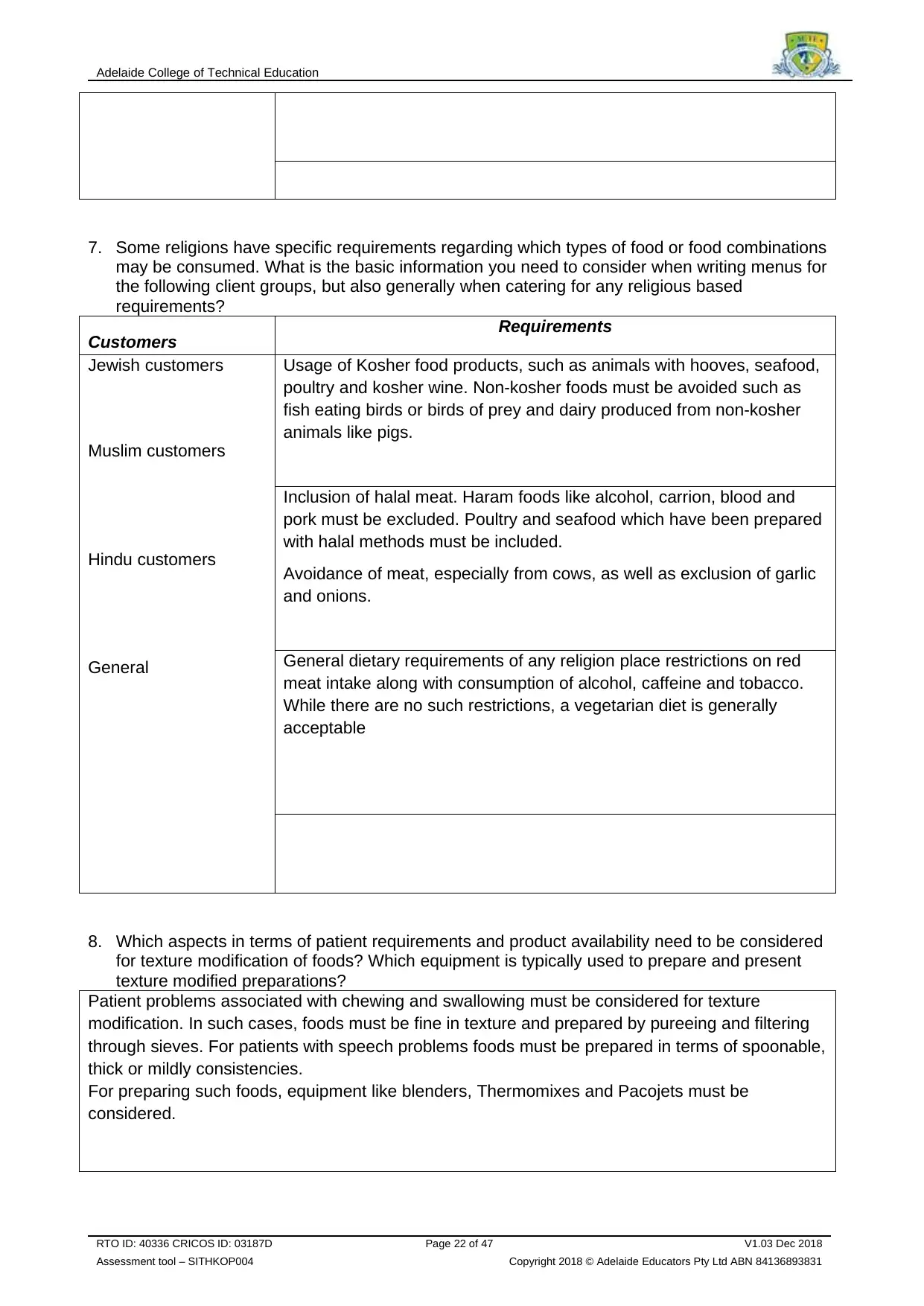
Adelaide College of Technical Education
7. Some religions have specific requirements regarding which types of food or food combinations
may be consumed. What is the basic information you need to consider when writing menus for
the following client groups, but also generally when catering for any religious based
requirements?
Customers Requirements
Jewish customers
Muslim customers
Hindu customers
General
Usage of Kosher food products, such as animals with hooves, seafood,
poultry and kosher wine. Non-kosher foods must be avoided such as
fish eating birds or birds of prey and dairy produced from non-kosher
animals like pigs.
Inclusion of halal meat. Haram foods like alcohol, carrion, blood and
pork must be excluded. Poultry and seafood which have been prepared
with halal methods must be included.
Avoidance of meat, especially from cows, as well as exclusion of garlic
and onions.
General dietary requirements of any religion place restrictions on red
meat intake along with consumption of alcohol, caffeine and tobacco.
While there are no such restrictions, a vegetarian diet is generally
acceptable
8. Which aspects in terms of patient requirements and product availability need to be considered
for texture modification of foods? Which equipment is typically used to prepare and present
texture modified preparations?
Patient problems associated with chewing and swallowing must be considered for texture
modification. In such cases, foods must be fine in texture and prepared by pureeing and filtering
through sieves. For patients with speech problems foods must be prepared in terms of spoonable,
thick or mildly consistencies.
For preparing such foods, equipment like blenders, Thermomixes and Pacojets must be
considered.
RTO ID: 40336 CRICOS ID: 03187D Page 22 of 47 V1.03 Dec 2018
Assessment tool – SITHKOP004 Copyright 2018 © Adelaide Educators Pty Ltd ABN 84136893831
7. Some religions have specific requirements regarding which types of food or food combinations
may be consumed. What is the basic information you need to consider when writing menus for
the following client groups, but also generally when catering for any religious based
requirements?
Customers Requirements
Jewish customers
Muslim customers
Hindu customers
General
Usage of Kosher food products, such as animals with hooves, seafood,
poultry and kosher wine. Non-kosher foods must be avoided such as
fish eating birds or birds of prey and dairy produced from non-kosher
animals like pigs.
Inclusion of halal meat. Haram foods like alcohol, carrion, blood and
pork must be excluded. Poultry and seafood which have been prepared
with halal methods must be included.
Avoidance of meat, especially from cows, as well as exclusion of garlic
and onions.
General dietary requirements of any religion place restrictions on red
meat intake along with consumption of alcohol, caffeine and tobacco.
While there are no such restrictions, a vegetarian diet is generally
acceptable
8. Which aspects in terms of patient requirements and product availability need to be considered
for texture modification of foods? Which equipment is typically used to prepare and present
texture modified preparations?
Patient problems associated with chewing and swallowing must be considered for texture
modification. In such cases, foods must be fine in texture and prepared by pureeing and filtering
through sieves. For patients with speech problems foods must be prepared in terms of spoonable,
thick or mildly consistencies.
For preparing such foods, equipment like blenders, Thermomixes and Pacojets must be
considered.
RTO ID: 40336 CRICOS ID: 03187D Page 22 of 47 V1.03 Dec 2018
Assessment tool – SITHKOP004 Copyright 2018 © Adelaide Educators Pty Ltd ABN 84136893831
Secure Best Marks with AI Grader
Need help grading? Try our AI Grader for instant feedback on your assignments.
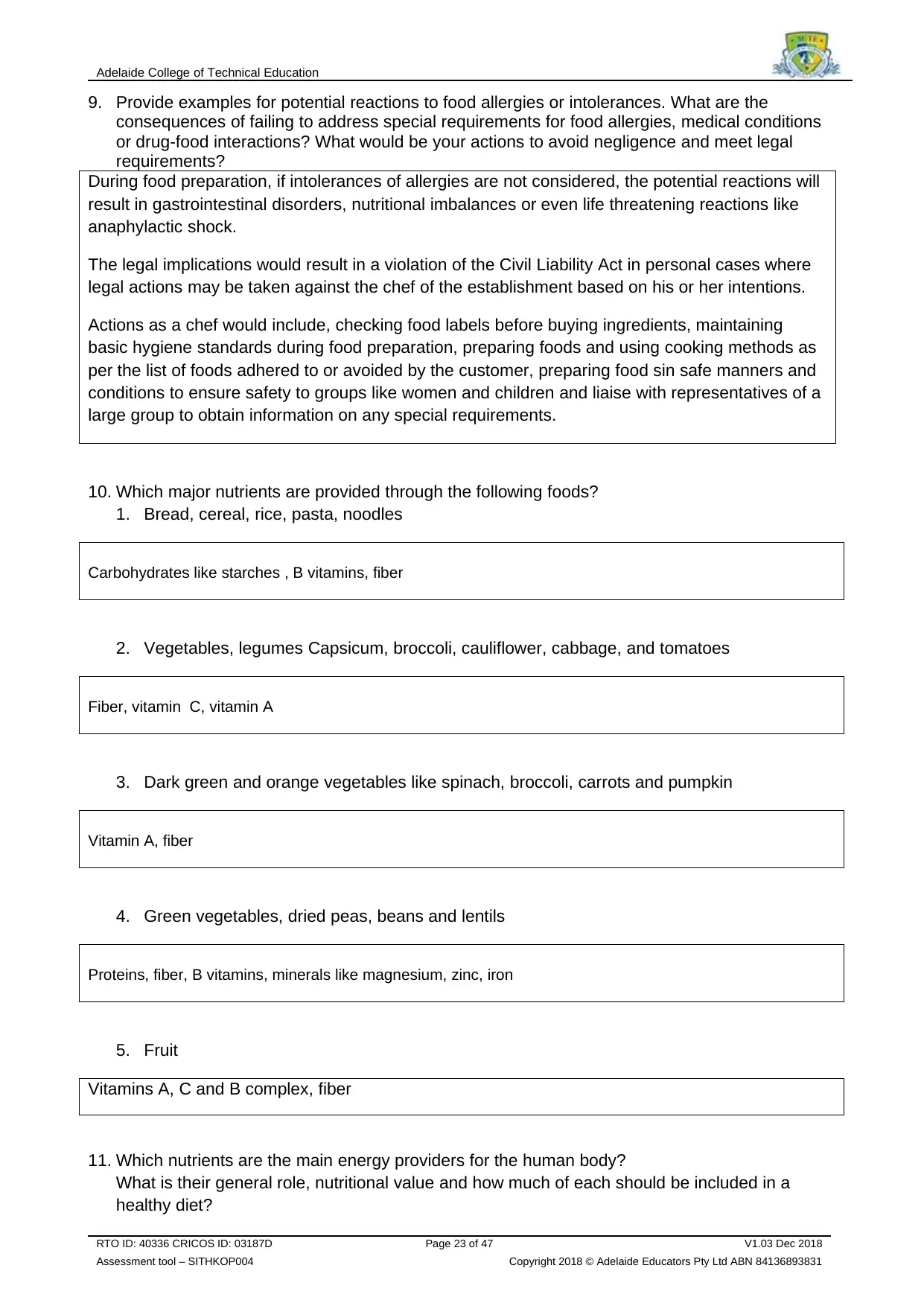
Adelaide College of Technical Education
9. Provide examples for potential reactions to food allergies or intolerances. What are the
consequences of failing to address special requirements for food allergies, medical conditions
or drug-food interactions? What would be your actions to avoid negligence and meet legal
requirements?
During food preparation, if intolerances of allergies are not considered, the potential reactions will
result in gastrointestinal disorders, nutritional imbalances or even life threatening reactions like
anaphylactic shock.
The legal implications would result in a violation of the Civil Liability Act in personal cases where
legal actions may be taken against the chef of the establishment based on his or her intentions.
Actions as a chef would include, checking food labels before buying ingredients, maintaining
basic hygiene standards during food preparation, preparing foods and using cooking methods as
per the list of foods adhered to or avoided by the customer, preparing food sin safe manners and
conditions to ensure safety to groups like women and children and liaise with representatives of a
large group to obtain information on any special requirements.
10. Which major nutrients are provided through the following foods?
1. Bread, cereal, rice, pasta, noodles
Carbohydrates like starches , B vitamins, fiber
2. Vegetables, legumes Capsicum, broccoli, cauliflower, cabbage, and tomatoes
Fiber, vitamin C, vitamin A
3. Dark green and orange vegetables like spinach, broccoli, carrots and pumpkin
Vitamin A, fiber
4. Green vegetables, dried peas, beans and lentils
Proteins, fiber, B vitamins, minerals like magnesium, zinc, iron
5. Fruit
Vitamins A, C and B complex, fiber
11. Which nutrients are the main energy providers for the human body?
What is their general role, nutritional value and how much of each should be included in a
healthy diet?
RTO ID: 40336 CRICOS ID: 03187D Page 23 of 47 V1.03 Dec 2018
Assessment tool – SITHKOP004 Copyright 2018 © Adelaide Educators Pty Ltd ABN 84136893831
9. Provide examples for potential reactions to food allergies or intolerances. What are the
consequences of failing to address special requirements for food allergies, medical conditions
or drug-food interactions? What would be your actions to avoid negligence and meet legal
requirements?
During food preparation, if intolerances of allergies are not considered, the potential reactions will
result in gastrointestinal disorders, nutritional imbalances or even life threatening reactions like
anaphylactic shock.
The legal implications would result in a violation of the Civil Liability Act in personal cases where
legal actions may be taken against the chef of the establishment based on his or her intentions.
Actions as a chef would include, checking food labels before buying ingredients, maintaining
basic hygiene standards during food preparation, preparing foods and using cooking methods as
per the list of foods adhered to or avoided by the customer, preparing food sin safe manners and
conditions to ensure safety to groups like women and children and liaise with representatives of a
large group to obtain information on any special requirements.
10. Which major nutrients are provided through the following foods?
1. Bread, cereal, rice, pasta, noodles
Carbohydrates like starches , B vitamins, fiber
2. Vegetables, legumes Capsicum, broccoli, cauliflower, cabbage, and tomatoes
Fiber, vitamin C, vitamin A
3. Dark green and orange vegetables like spinach, broccoli, carrots and pumpkin
Vitamin A, fiber
4. Green vegetables, dried peas, beans and lentils
Proteins, fiber, B vitamins, minerals like magnesium, zinc, iron
5. Fruit
Vitamins A, C and B complex, fiber
11. Which nutrients are the main energy providers for the human body?
What is their general role, nutritional value and how much of each should be included in a
healthy diet?
RTO ID: 40336 CRICOS ID: 03187D Page 23 of 47 V1.03 Dec 2018
Assessment tool – SITHKOP004 Copyright 2018 © Adelaide Educators Pty Ltd ABN 84136893831
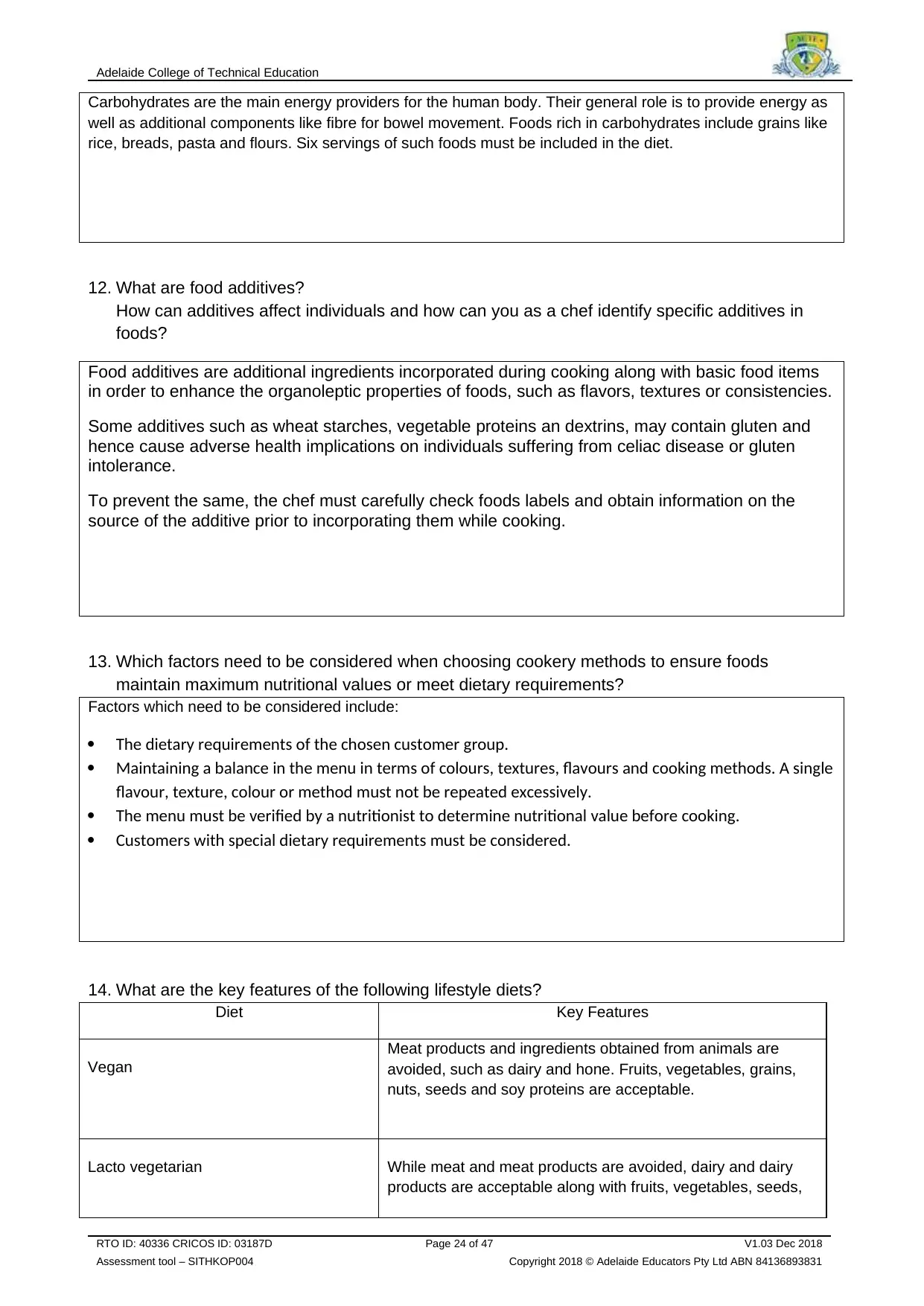
Adelaide College of Technical Education
Carbohydrates are the main energy providers for the human body. Their general role is to provide energy as
well as additional components like fibre for bowel movement. Foods rich in carbohydrates include grains like
rice, breads, pasta and flours. Six servings of such foods must be included in the diet.
12. What are food additives?
How can additives affect individuals and how can you as a chef identify specific additives in
foods?
Food additives are additional ingredients incorporated during cooking along with basic food items
in order to enhance the organoleptic properties of foods, such as flavors, textures or consistencies.
Some additives such as wheat starches, vegetable proteins an dextrins, may contain gluten and
hence cause adverse health implications on individuals suffering from celiac disease or gluten
intolerance.
To prevent the same, the chef must carefully check foods labels and obtain information on the
source of the additive prior to incorporating them while cooking.
13. Which factors need to be considered when choosing cookery methods to ensure foods
maintain maximum nutritional values or meet dietary requirements?
Factors which need to be considered include:
The dietary requirements of the chosen customer group.
Maintaining a balance in the menu in terms of colours, textures, flavours and cooking methods. A single
flavour, texture, colour or method must not be repeated excessively.
The menu must be verified by a nutritionist to determine nutritional value before cooking.
Customers with special dietary requirements must be considered.
14. What are the key features of the following lifestyle diets?
Diet Key Features
Vegan
Meat products and ingredients obtained from animals are
avoided, such as dairy and hone. Fruits, vegetables, grains,
nuts, seeds and soy proteins are acceptable.
Lacto vegetarian While meat and meat products are avoided, dairy and dairy
products are acceptable along with fruits, vegetables, seeds,
RTO ID: 40336 CRICOS ID: 03187D Page 24 of 47 V1.03 Dec 2018
Assessment tool – SITHKOP004 Copyright 2018 © Adelaide Educators Pty Ltd ABN 84136893831
Carbohydrates are the main energy providers for the human body. Their general role is to provide energy as
well as additional components like fibre for bowel movement. Foods rich in carbohydrates include grains like
rice, breads, pasta and flours. Six servings of such foods must be included in the diet.
12. What are food additives?
How can additives affect individuals and how can you as a chef identify specific additives in
foods?
Food additives are additional ingredients incorporated during cooking along with basic food items
in order to enhance the organoleptic properties of foods, such as flavors, textures or consistencies.
Some additives such as wheat starches, vegetable proteins an dextrins, may contain gluten and
hence cause adverse health implications on individuals suffering from celiac disease or gluten
intolerance.
To prevent the same, the chef must carefully check foods labels and obtain information on the
source of the additive prior to incorporating them while cooking.
13. Which factors need to be considered when choosing cookery methods to ensure foods
maintain maximum nutritional values or meet dietary requirements?
Factors which need to be considered include:
The dietary requirements of the chosen customer group.
Maintaining a balance in the menu in terms of colours, textures, flavours and cooking methods. A single
flavour, texture, colour or method must not be repeated excessively.
The menu must be verified by a nutritionist to determine nutritional value before cooking.
Customers with special dietary requirements must be considered.
14. What are the key features of the following lifestyle diets?
Diet Key Features
Vegan
Meat products and ingredients obtained from animals are
avoided, such as dairy and hone. Fruits, vegetables, grains,
nuts, seeds and soy proteins are acceptable.
Lacto vegetarian While meat and meat products are avoided, dairy and dairy
products are acceptable along with fruits, vegetables, seeds,
RTO ID: 40336 CRICOS ID: 03187D Page 24 of 47 V1.03 Dec 2018
Assessment tool – SITHKOP004 Copyright 2018 © Adelaide Educators Pty Ltd ABN 84136893831
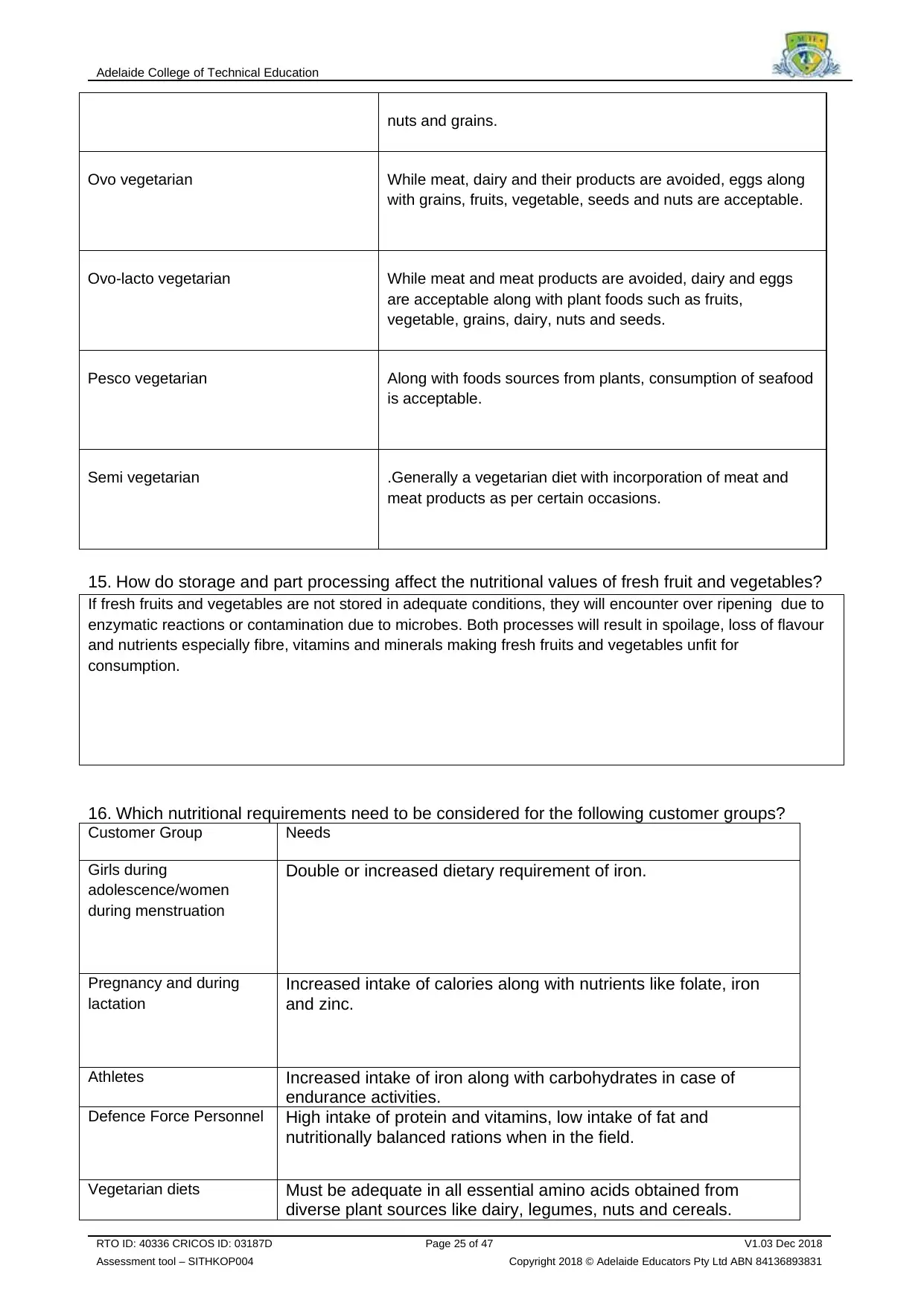
Adelaide College of Technical Education
nuts and grains.
Ovo vegetarian While meat, dairy and their products are avoided, eggs along
with grains, fruits, vegetable, seeds and nuts are acceptable.
Ovo-lacto vegetarian While meat and meat products are avoided, dairy and eggs
are acceptable along with plant foods such as fruits,
vegetable, grains, dairy, nuts and seeds.
Pesco vegetarian Along with foods sources from plants, consumption of seafood
is acceptable.
Semi vegetarian .Generally a vegetarian diet with incorporation of meat and
meat products as per certain occasions.
15. How do storage and part processing affect the nutritional values of fresh fruit and vegetables?
If fresh fruits and vegetables are not stored in adequate conditions, they will encounter over ripening due to
enzymatic reactions or contamination due to microbes. Both processes will result in spoilage, loss of flavour
and nutrients especially fibre, vitamins and minerals making fresh fruits and vegetables unfit for
consumption.
16. Which nutritional requirements need to be considered for the following customer groups?
Customer Group Needs
Girls during
adolescence/women
during menstruation
Double or increased dietary requirement of iron.
Pregnancy and during
lactation
Increased intake of calories along with nutrients like folate, iron
and zinc.
Athletes Increased intake of iron along with carbohydrates in case of
endurance activities.
Defence Force Personnel High intake of protein and vitamins, low intake of fat and
nutritionally balanced rations when in the field.
Vegetarian diets Must be adequate in all essential amino acids obtained from
diverse plant sources like dairy, legumes, nuts and cereals.
RTO ID: 40336 CRICOS ID: 03187D Page 25 of 47 V1.03 Dec 2018
Assessment tool – SITHKOP004 Copyright 2018 © Adelaide Educators Pty Ltd ABN 84136893831
nuts and grains.
Ovo vegetarian While meat, dairy and their products are avoided, eggs along
with grains, fruits, vegetable, seeds and nuts are acceptable.
Ovo-lacto vegetarian While meat and meat products are avoided, dairy and eggs
are acceptable along with plant foods such as fruits,
vegetable, grains, dairy, nuts and seeds.
Pesco vegetarian Along with foods sources from plants, consumption of seafood
is acceptable.
Semi vegetarian .Generally a vegetarian diet with incorporation of meat and
meat products as per certain occasions.
15. How do storage and part processing affect the nutritional values of fresh fruit and vegetables?
If fresh fruits and vegetables are not stored in adequate conditions, they will encounter over ripening due to
enzymatic reactions or contamination due to microbes. Both processes will result in spoilage, loss of flavour
and nutrients especially fibre, vitamins and minerals making fresh fruits and vegetables unfit for
consumption.
16. Which nutritional requirements need to be considered for the following customer groups?
Customer Group Needs
Girls during
adolescence/women
during menstruation
Double or increased dietary requirement of iron.
Pregnancy and during
lactation
Increased intake of calories along with nutrients like folate, iron
and zinc.
Athletes Increased intake of iron along with carbohydrates in case of
endurance activities.
Defence Force Personnel High intake of protein and vitamins, low intake of fat and
nutritionally balanced rations when in the field.
Vegetarian diets Must be adequate in all essential amino acids obtained from
diverse plant sources like dairy, legumes, nuts and cereals.
RTO ID: 40336 CRICOS ID: 03187D Page 25 of 47 V1.03 Dec 2018
Assessment tool – SITHKOP004 Copyright 2018 © Adelaide Educators Pty Ltd ABN 84136893831
Paraphrase This Document
Need a fresh take? Get an instant paraphrase of this document with our AI Paraphraser
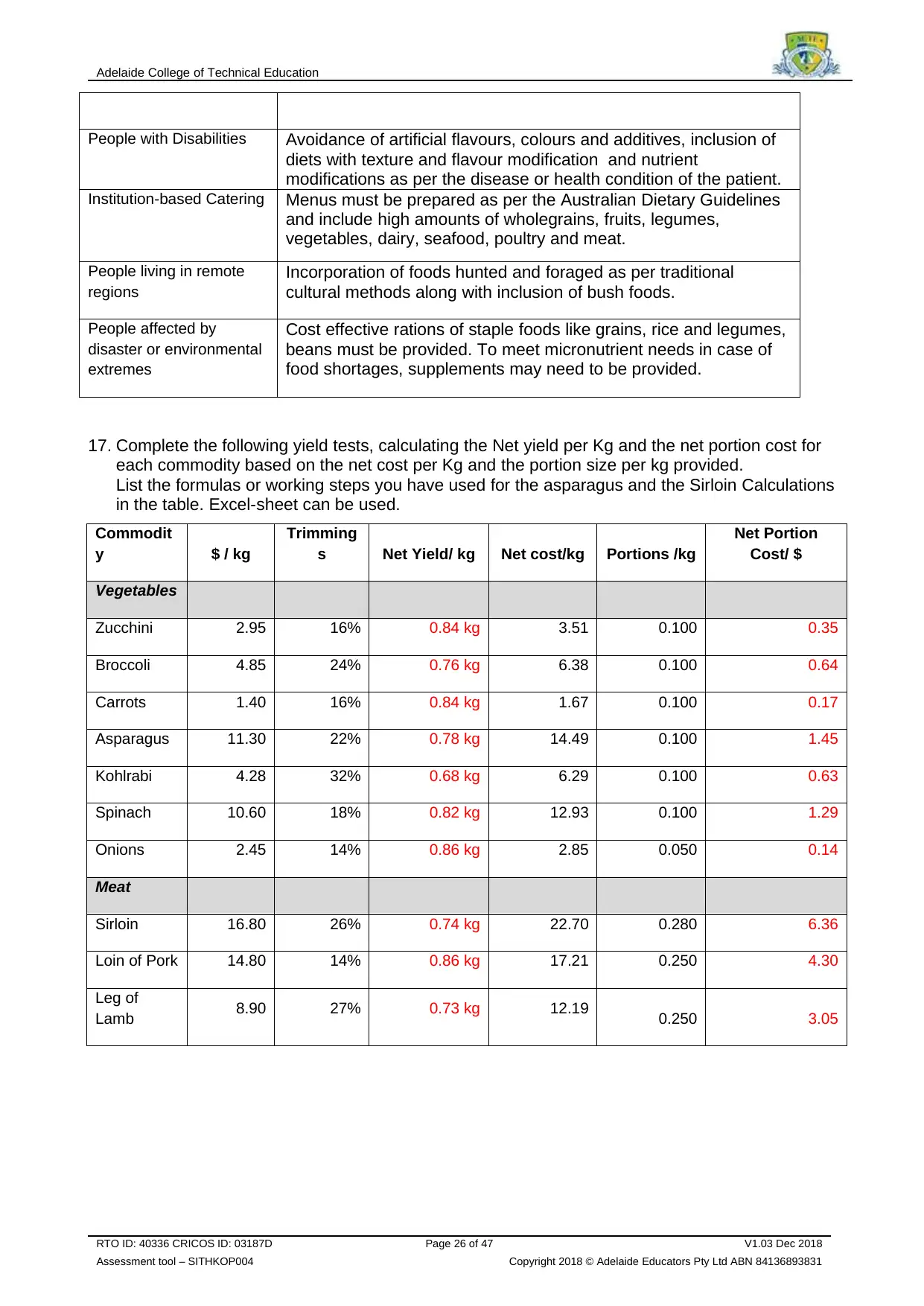
Adelaide College of Technical Education
People with Disabilities Avoidance of artificial flavours, colours and additives, inclusion of
diets with texture and flavour modification and nutrient
modifications as per the disease or health condition of the patient.
Institution-based Catering Menus must be prepared as per the Australian Dietary Guidelines
and include high amounts of wholegrains, fruits, legumes,
vegetables, dairy, seafood, poultry and meat.
People living in remote
regions
Incorporation of foods hunted and foraged as per traditional
cultural methods along with inclusion of bush foods.
People affected by
disaster or environmental
extremes
Cost effective rations of staple foods like grains, rice and legumes,
beans must be provided. To meet micronutrient needs in case of
food shortages, supplements may need to be provided.
17. Complete the following yield tests, calculating the Net yield per Kg and the net portion cost for
each commodity based on the net cost per Kg and the portion size per kg provided.
List the formulas or working steps you have used for the asparagus and the Sirloin Calculations
in the table. Excel-sheet can be used.
Commodit
y $ / kg
Trimming
s Net Yield/ kg Net cost/kg Portions /kg
Net Portion
Cost/ $
Vegetables
Zucchini 2.95 16% 0.84 kg 3.51 0.100 0.35
Broccoli 4.85 24% 0.76 kg 6.38 0.100 0.64
Carrots 1.40 16% 0.84 kg 1.67 0.100 0.17
Asparagus 11.30 22% 0.78 kg 14.49 0.100 1.45
Kohlrabi 4.28 32% 0.68 kg 6.29 0.100 0.63
Spinach 10.60 18% 0.82 kg 12.93 0.100 1.29
Onions 2.45 14% 0.86 kg 2.85 0.050 0.14
Meat
Sirloin 16.80 26% 0.74 kg 22.70 0.280 6.36
Loin of Pork 14.80 14% 0.86 kg 17.21 0.250 4.30
Leg of
Lamb 8.90 27% 0.73 kg 12.19 0.250 3.05
RTO ID: 40336 CRICOS ID: 03187D Page 26 of 47 V1.03 Dec 2018
Assessment tool – SITHKOP004 Copyright 2018 © Adelaide Educators Pty Ltd ABN 84136893831
People with Disabilities Avoidance of artificial flavours, colours and additives, inclusion of
diets with texture and flavour modification and nutrient
modifications as per the disease or health condition of the patient.
Institution-based Catering Menus must be prepared as per the Australian Dietary Guidelines
and include high amounts of wholegrains, fruits, legumes,
vegetables, dairy, seafood, poultry and meat.
People living in remote
regions
Incorporation of foods hunted and foraged as per traditional
cultural methods along with inclusion of bush foods.
People affected by
disaster or environmental
extremes
Cost effective rations of staple foods like grains, rice and legumes,
beans must be provided. To meet micronutrient needs in case of
food shortages, supplements may need to be provided.
17. Complete the following yield tests, calculating the Net yield per Kg and the net portion cost for
each commodity based on the net cost per Kg and the portion size per kg provided.
List the formulas or working steps you have used for the asparagus and the Sirloin Calculations
in the table. Excel-sheet can be used.
Commodit
y $ / kg
Trimming
s Net Yield/ kg Net cost/kg Portions /kg
Net Portion
Cost/ $
Vegetables
Zucchini 2.95 16% 0.84 kg 3.51 0.100 0.35
Broccoli 4.85 24% 0.76 kg 6.38 0.100 0.64
Carrots 1.40 16% 0.84 kg 1.67 0.100 0.17
Asparagus 11.30 22% 0.78 kg 14.49 0.100 1.45
Kohlrabi 4.28 32% 0.68 kg 6.29 0.100 0.63
Spinach 10.60 18% 0.82 kg 12.93 0.100 1.29
Onions 2.45 14% 0.86 kg 2.85 0.050 0.14
Meat
Sirloin 16.80 26% 0.74 kg 22.70 0.280 6.36
Loin of Pork 14.80 14% 0.86 kg 17.21 0.250 4.30
Leg of
Lamb 8.90 27% 0.73 kg 12.19 0.250 3.05
RTO ID: 40336 CRICOS ID: 03187D Page 26 of 47 V1.03 Dec 2018
Assessment tool – SITHKOP004 Copyright 2018 © Adelaide Educators Pty Ltd ABN 84136893831
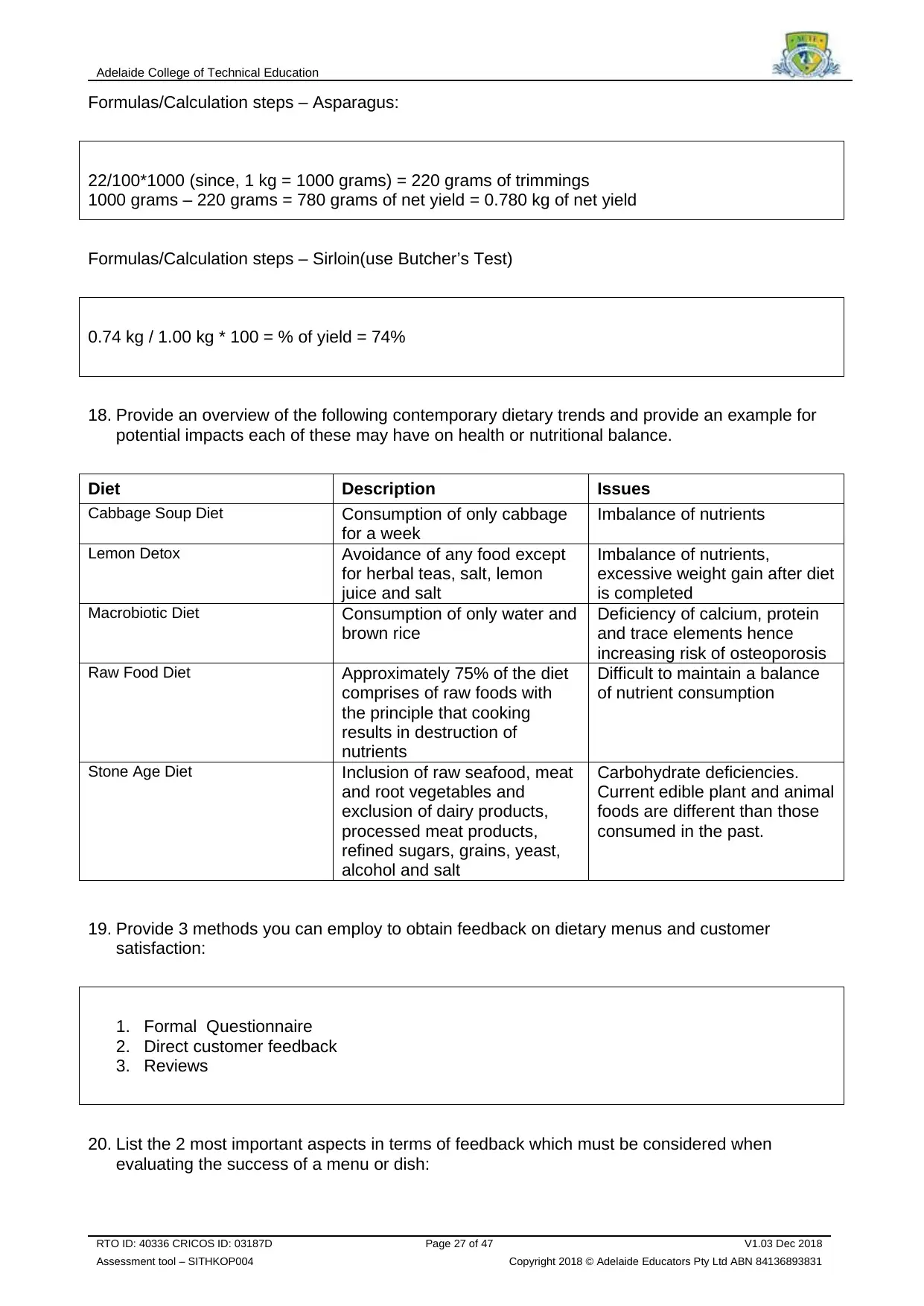
Adelaide College of Technical Education
Formulas/Calculation steps – Asparagus:
22/100*1000 (since, 1 kg = 1000 grams) = 220 grams of trimmings
1000 grams – 220 grams = 780 grams of net yield = 0.780 kg of net yield
Formulas/Calculation steps – Sirloin(use Butcher’s Test)
0.74 kg / 1.00 kg * 100 = % of yield = 74%
18. Provide an overview of the following contemporary dietary trends and provide an example for
potential impacts each of these may have on health or nutritional balance.
Diet Description Issues
Cabbage Soup Diet Consumption of only cabbage
for a week
Imbalance of nutrients
Lemon Detox Avoidance of any food except
for herbal teas, salt, lemon
juice and salt
Imbalance of nutrients,
excessive weight gain after diet
is completed
Macrobiotic Diet Consumption of only water and
brown rice
Deficiency of calcium, protein
and trace elements hence
increasing risk of osteoporosis
Raw Food Diet Approximately 75% of the diet
comprises of raw foods with
the principle that cooking
results in destruction of
nutrients
Difficult to maintain a balance
of nutrient consumption
Stone Age Diet Inclusion of raw seafood, meat
and root vegetables and
exclusion of dairy products,
processed meat products,
refined sugars, grains, yeast,
alcohol and salt
Carbohydrate deficiencies.
Current edible plant and animal
foods are different than those
consumed in the past.
19. Provide 3 methods you can employ to obtain feedback on dietary menus and customer
satisfaction:
1. Formal Questionnaire
2. Direct customer feedback
3. Reviews
20. List the 2 most important aspects in terms of feedback which must be considered when
evaluating the success of a menu or dish:
RTO ID: 40336 CRICOS ID: 03187D Page 27 of 47 V1.03 Dec 2018
Assessment tool – SITHKOP004 Copyright 2018 © Adelaide Educators Pty Ltd ABN 84136893831
Formulas/Calculation steps – Asparagus:
22/100*1000 (since, 1 kg = 1000 grams) = 220 grams of trimmings
1000 grams – 220 grams = 780 grams of net yield = 0.780 kg of net yield
Formulas/Calculation steps – Sirloin(use Butcher’s Test)
0.74 kg / 1.00 kg * 100 = % of yield = 74%
18. Provide an overview of the following contemporary dietary trends and provide an example for
potential impacts each of these may have on health or nutritional balance.
Diet Description Issues
Cabbage Soup Diet Consumption of only cabbage
for a week
Imbalance of nutrients
Lemon Detox Avoidance of any food except
for herbal teas, salt, lemon
juice and salt
Imbalance of nutrients,
excessive weight gain after diet
is completed
Macrobiotic Diet Consumption of only water and
brown rice
Deficiency of calcium, protein
and trace elements hence
increasing risk of osteoporosis
Raw Food Diet Approximately 75% of the diet
comprises of raw foods with
the principle that cooking
results in destruction of
nutrients
Difficult to maintain a balance
of nutrient consumption
Stone Age Diet Inclusion of raw seafood, meat
and root vegetables and
exclusion of dairy products,
processed meat products,
refined sugars, grains, yeast,
alcohol and salt
Carbohydrate deficiencies.
Current edible plant and animal
foods are different than those
consumed in the past.
19. Provide 3 methods you can employ to obtain feedback on dietary menus and customer
satisfaction:
1. Formal Questionnaire
2. Direct customer feedback
3. Reviews
20. List the 2 most important aspects in terms of feedback which must be considered when
evaluating the success of a menu or dish:
RTO ID: 40336 CRICOS ID: 03187D Page 27 of 47 V1.03 Dec 2018
Assessment tool – SITHKOP004 Copyright 2018 © Adelaide Educators Pty Ltd ABN 84136893831
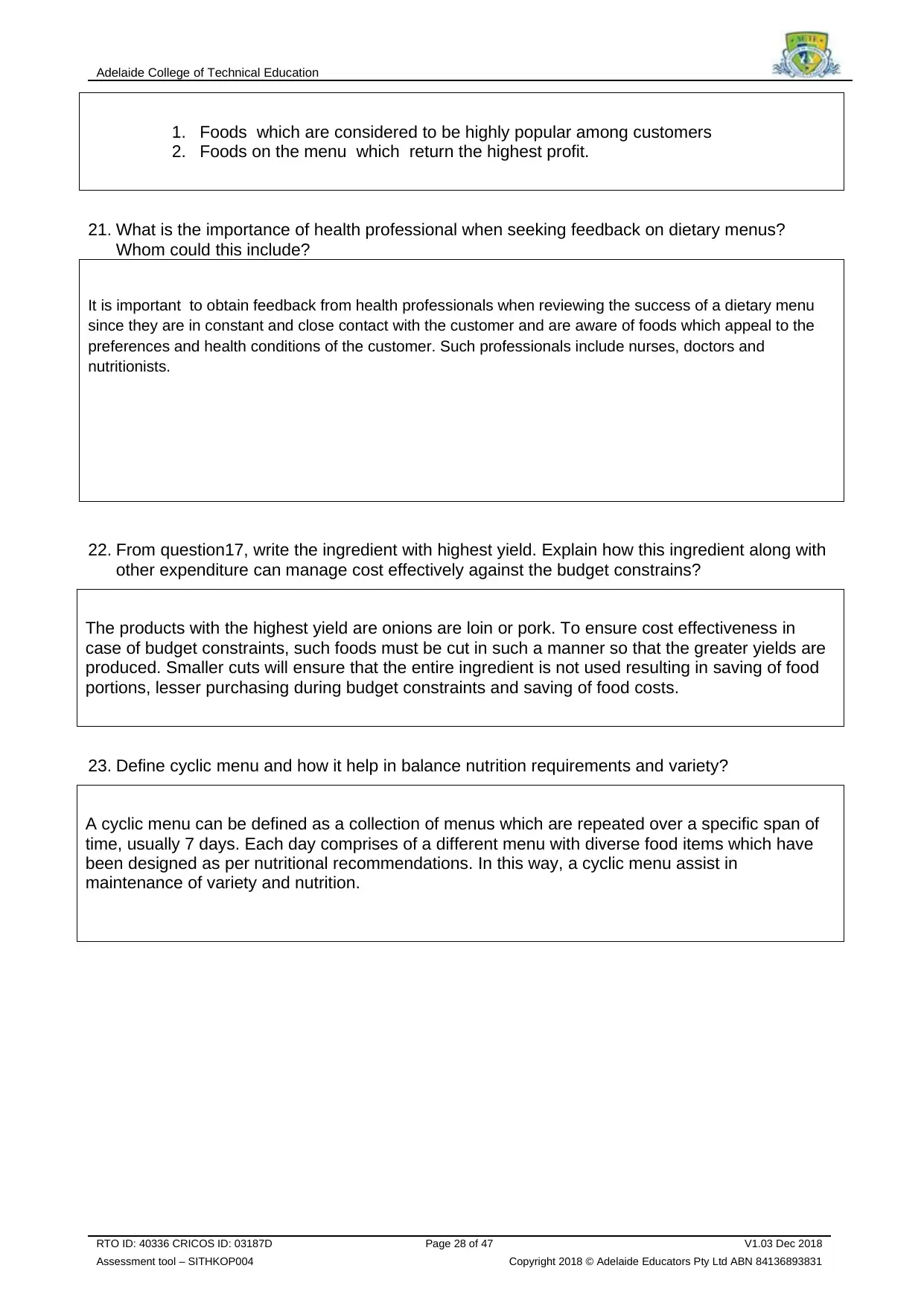
Adelaide College of Technical Education
1. Foods which are considered to be highly popular among customers
2. Foods on the menu which return the highest profit.
21. What is the importance of health professional when seeking feedback on dietary menus?
Whom could this include?
It is important to obtain feedback from health professionals when reviewing the success of a dietary menu
since they are in constant and close contact with the customer and are aware of foods which appeal to the
preferences and health conditions of the customer. Such professionals include nurses, doctors and
nutritionists.
22. From question17, write the ingredient with highest yield. Explain how this ingredient along with
other expenditure can manage cost effectively against the budget constrains?
The products with the highest yield are onions are loin or pork. To ensure cost effectiveness in
case of budget constraints, such foods must be cut in such a manner so that the greater yields are
produced. Smaller cuts will ensure that the entire ingredient is not used resulting in saving of food
portions, lesser purchasing during budget constraints and saving of food costs.
23. Define cyclic menu and how it help in balance nutrition requirements and variety?
A cyclic menu can be defined as a collection of menus which are repeated over a specific span of
time, usually 7 days. Each day comprises of a different menu with diverse food items which have
been designed as per nutritional recommendations. In this way, a cyclic menu assist in
maintenance of variety and nutrition.
RTO ID: 40336 CRICOS ID: 03187D Page 28 of 47 V1.03 Dec 2018
Assessment tool – SITHKOP004 Copyright 2018 © Adelaide Educators Pty Ltd ABN 84136893831
1. Foods which are considered to be highly popular among customers
2. Foods on the menu which return the highest profit.
21. What is the importance of health professional when seeking feedback on dietary menus?
Whom could this include?
It is important to obtain feedback from health professionals when reviewing the success of a dietary menu
since they are in constant and close contact with the customer and are aware of foods which appeal to the
preferences and health conditions of the customer. Such professionals include nurses, doctors and
nutritionists.
22. From question17, write the ingredient with highest yield. Explain how this ingredient along with
other expenditure can manage cost effectively against the budget constrains?
The products with the highest yield are onions are loin or pork. To ensure cost effectiveness in
case of budget constraints, such foods must be cut in such a manner so that the greater yields are
produced. Smaller cuts will ensure that the entire ingredient is not used resulting in saving of food
portions, lesser purchasing during budget constraints and saving of food costs.
23. Define cyclic menu and how it help in balance nutrition requirements and variety?
A cyclic menu can be defined as a collection of menus which are repeated over a specific span of
time, usually 7 days. Each day comprises of a different menu with diverse food items which have
been designed as per nutritional recommendations. In this way, a cyclic menu assist in
maintenance of variety and nutrition.
RTO ID: 40336 CRICOS ID: 03187D Page 28 of 47 V1.03 Dec 2018
Assessment tool – SITHKOP004 Copyright 2018 © Adelaide Educators Pty Ltd ABN 84136893831
Secure Best Marks with AI Grader
Need help grading? Try our AI Grader for instant feedback on your assignments.
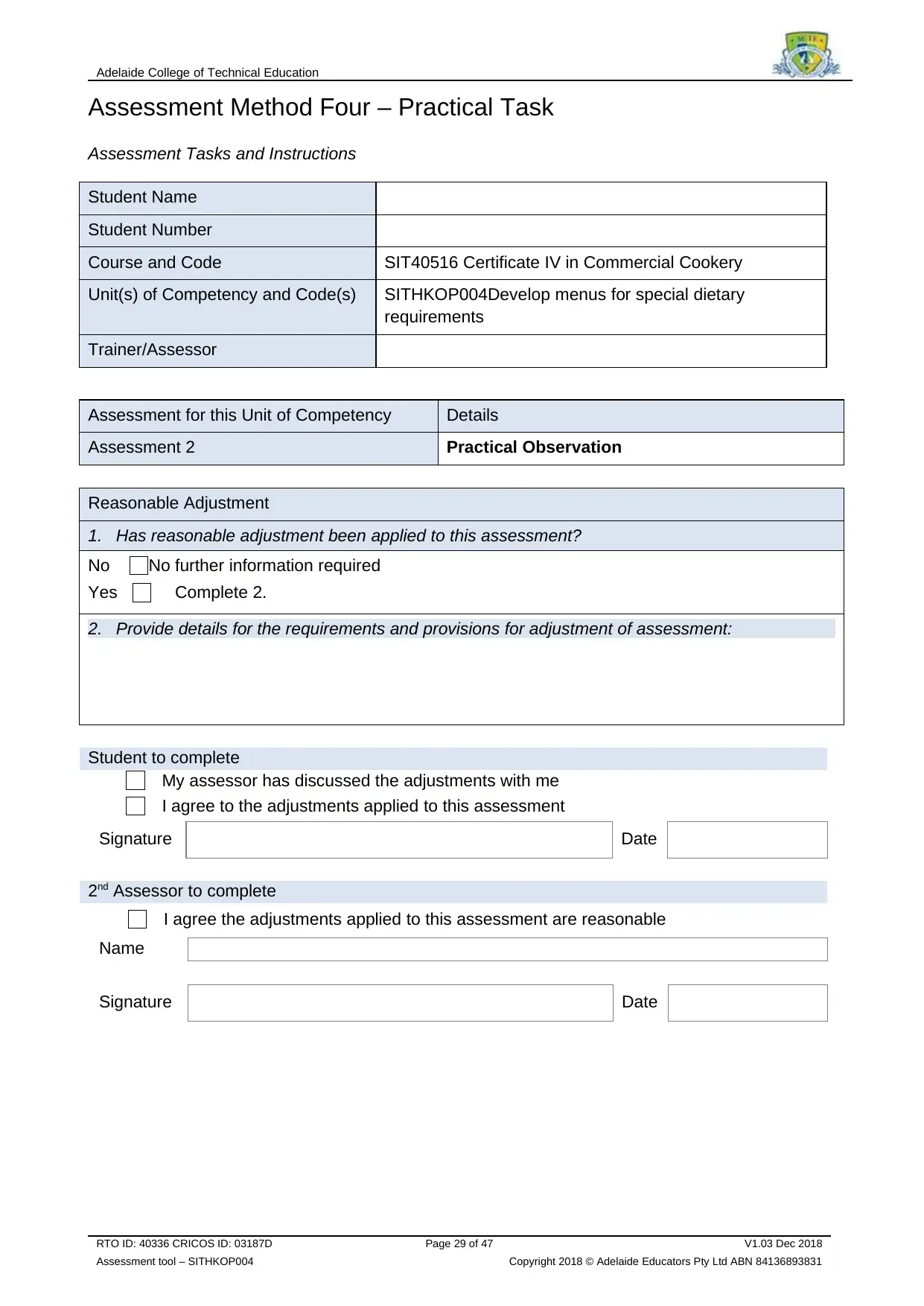
Adelaide College of Technical Education
Assessment Method Four – Practical Task
Assessment Tasks and Instructions
Student Name
Student Number
Course and Code SIT40516 Certificate IV in Commercial Cookery
Unit(s) of Competency and Code(s) SITHKOP004Develop menus for special dietary
requirements
Trainer/Assessor
Assessment for this Unit of Competency Details
Assessment 2 Practical Observation
Reasonable Adjustment
1. Has reasonable adjustment been applied to this assessment?
No No further information required
Yes Complete 2.
2. Provide details for the requirements and provisions for adjustment of assessment:
Student to complete
My assessor has discussed the adjustments with me
I agree to the adjustments applied to this assessment
Signature Date
2nd Assessor to complete
I agree the adjustments applied to this assessment are reasonable
Name
Signature Date
RTO ID: 40336 CRICOS ID: 03187D Page 29 of 47 V1.03 Dec 2018
Assessment tool – SITHKOP004 Copyright 2018 © Adelaide Educators Pty Ltd ABN 84136893831
Assessment Method Four – Practical Task
Assessment Tasks and Instructions
Student Name
Student Number
Course and Code SIT40516 Certificate IV in Commercial Cookery
Unit(s) of Competency and Code(s) SITHKOP004Develop menus for special dietary
requirements
Trainer/Assessor
Assessment for this Unit of Competency Details
Assessment 2 Practical Observation
Reasonable Adjustment
1. Has reasonable adjustment been applied to this assessment?
No No further information required
Yes Complete 2.
2. Provide details for the requirements and provisions for adjustment of assessment:
Student to complete
My assessor has discussed the adjustments with me
I agree to the adjustments applied to this assessment
Signature Date
2nd Assessor to complete
I agree the adjustments applied to this assessment are reasonable
Name
Signature Date
RTO ID: 40336 CRICOS ID: 03187D Page 29 of 47 V1.03 Dec 2018
Assessment tool – SITHKOP004 Copyright 2018 © Adelaide Educators Pty Ltd ABN 84136893831
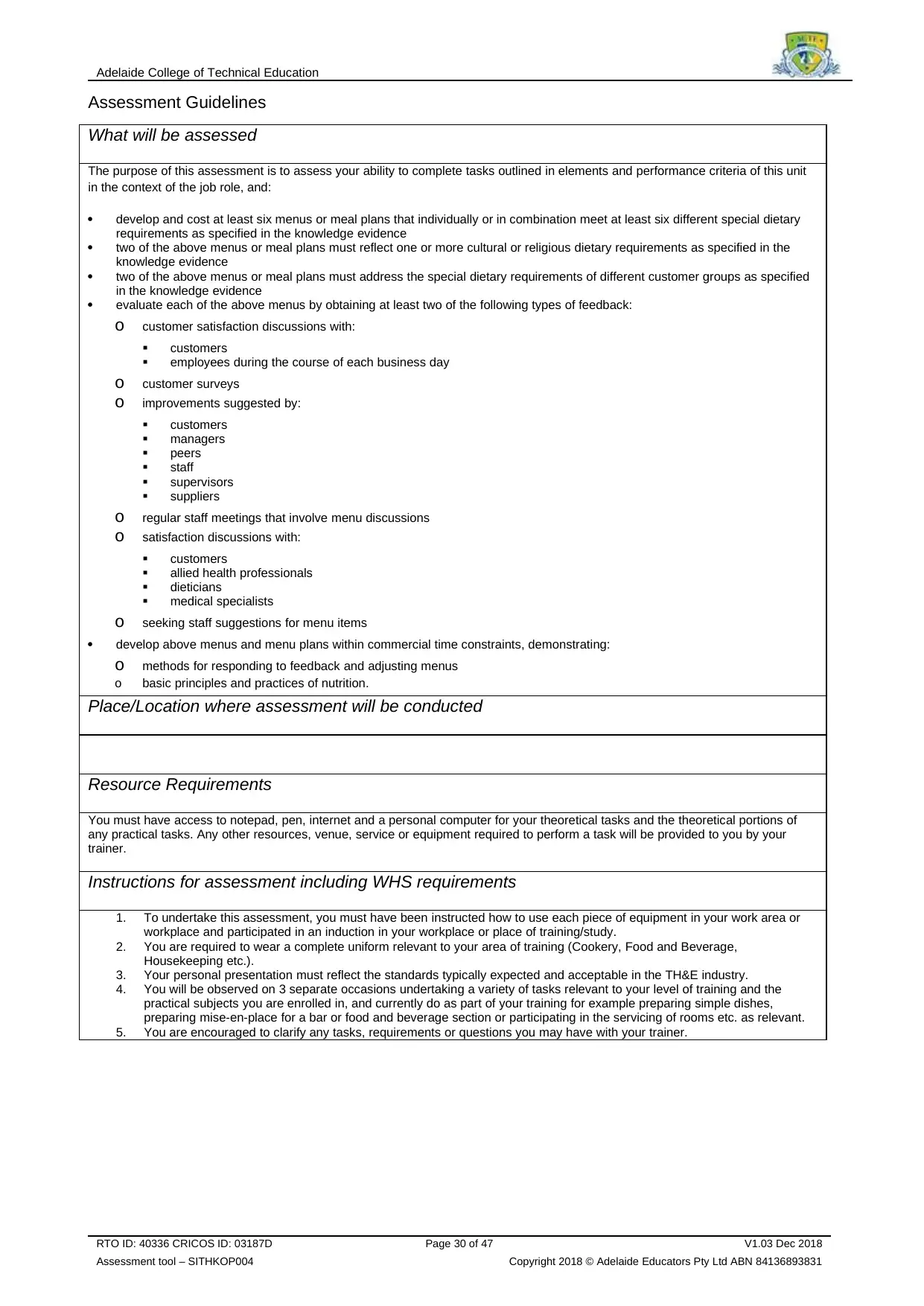
Adelaide College of Technical Education
Assessment Guidelines
What will be assessed
The purpose of this assessment is to assess your ability to complete tasks outlined in elements and performance criteria of this unit
in the context of the job role, and:
develop and cost at least six menus or meal plans that individually or in combination meet at least six different special dietary
requirements as specified in the knowledge evidence
two of the above menus or meal plans must reflect one or more cultural or religious dietary requirements as specified in the
knowledge evidence
two of the above menus or meal plans must address the special dietary requirements of different customer groups as specified
in the knowledge evidence
evaluate each of the above menus by obtaining at least two of the following types of feedback:
o customer satisfaction discussions with:
customers
employees during the course of each business day
o customer surveys
o improvements suggested by:
customers
managers
peers
staff
supervisors
suppliers
o regular staff meetings that involve menu discussions
o satisfaction discussions with:
customers
allied health professionals
dieticians
medical specialists
o seeking staff suggestions for menu items
develop above menus and menu plans within commercial time constraints, demonstrating:
o methods for responding to feedback and adjusting menus
o basic principles and practices of nutrition.
Place/Location where assessment will be conducted
Resource Requirements
You must have access to notepad, pen, internet and a personal computer for your theoretical tasks and the theoretical portions of
any practical tasks. Any other resources, venue, service or equipment required to perform a task will be provided to you by your
trainer.
Instructions for assessment including WHS requirements
1. To undertake this assessment, you must have been instructed how to use each piece of equipment in your work area or
workplace and participated in an induction in your workplace or place of training/study.
2. You are required to wear a complete uniform relevant to your area of training (Cookery, Food and Beverage,
Housekeeping etc.).
3. Your personal presentation must reflect the standards typically expected and acceptable in the TH&E industry.
4. You will be observed on 3 separate occasions undertaking a variety of tasks relevant to your level of training and the
practical subjects you are enrolled in, and currently do as part of your training for example preparing simple dishes,
preparing mise-en-place for a bar or food and beverage section or participating in the servicing of rooms etc. as relevant.
5. You are encouraged to clarify any tasks, requirements or questions you may have with your trainer.
RTO ID: 40336 CRICOS ID: 03187D Page 30 of 47 V1.03 Dec 2018
Assessment tool – SITHKOP004 Copyright 2018 © Adelaide Educators Pty Ltd ABN 84136893831
Assessment Guidelines
What will be assessed
The purpose of this assessment is to assess your ability to complete tasks outlined in elements and performance criteria of this unit
in the context of the job role, and:
develop and cost at least six menus or meal plans that individually or in combination meet at least six different special dietary
requirements as specified in the knowledge evidence
two of the above menus or meal plans must reflect one or more cultural or religious dietary requirements as specified in the
knowledge evidence
two of the above menus or meal plans must address the special dietary requirements of different customer groups as specified
in the knowledge evidence
evaluate each of the above menus by obtaining at least two of the following types of feedback:
o customer satisfaction discussions with:
customers
employees during the course of each business day
o customer surveys
o improvements suggested by:
customers
managers
peers
staff
supervisors
suppliers
o regular staff meetings that involve menu discussions
o satisfaction discussions with:
customers
allied health professionals
dieticians
medical specialists
o seeking staff suggestions for menu items
develop above menus and menu plans within commercial time constraints, demonstrating:
o methods for responding to feedback and adjusting menus
o basic principles and practices of nutrition.
Place/Location where assessment will be conducted
Resource Requirements
You must have access to notepad, pen, internet and a personal computer for your theoretical tasks and the theoretical portions of
any practical tasks. Any other resources, venue, service or equipment required to perform a task will be provided to you by your
trainer.
Instructions for assessment including WHS requirements
1. To undertake this assessment, you must have been instructed how to use each piece of equipment in your work area or
workplace and participated in an induction in your workplace or place of training/study.
2. You are required to wear a complete uniform relevant to your area of training (Cookery, Food and Beverage,
Housekeeping etc.).
3. Your personal presentation must reflect the standards typically expected and acceptable in the TH&E industry.
4. You will be observed on 3 separate occasions undertaking a variety of tasks relevant to your level of training and the
practical subjects you are enrolled in, and currently do as part of your training for example preparing simple dishes,
preparing mise-en-place for a bar or food and beverage section or participating in the servicing of rooms etc. as relevant.
5. You are encouraged to clarify any tasks, requirements or questions you may have with your trainer.
RTO ID: 40336 CRICOS ID: 03187D Page 30 of 47 V1.03 Dec 2018
Assessment tool – SITHKOP004 Copyright 2018 © Adelaide Educators Pty Ltd ABN 84136893831
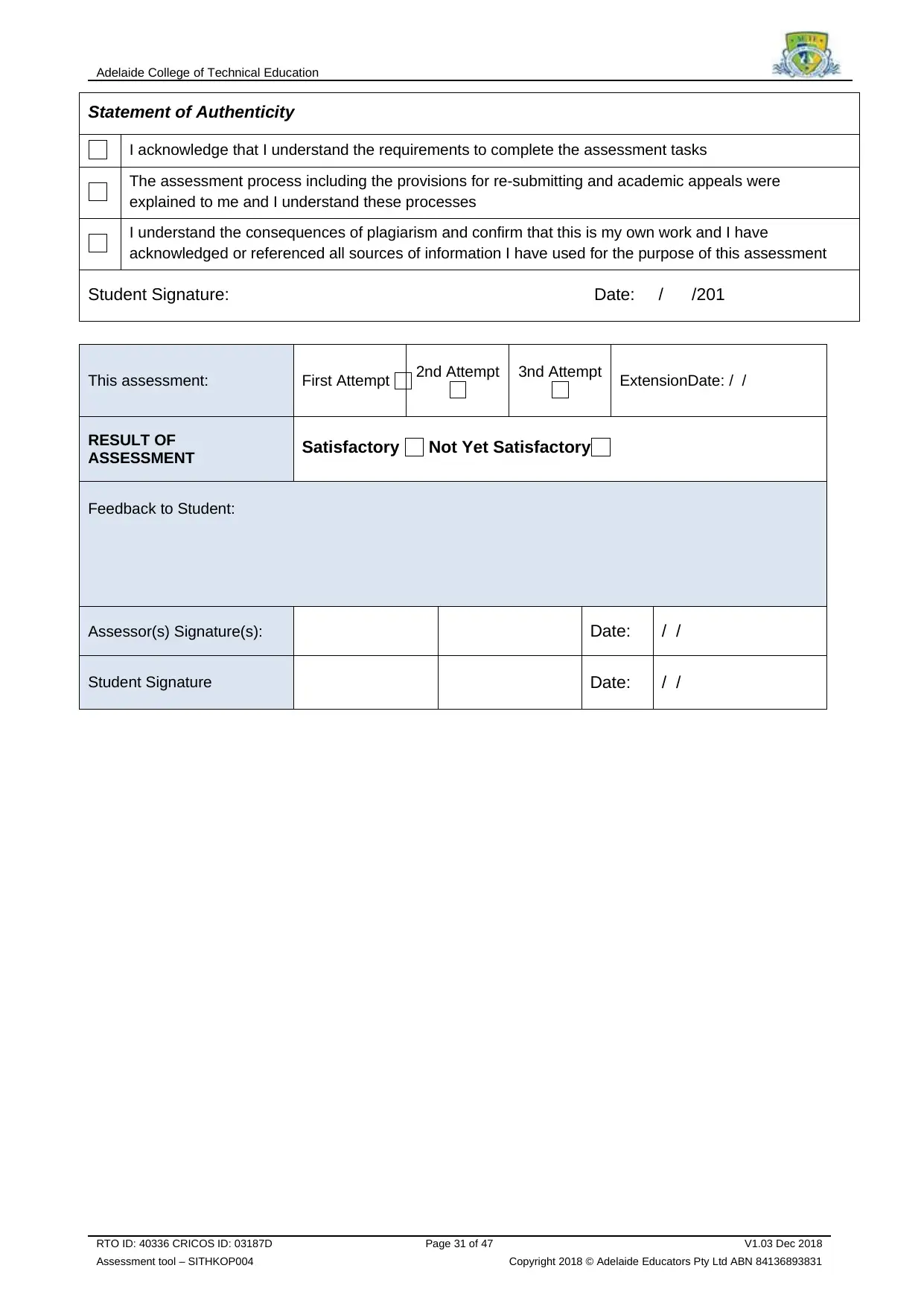
Adelaide College of Technical Education
Statement of Authenticity
I acknowledge that I understand the requirements to complete the assessment tasks
The assessment process including the provisions for re-submitting and academic appeals were
explained to me and I understand these processes
I understand the consequences of plagiarism and confirm that this is my own work and I have
acknowledged or referenced all sources of information I have used for the purpose of this assessment
Student Signature: Date: / /201
This assessment: First Attempt 2nd Attempt 3nd Attempt ExtensionDate: / /
RESULT OF
ASSESSMENT Satisfactory Not Yet Satisfactory
Feedback to Student:
Assessor(s) Signature(s): Date: / /
Student Signature Date: / /
RTO ID: 40336 CRICOS ID: 03187D Page 31 of 47 V1.03 Dec 2018
Assessment tool – SITHKOP004 Copyright 2018 © Adelaide Educators Pty Ltd ABN 84136893831
Statement of Authenticity
I acknowledge that I understand the requirements to complete the assessment tasks
The assessment process including the provisions for re-submitting and academic appeals were
explained to me and I understand these processes
I understand the consequences of plagiarism and confirm that this is my own work and I have
acknowledged or referenced all sources of information I have used for the purpose of this assessment
Student Signature: Date: / /201
This assessment: First Attempt 2nd Attempt 3nd Attempt ExtensionDate: / /
RESULT OF
ASSESSMENT Satisfactory Not Yet Satisfactory
Feedback to Student:
Assessor(s) Signature(s): Date: / /
Student Signature Date: / /
RTO ID: 40336 CRICOS ID: 03187D Page 31 of 47 V1.03 Dec 2018
Assessment tool – SITHKOP004 Copyright 2018 © Adelaide Educators Pty Ltd ABN 84136893831
Paraphrase This Document
Need a fresh take? Get an instant paraphrase of this document with our AI Paraphraser
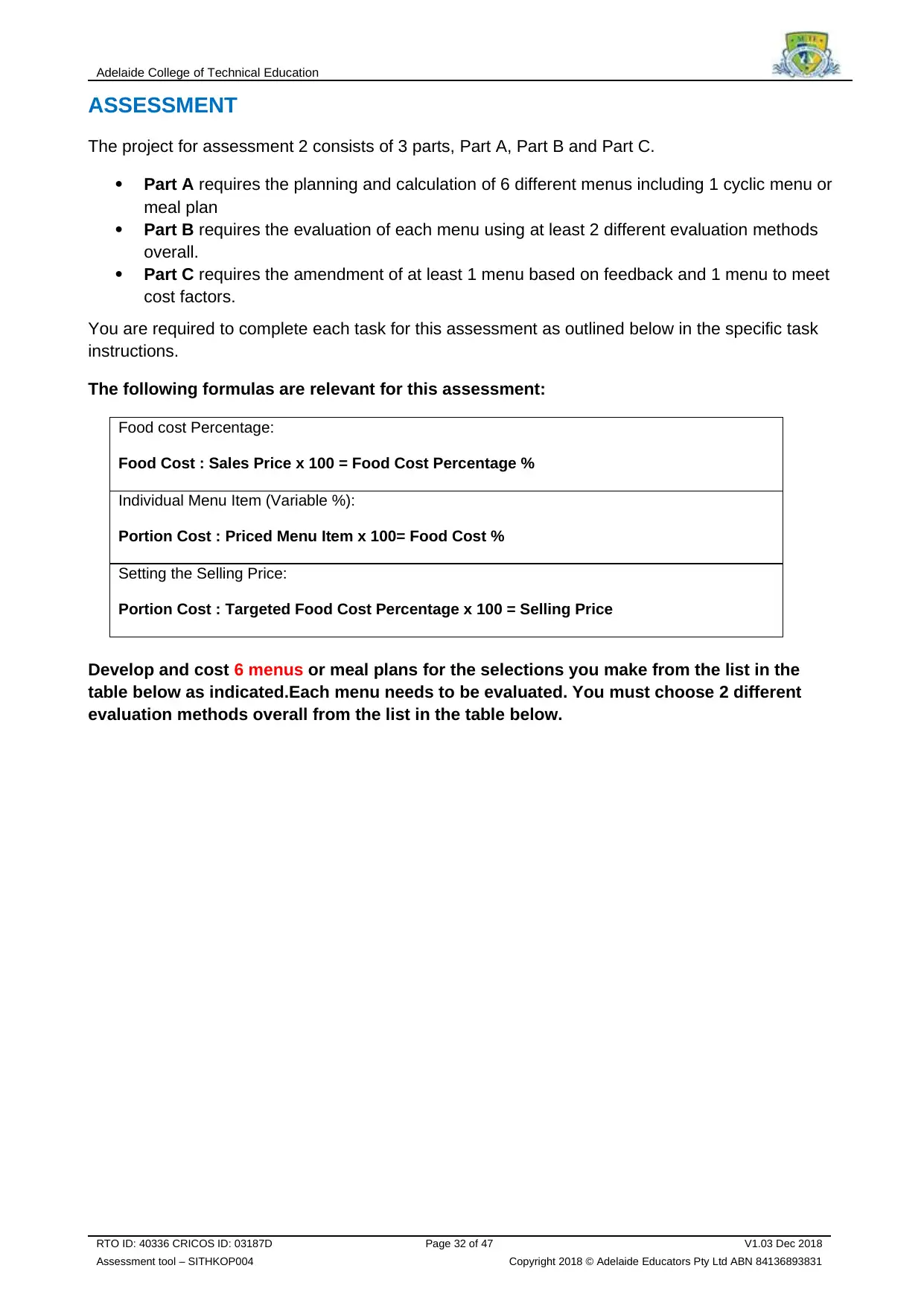
Adelaide College of Technical Education
ASSESSMENT
The project for assessment 2 consists of 3 parts, Part A, Part B and Part C.
Part A requires the planning and calculation of 6 different menus including 1 cyclic menu or
meal plan
Part B requires the evaluation of each menu using at least 2 different evaluation methods
overall.
Part C requires the amendment of at least 1 menu based on feedback and 1 menu to meet
cost factors.
You are required to complete each task for this assessment as outlined below in the specific task
instructions.
The following formulas are relevant for this assessment:
Food cost Percentage:
Food Cost : Sales Price x 100 = Food Cost Percentage %
Individual Menu Item (Variable %):
Portion Cost : Priced Menu Item x 100= Food Cost %
Setting the Selling Price:
Portion Cost : Targeted Food Cost Percentage x 100 = Selling Price
Develop and cost 6 menus or meal plans for the selections you make from the list in the
table below as indicated.Each menu needs to be evaluated. You must choose 2 different
evaluation methods overall from the list in the table below.
RTO ID: 40336 CRICOS ID: 03187D Page 32 of 47 V1.03 Dec 2018
Assessment tool – SITHKOP004 Copyright 2018 © Adelaide Educators Pty Ltd ABN 84136893831
ASSESSMENT
The project for assessment 2 consists of 3 parts, Part A, Part B and Part C.
Part A requires the planning and calculation of 6 different menus including 1 cyclic menu or
meal plan
Part B requires the evaluation of each menu using at least 2 different evaluation methods
overall.
Part C requires the amendment of at least 1 menu based on feedback and 1 menu to meet
cost factors.
You are required to complete each task for this assessment as outlined below in the specific task
instructions.
The following formulas are relevant for this assessment:
Food cost Percentage:
Food Cost : Sales Price x 100 = Food Cost Percentage %
Individual Menu Item (Variable %):
Portion Cost : Priced Menu Item x 100= Food Cost %
Setting the Selling Price:
Portion Cost : Targeted Food Cost Percentage x 100 = Selling Price
Develop and cost 6 menus or meal plans for the selections you make from the list in the
table below as indicated.Each menu needs to be evaluated. You must choose 2 different
evaluation methods overall from the list in the table below.
RTO ID: 40336 CRICOS ID: 03187D Page 32 of 47 V1.03 Dec 2018
Assessment tool – SITHKOP004 Copyright 2018 © Adelaide Educators Pty Ltd ABN 84136893831
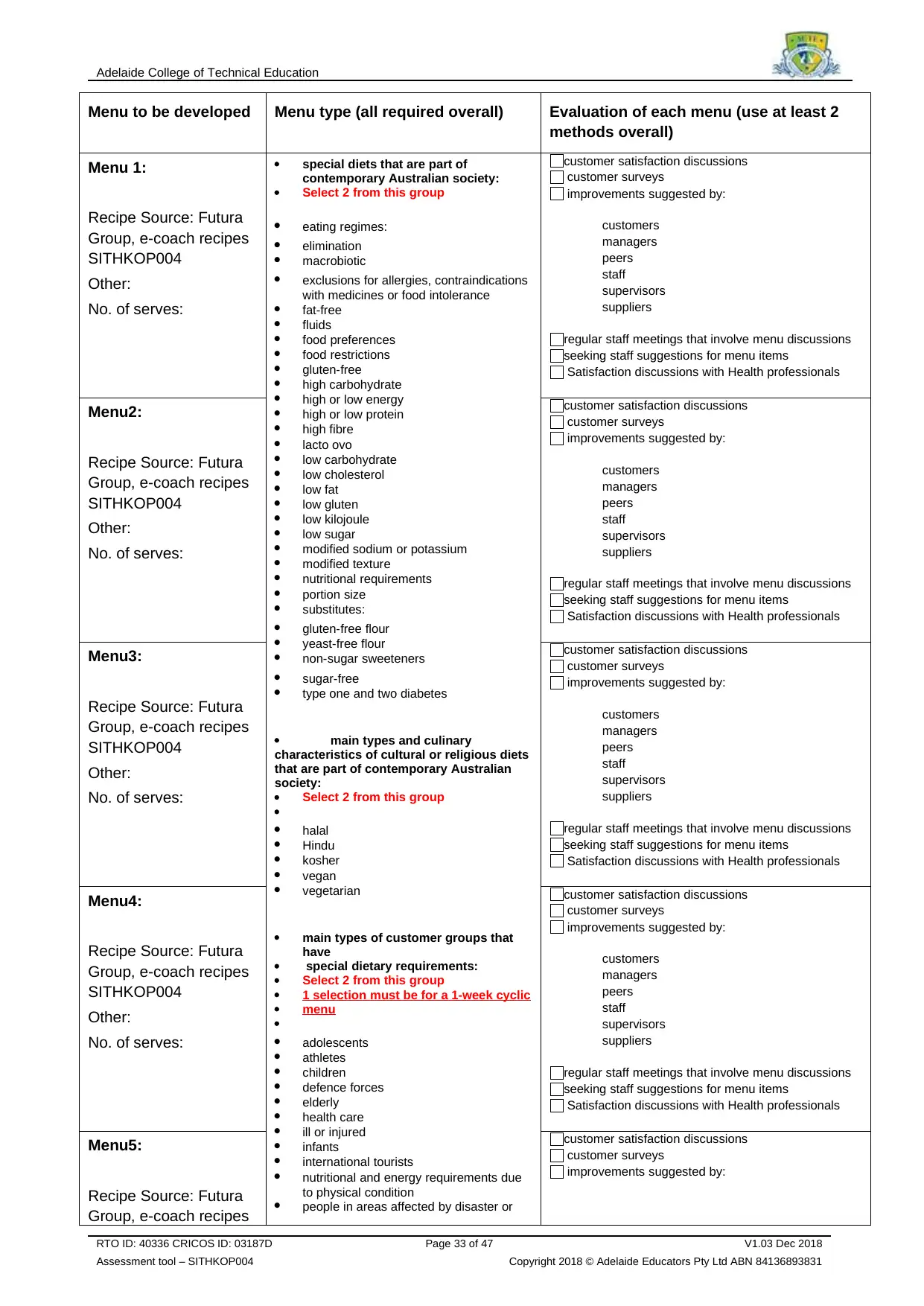
Adelaide College of Technical Education
Menu to be developed Menu type (all required overall) Evaluation of each menu (use at least 2
methods overall)
Menu 1:
Recipe Source: Futura
Group, e-coach recipes
SITHKOP004
Other:
No. of serves:
special diets that are part of
contemporary Australian society:
Select 2 from this group
eating regimes:
elimination
macrobiotic
exclusions for allergies, contraindications
with medicines or food intolerance
fat-free
fluids
food preferences
food restrictions
gluten-free
high carbohydrate
high or low energy
high or low protein
high fibre
lacto ovo
low carbohydrate
low cholesterol
low fat
low gluten
low kilojoule
low sugar
modified sodium or potassium
modified texture
nutritional requirements
portion size
substitutes:
gluten-free flour
yeast-free flour
non-sugar sweeteners
sugar-free
type one and two diabetes
main types and culinary
characteristics of cultural or religious diets
that are part of contemporary Australian
society:
Select 2 from this group
halal
Hindu
kosher
vegan
vegetarian
main types of customer groups that
have
special dietary requirements:
Select 2 from this group
1 selection must be for a 1-week cyclic
menu
adolescents
athletes
children
defence forces
elderly
health care
ill or injured
infants
international tourists
nutritional and energy requirements due
to physical condition
people in areas affected by disaster or
customer satisfaction discussions
customer surveys
improvements suggested by:
customers
managers
peers
staff
supervisors
suppliers
regular staff meetings that involve menu discussions
seeking staff suggestions for menu items
Satisfaction discussions with Health professionals
Menu2:
Recipe Source: Futura
Group, e-coach recipes
SITHKOP004
Other:
No. of serves:
customer satisfaction discussions
customer surveys
improvements suggested by:
customers
managers
peers
staff
supervisors
suppliers
regular staff meetings that involve menu discussions
seeking staff suggestions for menu items
Satisfaction discussions with Health professionals
Menu3:
Recipe Source: Futura
Group, e-coach recipes
SITHKOP004
Other:
No. of serves:
customer satisfaction discussions
customer surveys
improvements suggested by:
customers
managers
peers
staff
supervisors
suppliers
regular staff meetings that involve menu discussions
seeking staff suggestions for menu items
Satisfaction discussions with Health professionals
Menu4:
Recipe Source: Futura
Group, e-coach recipes
SITHKOP004
Other:
No. of serves:
customer satisfaction discussions
customer surveys
improvements suggested by:
customers
managers
peers
staff
supervisors
suppliers
regular staff meetings that involve menu discussions
seeking staff suggestions for menu items
Satisfaction discussions with Health professionals
Menu5:
Recipe Source: Futura
Group, e-coach recipes
customer satisfaction discussions
customer surveys
improvements suggested by:
RTO ID: 40336 CRICOS ID: 03187D Page 33 of 47 V1.03 Dec 2018
Assessment tool – SITHKOP004 Copyright 2018 © Adelaide Educators Pty Ltd ABN 84136893831
Menu to be developed Menu type (all required overall) Evaluation of each menu (use at least 2
methods overall)
Menu 1:
Recipe Source: Futura
Group, e-coach recipes
SITHKOP004
Other:
No. of serves:
special diets that are part of
contemporary Australian society:
Select 2 from this group
eating regimes:
elimination
macrobiotic
exclusions for allergies, contraindications
with medicines or food intolerance
fat-free
fluids
food preferences
food restrictions
gluten-free
high carbohydrate
high or low energy
high or low protein
high fibre
lacto ovo
low carbohydrate
low cholesterol
low fat
low gluten
low kilojoule
low sugar
modified sodium or potassium
modified texture
nutritional requirements
portion size
substitutes:
gluten-free flour
yeast-free flour
non-sugar sweeteners
sugar-free
type one and two diabetes
main types and culinary
characteristics of cultural or religious diets
that are part of contemporary Australian
society:
Select 2 from this group
halal
Hindu
kosher
vegan
vegetarian
main types of customer groups that
have
special dietary requirements:
Select 2 from this group
1 selection must be for a 1-week cyclic
menu
adolescents
athletes
children
defence forces
elderly
health care
ill or injured
infants
international tourists
nutritional and energy requirements due
to physical condition
people in areas affected by disaster or
customer satisfaction discussions
customer surveys
improvements suggested by:
customers
managers
peers
staff
supervisors
suppliers
regular staff meetings that involve menu discussions
seeking staff suggestions for menu items
Satisfaction discussions with Health professionals
Menu2:
Recipe Source: Futura
Group, e-coach recipes
SITHKOP004
Other:
No. of serves:
customer satisfaction discussions
customer surveys
improvements suggested by:
customers
managers
peers
staff
supervisors
suppliers
regular staff meetings that involve menu discussions
seeking staff suggestions for menu items
Satisfaction discussions with Health professionals
Menu3:
Recipe Source: Futura
Group, e-coach recipes
SITHKOP004
Other:
No. of serves:
customer satisfaction discussions
customer surveys
improvements suggested by:
customers
managers
peers
staff
supervisors
suppliers
regular staff meetings that involve menu discussions
seeking staff suggestions for menu items
Satisfaction discussions with Health professionals
Menu4:
Recipe Source: Futura
Group, e-coach recipes
SITHKOP004
Other:
No. of serves:
customer satisfaction discussions
customer surveys
improvements suggested by:
customers
managers
peers
staff
supervisors
suppliers
regular staff meetings that involve menu discussions
seeking staff suggestions for menu items
Satisfaction discussions with Health professionals
Menu5:
Recipe Source: Futura
Group, e-coach recipes
customer satisfaction discussions
customer surveys
improvements suggested by:
RTO ID: 40336 CRICOS ID: 03187D Page 33 of 47 V1.03 Dec 2018
Assessment tool – SITHKOP004 Copyright 2018 © Adelaide Educators Pty Ltd ABN 84136893831
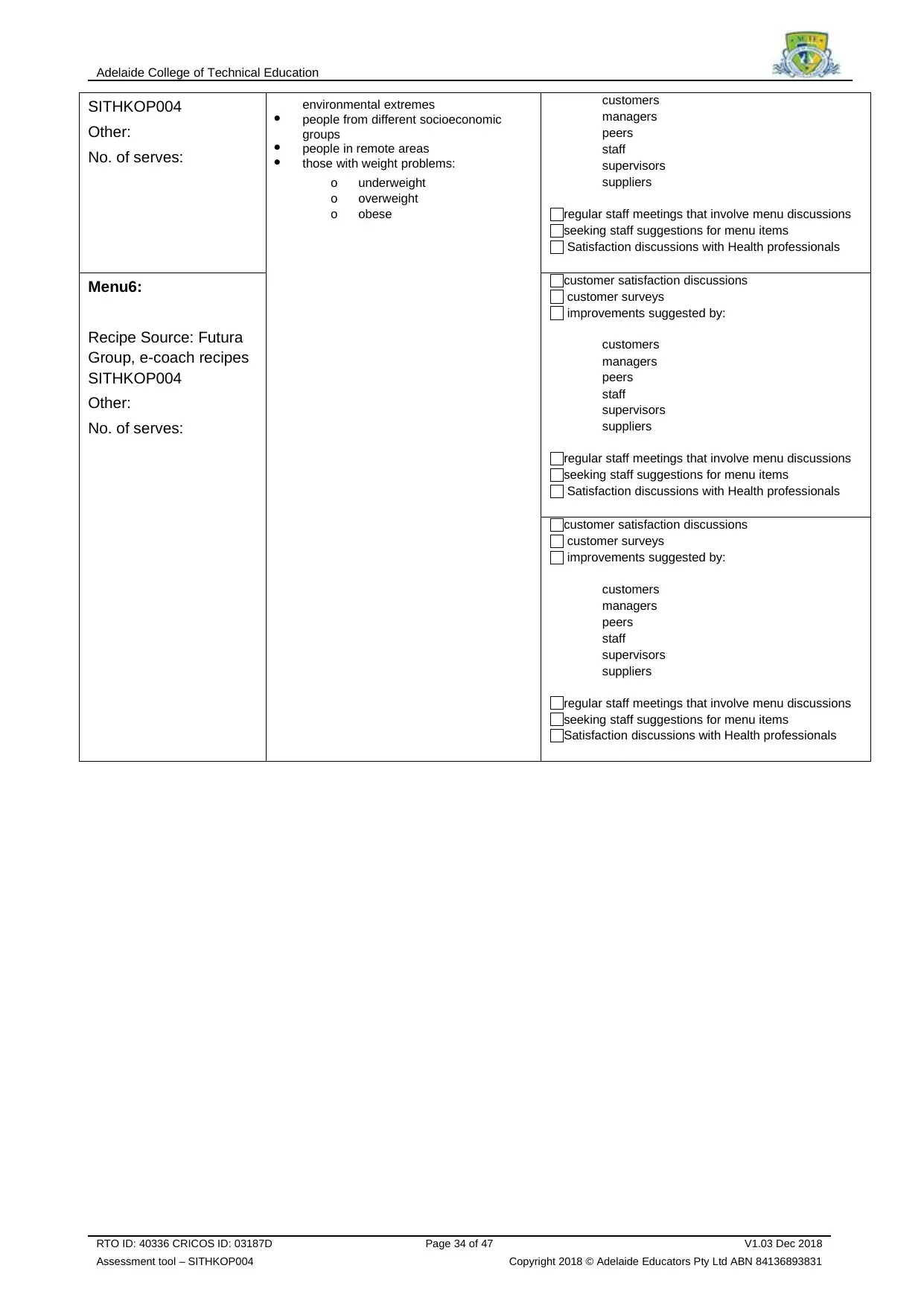
Adelaide College of Technical Education
SITHKOP004
Other:
No. of serves:
environmental extremes
people from different socioeconomic
groups
people in remote areas
those with weight problems:
o underweight
o overweight
o obese
customers
managers
peers
staff
supervisors
suppliers
regular staff meetings that involve menu discussions
seeking staff suggestions for menu items
Satisfaction discussions with Health professionals
Menu6:
Recipe Source: Futura
Group, e-coach recipes
SITHKOP004
Other:
No. of serves:
customer satisfaction discussions
customer surveys
improvements suggested by:
customers
managers
peers
staff
supervisors
suppliers
regular staff meetings that involve menu discussions
seeking staff suggestions for menu items
Satisfaction discussions with Health professionals
customer satisfaction discussions
customer surveys
improvements suggested by:
customers
managers
peers
staff
supervisors
suppliers
regular staff meetings that involve menu discussions
seeking staff suggestions for menu items
Satisfaction discussions with Health professionals
RTO ID: 40336 CRICOS ID: 03187D Page 34 of 47 V1.03 Dec 2018
Assessment tool – SITHKOP004 Copyright 2018 © Adelaide Educators Pty Ltd ABN 84136893831
SITHKOP004
Other:
No. of serves:
environmental extremes
people from different socioeconomic
groups
people in remote areas
those with weight problems:
o underweight
o overweight
o obese
customers
managers
peers
staff
supervisors
suppliers
regular staff meetings that involve menu discussions
seeking staff suggestions for menu items
Satisfaction discussions with Health professionals
Menu6:
Recipe Source: Futura
Group, e-coach recipes
SITHKOP004
Other:
No. of serves:
customer satisfaction discussions
customer surveys
improvements suggested by:
customers
managers
peers
staff
supervisors
suppliers
regular staff meetings that involve menu discussions
seeking staff suggestions for menu items
Satisfaction discussions with Health professionals
customer satisfaction discussions
customer surveys
improvements suggested by:
customers
managers
peers
staff
supervisors
suppliers
regular staff meetings that involve menu discussions
seeking staff suggestions for menu items
Satisfaction discussions with Health professionals
RTO ID: 40336 CRICOS ID: 03187D Page 34 of 47 V1.03 Dec 2018
Assessment tool – SITHKOP004 Copyright 2018 © Adelaide Educators Pty Ltd ABN 84136893831
Secure Best Marks with AI Grader
Need help grading? Try our AI Grader for instant feedback on your assignments.
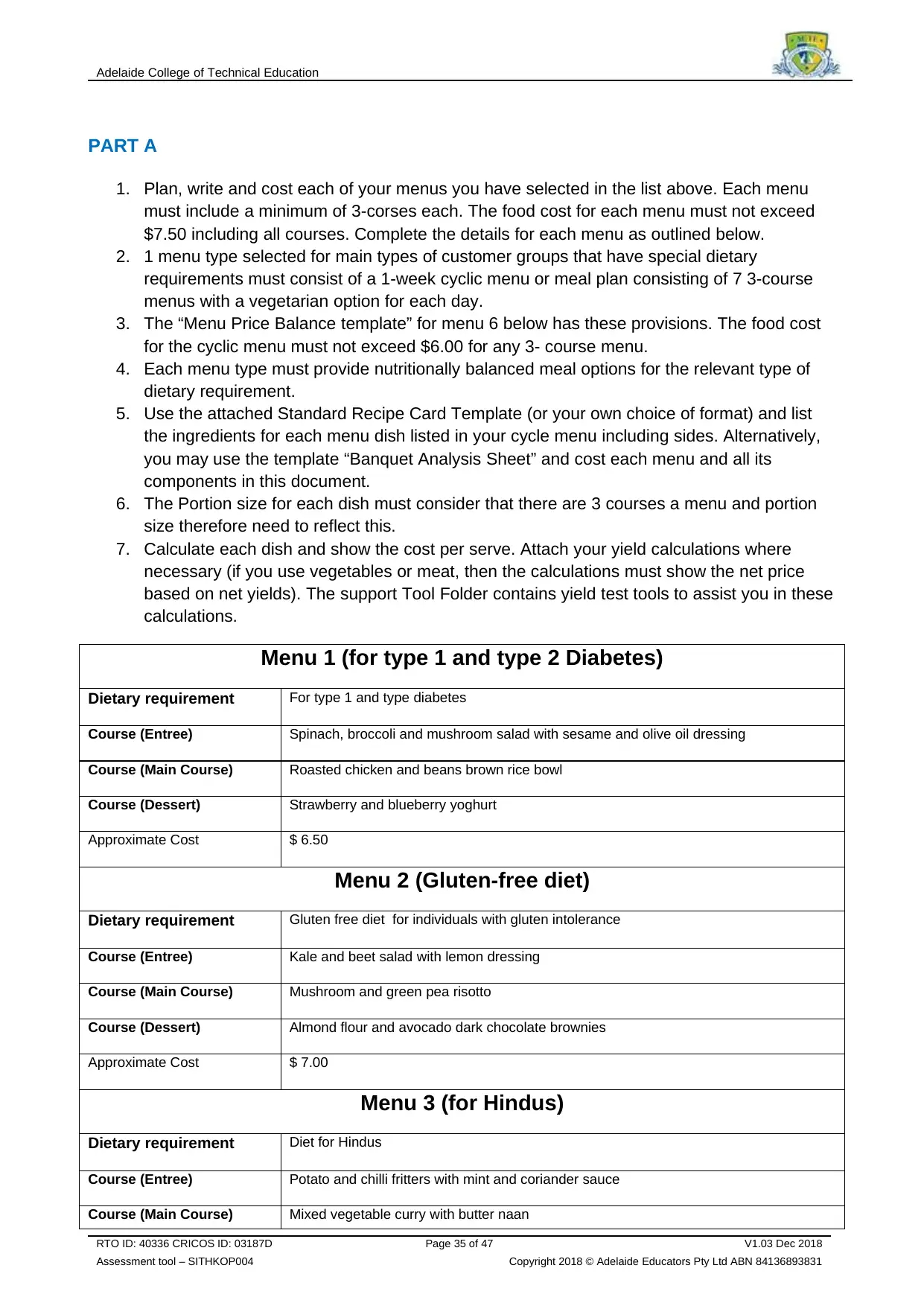
Adelaide College of Technical Education
PART A
1. Plan, write and cost each of your menus you have selected in the list above. Each menu
must include a minimum of 3-corses each. The food cost for each menu must not exceed
$7.50 including all courses. Complete the details for each menu as outlined below.
2. 1 menu type selected for main types of customer groups that have special dietary
requirements must consist of a 1-week cyclic menu or meal plan consisting of 7 3-course
menus with a vegetarian option for each day.
3. The “Menu Price Balance template” for menu 6 below has these provisions. The food cost
for the cyclic menu must not exceed $6.00 for any 3- course menu.
4. Each menu type must provide nutritionally balanced meal options for the relevant type of
dietary requirement.
5. Use the attached Standard Recipe Card Template (or your own choice of format) and list
the ingredients for each menu dish listed in your cycle menu including sides. Alternatively,
you may use the template “Banquet Analysis Sheet” and cost each menu and all its
components in this document.
6. The Portion size for each dish must consider that there are 3 courses a menu and portion
size therefore need to reflect this.
7. Calculate each dish and show the cost per serve. Attach your yield calculations where
necessary (if you use vegetables or meat, then the calculations must show the net price
based on net yields). The support Tool Folder contains yield test tools to assist you in these
calculations.
Menu 1 (for type 1 and type 2 Diabetes)
Dietary requirement For type 1 and type diabetes
Course (Entree) Spinach, broccoli and mushroom salad with sesame and olive oil dressing
Course (Main Course) Roasted chicken and beans brown rice bowl
Course (Dessert) Strawberry and blueberry yoghurt
Approximate Cost $ 6.50
Menu 2 (Gluten-free diet)
Dietary requirement Gluten free diet for individuals with gluten intolerance
Course (Entree) Kale and beet salad with lemon dressing
Course (Main Course) Mushroom and green pea risotto
Course (Dessert) Almond flour and avocado dark chocolate brownies
Approximate Cost $ 7.00
Menu 3 (for Hindus)
Dietary requirement Diet for Hindus
Course (Entree) Potato and chilli fritters with mint and coriander sauce
Course (Main Course) Mixed vegetable curry with butter naan
RTO ID: 40336 CRICOS ID: 03187D Page 35 of 47 V1.03 Dec 2018
Assessment tool – SITHKOP004 Copyright 2018 © Adelaide Educators Pty Ltd ABN 84136893831
PART A
1. Plan, write and cost each of your menus you have selected in the list above. Each menu
must include a minimum of 3-corses each. The food cost for each menu must not exceed
$7.50 including all courses. Complete the details for each menu as outlined below.
2. 1 menu type selected for main types of customer groups that have special dietary
requirements must consist of a 1-week cyclic menu or meal plan consisting of 7 3-course
menus with a vegetarian option for each day.
3. The “Menu Price Balance template” for menu 6 below has these provisions. The food cost
for the cyclic menu must not exceed $6.00 for any 3- course menu.
4. Each menu type must provide nutritionally balanced meal options for the relevant type of
dietary requirement.
5. Use the attached Standard Recipe Card Template (or your own choice of format) and list
the ingredients for each menu dish listed in your cycle menu including sides. Alternatively,
you may use the template “Banquet Analysis Sheet” and cost each menu and all its
components in this document.
6. The Portion size for each dish must consider that there are 3 courses a menu and portion
size therefore need to reflect this.
7. Calculate each dish and show the cost per serve. Attach your yield calculations where
necessary (if you use vegetables or meat, then the calculations must show the net price
based on net yields). The support Tool Folder contains yield test tools to assist you in these
calculations.
Menu 1 (for type 1 and type 2 Diabetes)
Dietary requirement For type 1 and type diabetes
Course (Entree) Spinach, broccoli and mushroom salad with sesame and olive oil dressing
Course (Main Course) Roasted chicken and beans brown rice bowl
Course (Dessert) Strawberry and blueberry yoghurt
Approximate Cost $ 6.50
Menu 2 (Gluten-free diet)
Dietary requirement Gluten free diet for individuals with gluten intolerance
Course (Entree) Kale and beet salad with lemon dressing
Course (Main Course) Mushroom and green pea risotto
Course (Dessert) Almond flour and avocado dark chocolate brownies
Approximate Cost $ 7.00
Menu 3 (for Hindus)
Dietary requirement Diet for Hindus
Course (Entree) Potato and chilli fritters with mint and coriander sauce
Course (Main Course) Mixed vegetable curry with butter naan
RTO ID: 40336 CRICOS ID: 03187D Page 35 of 47 V1.03 Dec 2018
Assessment tool – SITHKOP004 Copyright 2018 © Adelaide Educators Pty Ltd ABN 84136893831
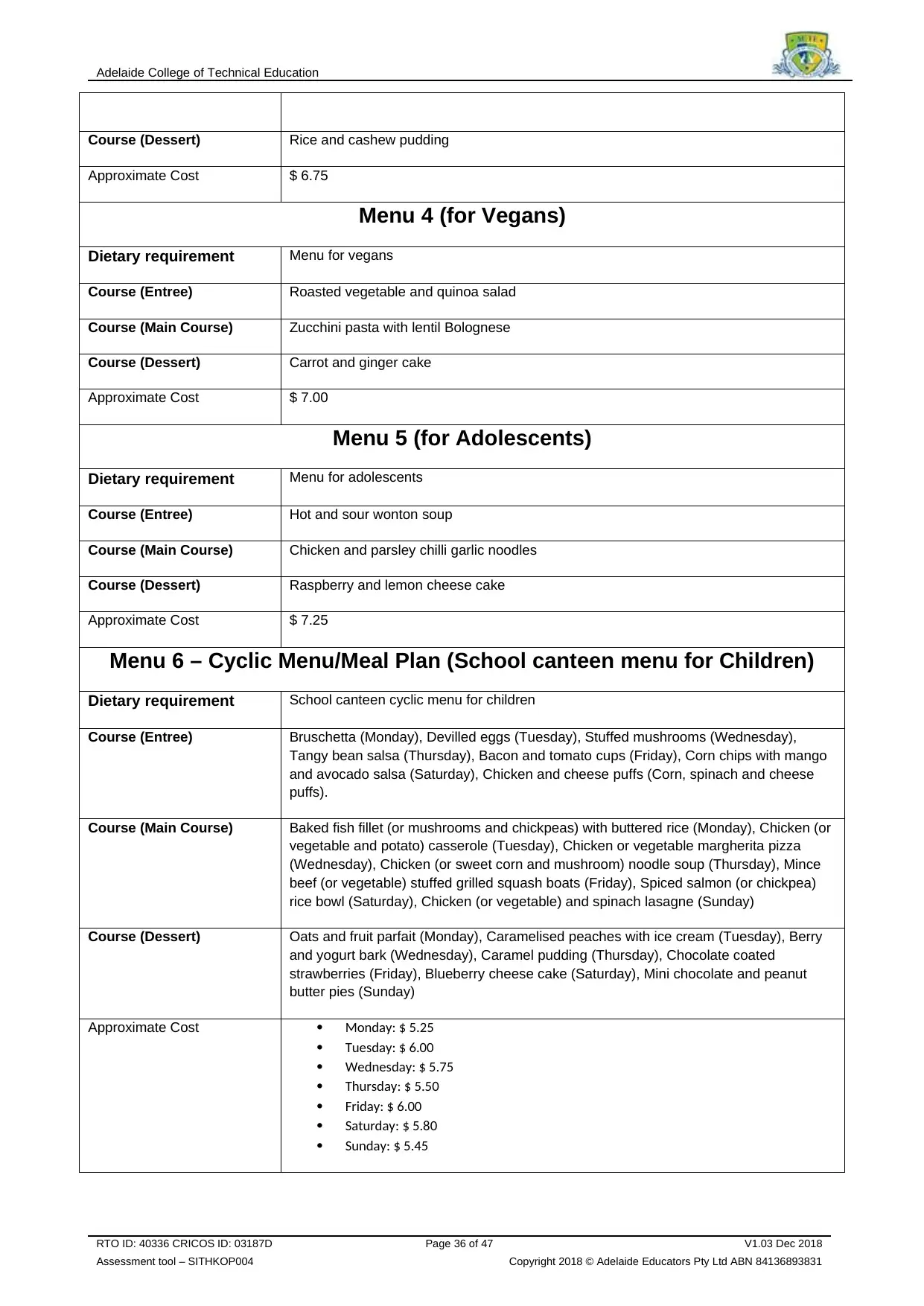
Adelaide College of Technical Education
Course (Dessert) Rice and cashew pudding
Approximate Cost $ 6.75
Menu 4 (for Vegans)
Dietary requirement Menu for vegans
Course (Entree) Roasted vegetable and quinoa salad
Course (Main Course) Zucchini pasta with lentil Bolognese
Course (Dessert) Carrot and ginger cake
Approximate Cost $ 7.00
Menu 5 (for Adolescents)
Dietary requirement Menu for adolescents
Course (Entree) Hot and sour wonton soup
Course (Main Course) Chicken and parsley chilli garlic noodles
Course (Dessert) Raspberry and lemon cheese cake
Approximate Cost $ 7.25
Menu 6 – Cyclic Menu/Meal Plan (School canteen menu for Children)
Dietary requirement School canteen cyclic menu for children
Course (Entree) Bruschetta (Monday), Devilled eggs (Tuesday), Stuffed mushrooms (Wednesday),
Tangy bean salsa (Thursday), Bacon and tomato cups (Friday), Corn chips with mango
and avocado salsa (Saturday), Chicken and cheese puffs (Corn, spinach and cheese
puffs).
Course (Main Course) Baked fish fillet (or mushrooms and chickpeas) with buttered rice (Monday), Chicken (or
vegetable and potato) casserole (Tuesday), Chicken or vegetable margherita pizza
(Wednesday), Chicken (or sweet corn and mushroom) noodle soup (Thursday), Mince
beef (or vegetable) stuffed grilled squash boats (Friday), Spiced salmon (or chickpea)
rice bowl (Saturday), Chicken (or vegetable) and spinach lasagne (Sunday)
Course (Dessert) Oats and fruit parfait (Monday), Caramelised peaches with ice cream (Tuesday), Berry
and yogurt bark (Wednesday), Caramel pudding (Thursday), Chocolate coated
strawberries (Friday), Blueberry cheese cake (Saturday), Mini chocolate and peanut
butter pies (Sunday)
Approximate Cost Monday: $ 5.25
Tuesday: $ 6.00
Wednesday: $ 5.75
Thursday: $ 5.50
Friday: $ 6.00
Saturday: $ 5.80
Sunday: $ 5.45
RTO ID: 40336 CRICOS ID: 03187D Page 36 of 47 V1.03 Dec 2018
Assessment tool – SITHKOP004 Copyright 2018 © Adelaide Educators Pty Ltd ABN 84136893831
Course (Dessert) Rice and cashew pudding
Approximate Cost $ 6.75
Menu 4 (for Vegans)
Dietary requirement Menu for vegans
Course (Entree) Roasted vegetable and quinoa salad
Course (Main Course) Zucchini pasta with lentil Bolognese
Course (Dessert) Carrot and ginger cake
Approximate Cost $ 7.00
Menu 5 (for Adolescents)
Dietary requirement Menu for adolescents
Course (Entree) Hot and sour wonton soup
Course (Main Course) Chicken and parsley chilli garlic noodles
Course (Dessert) Raspberry and lemon cheese cake
Approximate Cost $ 7.25
Menu 6 – Cyclic Menu/Meal Plan (School canteen menu for Children)
Dietary requirement School canteen cyclic menu for children
Course (Entree) Bruschetta (Monday), Devilled eggs (Tuesday), Stuffed mushrooms (Wednesday),
Tangy bean salsa (Thursday), Bacon and tomato cups (Friday), Corn chips with mango
and avocado salsa (Saturday), Chicken and cheese puffs (Corn, spinach and cheese
puffs).
Course (Main Course) Baked fish fillet (or mushrooms and chickpeas) with buttered rice (Monday), Chicken (or
vegetable and potato) casserole (Tuesday), Chicken or vegetable margherita pizza
(Wednesday), Chicken (or sweet corn and mushroom) noodle soup (Thursday), Mince
beef (or vegetable) stuffed grilled squash boats (Friday), Spiced salmon (or chickpea)
rice bowl (Saturday), Chicken (or vegetable) and spinach lasagne (Sunday)
Course (Dessert) Oats and fruit parfait (Monday), Caramelised peaches with ice cream (Tuesday), Berry
and yogurt bark (Wednesday), Caramel pudding (Thursday), Chocolate coated
strawberries (Friday), Blueberry cheese cake (Saturday), Mini chocolate and peanut
butter pies (Sunday)
Approximate Cost Monday: $ 5.25
Tuesday: $ 6.00
Wednesday: $ 5.75
Thursday: $ 5.50
Friday: $ 6.00
Saturday: $ 5.80
Sunday: $ 5.45
RTO ID: 40336 CRICOS ID: 03187D Page 36 of 47 V1.03 Dec 2018
Assessment tool – SITHKOP004 Copyright 2018 © Adelaide Educators Pty Ltd ABN 84136893831
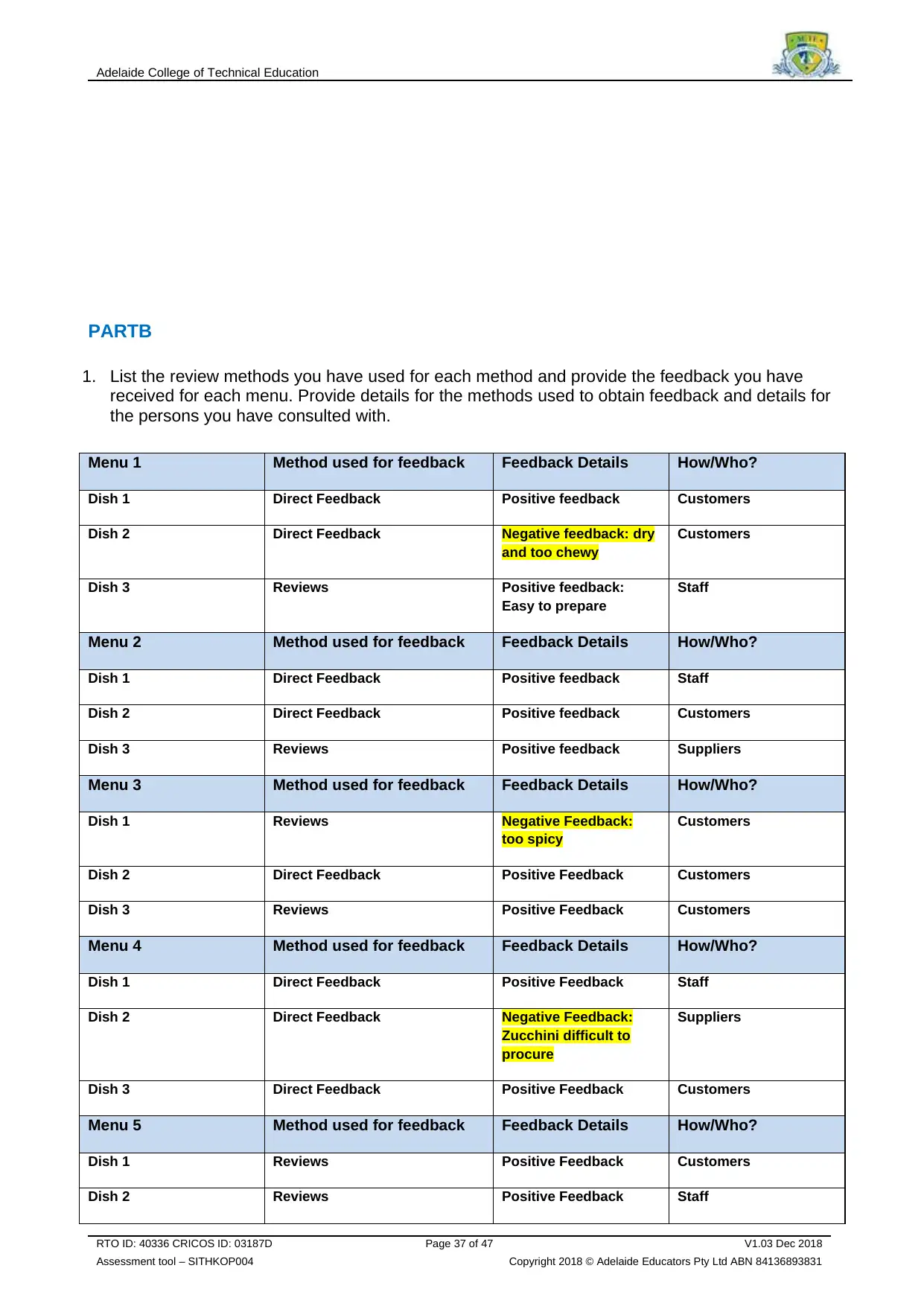
Adelaide College of Technical Education
PARTB
1. List the review methods you have used for each method and provide the feedback you have
received for each menu. Provide details for the methods used to obtain feedback and details for
the persons you have consulted with.
Menu 1 Method used for feedback Feedback Details How/Who?
Dish 1 Direct Feedback Positive feedback Customers
Dish 2 Direct Feedback Negative feedback: dry
and too chewy
Customers
Dish 3 Reviews Positive feedback:
Easy to prepare
Staff
Menu 2 Method used for feedback Feedback Details How/Who?
Dish 1 Direct Feedback Positive feedback Staff
Dish 2 Direct Feedback Positive feedback Customers
Dish 3 Reviews Positive feedback Suppliers
Menu 3 Method used for feedback Feedback Details How/Who?
Dish 1 Reviews Negative Feedback:
too spicy
Customers
Dish 2 Direct Feedback Positive Feedback Customers
Dish 3 Reviews Positive Feedback Customers
Menu 4 Method used for feedback Feedback Details How/Who?
Dish 1 Direct Feedback Positive Feedback Staff
Dish 2 Direct Feedback Negative Feedback:
Zucchini difficult to
procure
Suppliers
Dish 3 Direct Feedback Positive Feedback Customers
Menu 5 Method used for feedback Feedback Details How/Who?
Dish 1 Reviews Positive Feedback Customers
Dish 2 Reviews Positive Feedback Staff
RTO ID: 40336 CRICOS ID: 03187D Page 37 of 47 V1.03 Dec 2018
Assessment tool – SITHKOP004 Copyright 2018 © Adelaide Educators Pty Ltd ABN 84136893831
PARTB
1. List the review methods you have used for each method and provide the feedback you have
received for each menu. Provide details for the methods used to obtain feedback and details for
the persons you have consulted with.
Menu 1 Method used for feedback Feedback Details How/Who?
Dish 1 Direct Feedback Positive feedback Customers
Dish 2 Direct Feedback Negative feedback: dry
and too chewy
Customers
Dish 3 Reviews Positive feedback:
Easy to prepare
Staff
Menu 2 Method used for feedback Feedback Details How/Who?
Dish 1 Direct Feedback Positive feedback Staff
Dish 2 Direct Feedback Positive feedback Customers
Dish 3 Reviews Positive feedback Suppliers
Menu 3 Method used for feedback Feedback Details How/Who?
Dish 1 Reviews Negative Feedback:
too spicy
Customers
Dish 2 Direct Feedback Positive Feedback Customers
Dish 3 Reviews Positive Feedback Customers
Menu 4 Method used for feedback Feedback Details How/Who?
Dish 1 Direct Feedback Positive Feedback Staff
Dish 2 Direct Feedback Negative Feedback:
Zucchini difficult to
procure
Suppliers
Dish 3 Direct Feedback Positive Feedback Customers
Menu 5 Method used for feedback Feedback Details How/Who?
Dish 1 Reviews Positive Feedback Customers
Dish 2 Reviews Positive Feedback Staff
RTO ID: 40336 CRICOS ID: 03187D Page 37 of 47 V1.03 Dec 2018
Assessment tool – SITHKOP004 Copyright 2018 © Adelaide Educators Pty Ltd ABN 84136893831
Paraphrase This Document
Need a fresh take? Get an instant paraphrase of this document with our AI Paraphraser
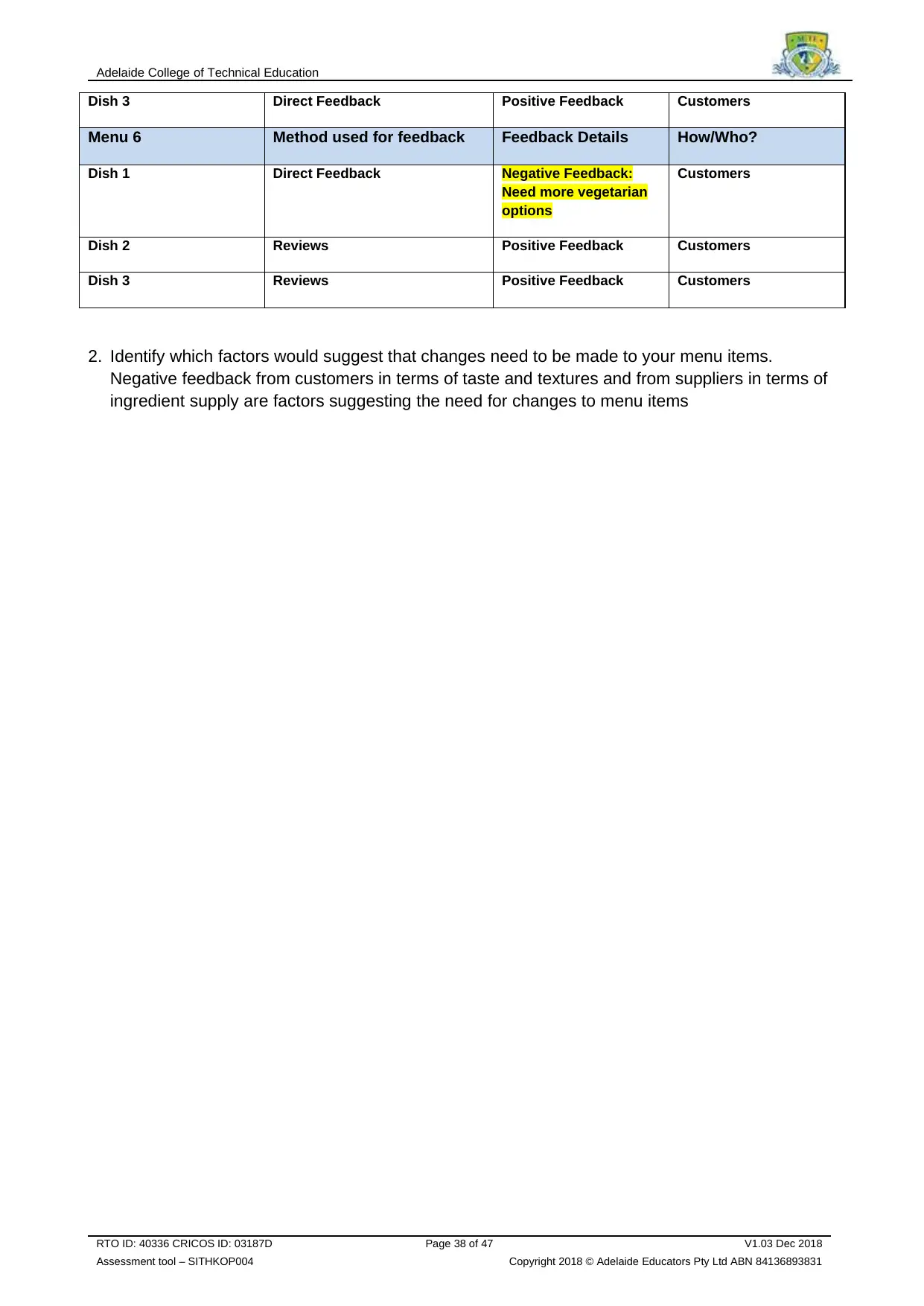
Adelaide College of Technical Education
Dish 3 Direct Feedback Positive Feedback Customers
Menu 6 Method used for feedback Feedback Details How/Who?
Dish 1 Direct Feedback Negative Feedback:
Need more vegetarian
options
Customers
Dish 2 Reviews Positive Feedback Customers
Dish 3 Reviews Positive Feedback Customers
2. Identify which factors would suggest that changes need to be made to your menu items.
Negative feedback from customers in terms of taste and textures and from suppliers in terms of
ingredient supply are factors suggesting the need for changes to menu items
RTO ID: 40336 CRICOS ID: 03187D Page 38 of 47 V1.03 Dec 2018
Assessment tool – SITHKOP004 Copyright 2018 © Adelaide Educators Pty Ltd ABN 84136893831
Dish 3 Direct Feedback Positive Feedback Customers
Menu 6 Method used for feedback Feedback Details How/Who?
Dish 1 Direct Feedback Negative Feedback:
Need more vegetarian
options
Customers
Dish 2 Reviews Positive Feedback Customers
Dish 3 Reviews Positive Feedback Customers
2. Identify which factors would suggest that changes need to be made to your menu items.
Negative feedback from customers in terms of taste and textures and from suppliers in terms of
ingredient supply are factors suggesting the need for changes to menu items
RTO ID: 40336 CRICOS ID: 03187D Page 38 of 47 V1.03 Dec 2018
Assessment tool – SITHKOP004 Copyright 2018 © Adelaide Educators Pty Ltd ABN 84136893831
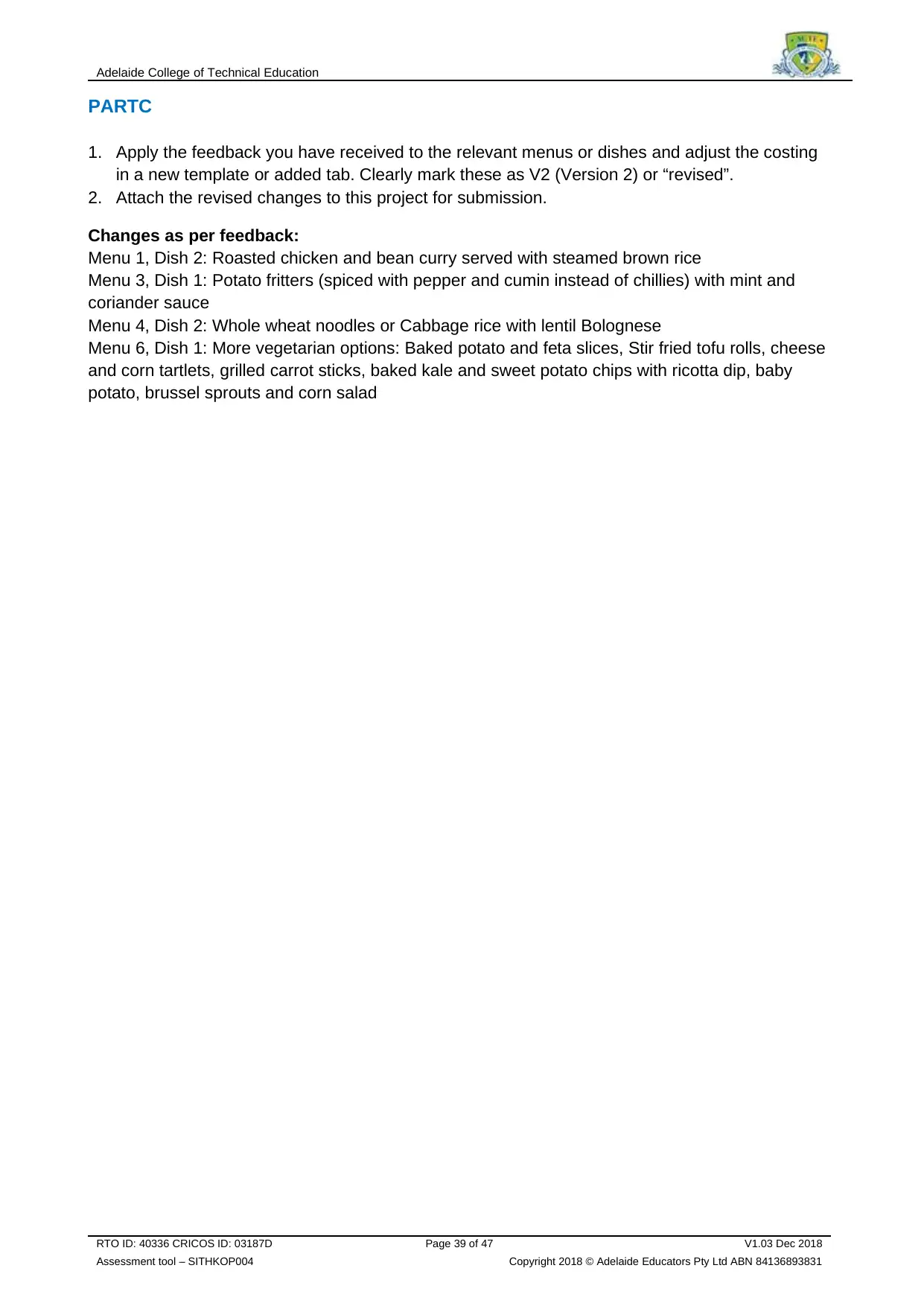
Adelaide College of Technical Education
PARTC
1. Apply the feedback you have received to the relevant menus or dishes and adjust the costing
in a new template or added tab. Clearly mark these as V2 (Version 2) or “revised”.
2. Attach the revised changes to this project for submission.
Changes as per feedback:
Menu 1, Dish 2: Roasted chicken and bean curry served with steamed brown rice
Menu 3, Dish 1: Potato fritters (spiced with pepper and cumin instead of chillies) with mint and
coriander sauce
Menu 4, Dish 2: Whole wheat noodles or Cabbage rice with lentil Bolognese
Menu 6, Dish 1: More vegetarian options: Baked potato and feta slices, Stir fried tofu rolls, cheese
and corn tartlets, grilled carrot sticks, baked kale and sweet potato chips with ricotta dip, baby
potato, brussel sprouts and corn salad
RTO ID: 40336 CRICOS ID: 03187D Page 39 of 47 V1.03 Dec 2018
Assessment tool – SITHKOP004 Copyright 2018 © Adelaide Educators Pty Ltd ABN 84136893831
PARTC
1. Apply the feedback you have received to the relevant menus or dishes and adjust the costing
in a new template or added tab. Clearly mark these as V2 (Version 2) or “revised”.
2. Attach the revised changes to this project for submission.
Changes as per feedback:
Menu 1, Dish 2: Roasted chicken and bean curry served with steamed brown rice
Menu 3, Dish 1: Potato fritters (spiced with pepper and cumin instead of chillies) with mint and
coriander sauce
Menu 4, Dish 2: Whole wheat noodles or Cabbage rice with lentil Bolognese
Menu 6, Dish 1: More vegetarian options: Baked potato and feta slices, Stir fried tofu rolls, cheese
and corn tartlets, grilled carrot sticks, baked kale and sweet potato chips with ricotta dip, baby
potato, brussel sprouts and corn salad
RTO ID: 40336 CRICOS ID: 03187D Page 39 of 47 V1.03 Dec 2018
Assessment tool – SITHKOP004 Copyright 2018 © Adelaide Educators Pty Ltd ABN 84136893831
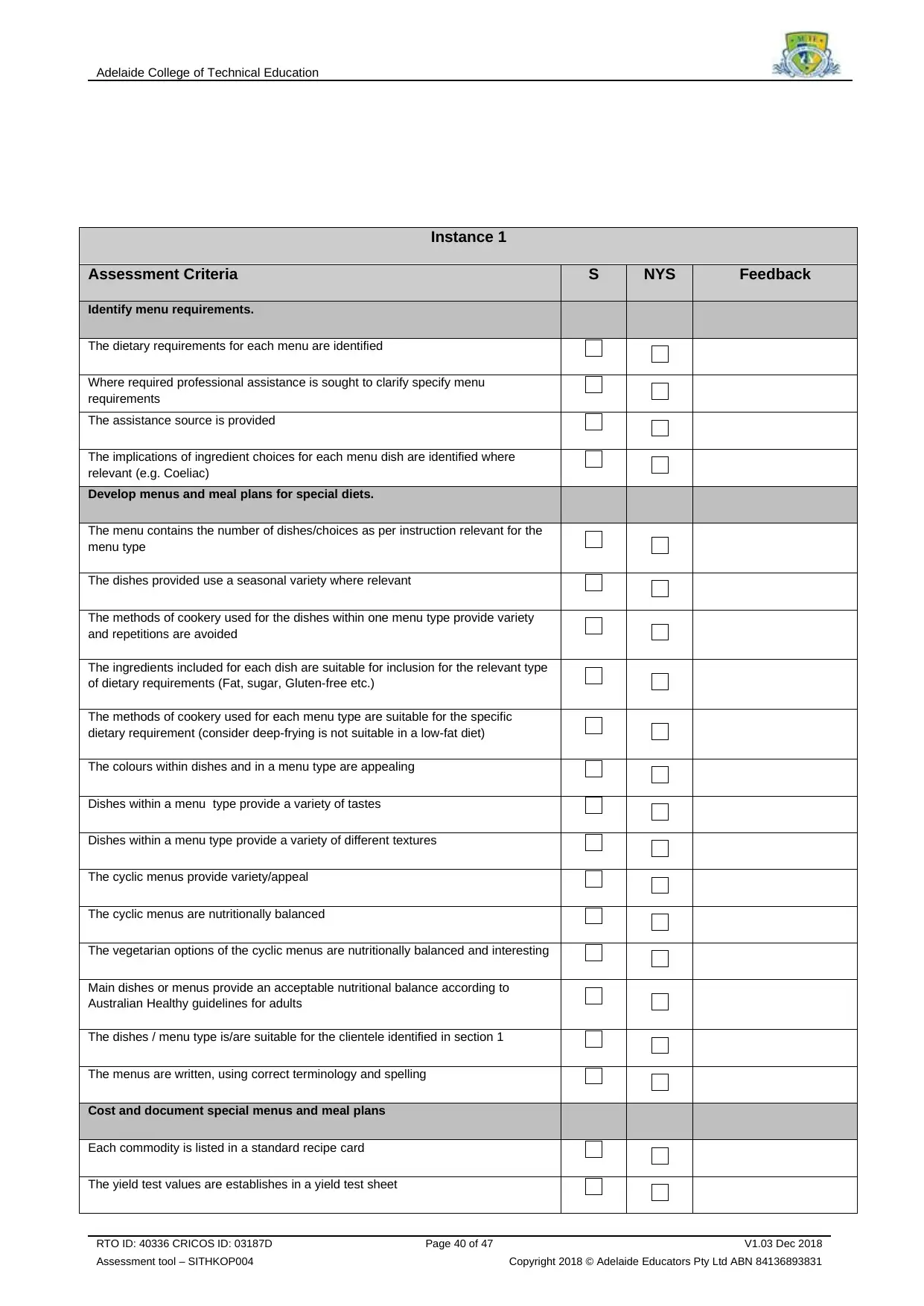
Adelaide College of Technical Education
Instance 1
Assessment Criteria S NYS Feedback
Identify menu requirements.
The dietary requirements for each menu are identified
Where required professional assistance is sought to clarify specify menu
requirements
The assistance source is provided
The implications of ingredient choices for each menu dish are identified where
relevant (e.g. Coeliac)
Develop menus and meal plans for special diets.
The menu contains the number of dishes/choices as per instruction relevant for the
menu type
The dishes provided use a seasonal variety where relevant
The methods of cookery used for the dishes within one menu type provide variety
and repetitions are avoided
The ingredients included for each dish are suitable for inclusion for the relevant type
of dietary requirements (Fat, sugar, Gluten-free etc.)
The methods of cookery used for each menu type are suitable for the specific
dietary requirement (consider deep-frying is not suitable in a low-fat diet)
The colours within dishes and in a menu type are appealing
Dishes within a menu type provide a variety of tastes
Dishes within a menu type provide a variety of different textures
The cyclic menus provide variety/appeal
The cyclic menus are nutritionally balanced
The vegetarian options of the cyclic menus are nutritionally balanced and interesting
Main dishes or menus provide an acceptable nutritional balance according to
Australian Healthy guidelines for adults
The dishes / menu type is/are suitable for the clientele identified in section 1
The menus are written, using correct terminology and spelling
Cost and document special menus and meal plans
Each commodity is listed in a standard recipe card
The yield test values are establishes in a yield test sheet
RTO ID: 40336 CRICOS ID: 03187D Page 40 of 47 V1.03 Dec 2018
Assessment tool – SITHKOP004 Copyright 2018 © Adelaide Educators Pty Ltd ABN 84136893831
Instance 1
Assessment Criteria S NYS Feedback
Identify menu requirements.
The dietary requirements for each menu are identified
Where required professional assistance is sought to clarify specify menu
requirements
The assistance source is provided
The implications of ingredient choices for each menu dish are identified where
relevant (e.g. Coeliac)
Develop menus and meal plans for special diets.
The menu contains the number of dishes/choices as per instruction relevant for the
menu type
The dishes provided use a seasonal variety where relevant
The methods of cookery used for the dishes within one menu type provide variety
and repetitions are avoided
The ingredients included for each dish are suitable for inclusion for the relevant type
of dietary requirements (Fat, sugar, Gluten-free etc.)
The methods of cookery used for each menu type are suitable for the specific
dietary requirement (consider deep-frying is not suitable in a low-fat diet)
The colours within dishes and in a menu type are appealing
Dishes within a menu type provide a variety of tastes
Dishes within a menu type provide a variety of different textures
The cyclic menus provide variety/appeal
The cyclic menus are nutritionally balanced
The vegetarian options of the cyclic menus are nutritionally balanced and interesting
Main dishes or menus provide an acceptable nutritional balance according to
Australian Healthy guidelines for adults
The dishes / menu type is/are suitable for the clientele identified in section 1
The menus are written, using correct terminology and spelling
Cost and document special menus and meal plans
Each commodity is listed in a standard recipe card
The yield test values are establishes in a yield test sheet
RTO ID: 40336 CRICOS ID: 03187D Page 40 of 47 V1.03 Dec 2018
Assessment tool – SITHKOP004 Copyright 2018 © Adelaide Educators Pty Ltd ABN 84136893831
Secure Best Marks with AI Grader
Need help grading? Try our AI Grader for instant feedback on your assignments.
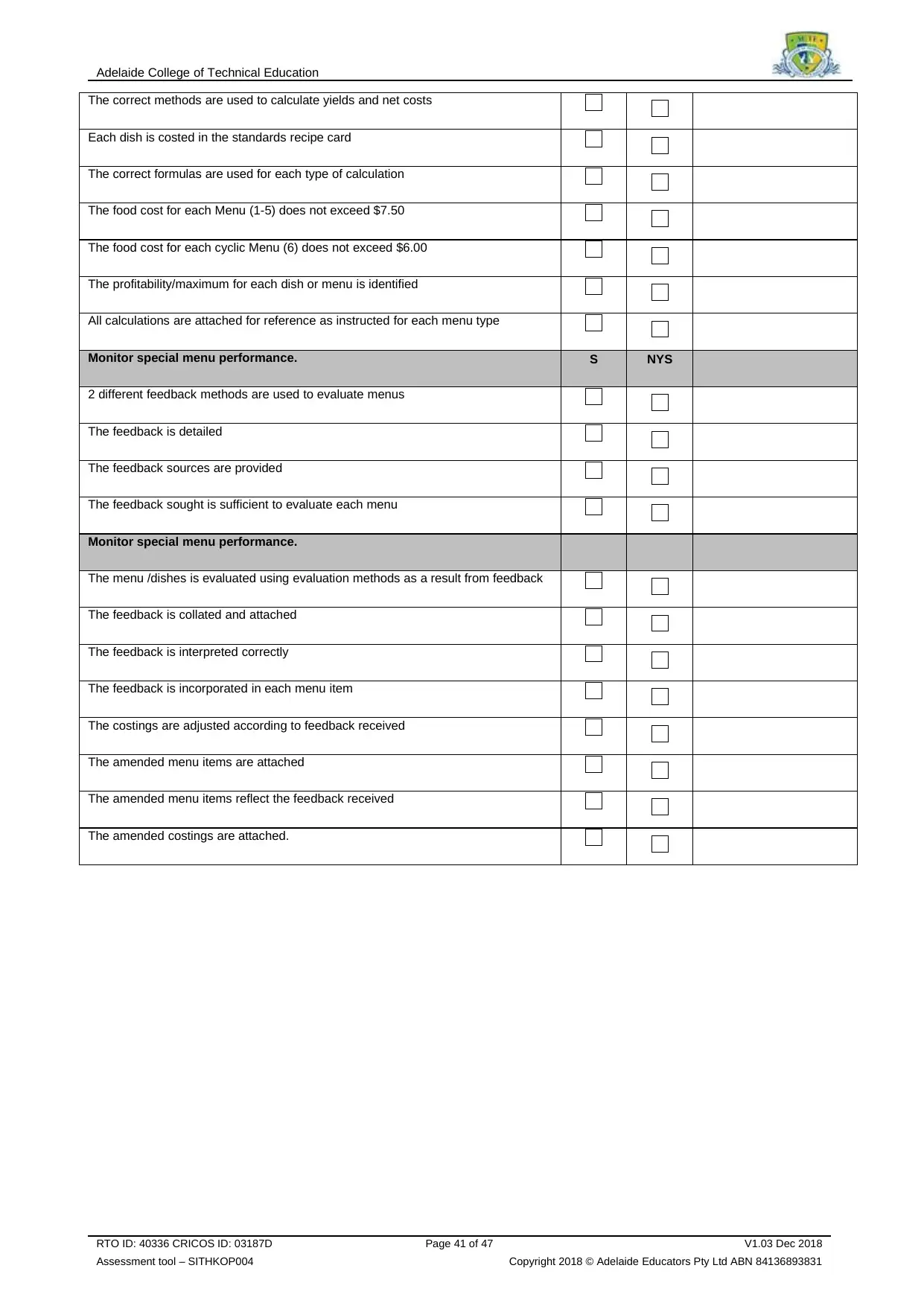
Adelaide College of Technical Education
The correct methods are used to calculate yields and net costs
Each dish is costed in the standards recipe card
The correct formulas are used for each type of calculation
The food cost for each Menu (1-5) does not exceed $7.50
The food cost for each cyclic Menu (6) does not exceed $6.00
The profitability/maximum for each dish or menu is identified
All calculations are attached for reference as instructed for each menu type
Monitor special menu performance. S NYS
2 different feedback methods are used to evaluate menus
The feedback is detailed
The feedback sources are provided
The feedback sought is sufficient to evaluate each menu
Monitor special menu performance.
The menu /dishes is evaluated using evaluation methods as a result from feedback
The feedback is collated and attached
The feedback is interpreted correctly
The feedback is incorporated in each menu item
The costings are adjusted according to feedback received
The amended menu items are attached
The amended menu items reflect the feedback received
The amended costings are attached.
RTO ID: 40336 CRICOS ID: 03187D Page 41 of 47 V1.03 Dec 2018
Assessment tool – SITHKOP004 Copyright 2018 © Adelaide Educators Pty Ltd ABN 84136893831
The correct methods are used to calculate yields and net costs
Each dish is costed in the standards recipe card
The correct formulas are used for each type of calculation
The food cost for each Menu (1-5) does not exceed $7.50
The food cost for each cyclic Menu (6) does not exceed $6.00
The profitability/maximum for each dish or menu is identified
All calculations are attached for reference as instructed for each menu type
Monitor special menu performance. S NYS
2 different feedback methods are used to evaluate menus
The feedback is detailed
The feedback sources are provided
The feedback sought is sufficient to evaluate each menu
Monitor special menu performance.
The menu /dishes is evaluated using evaluation methods as a result from feedback
The feedback is collated and attached
The feedback is interpreted correctly
The feedback is incorporated in each menu item
The costings are adjusted according to feedback received
The amended menu items are attached
The amended menu items reflect the feedback received
The amended costings are attached.
RTO ID: 40336 CRICOS ID: 03187D Page 41 of 47 V1.03 Dec 2018
Assessment tool – SITHKOP004 Copyright 2018 © Adelaide Educators Pty Ltd ABN 84136893831
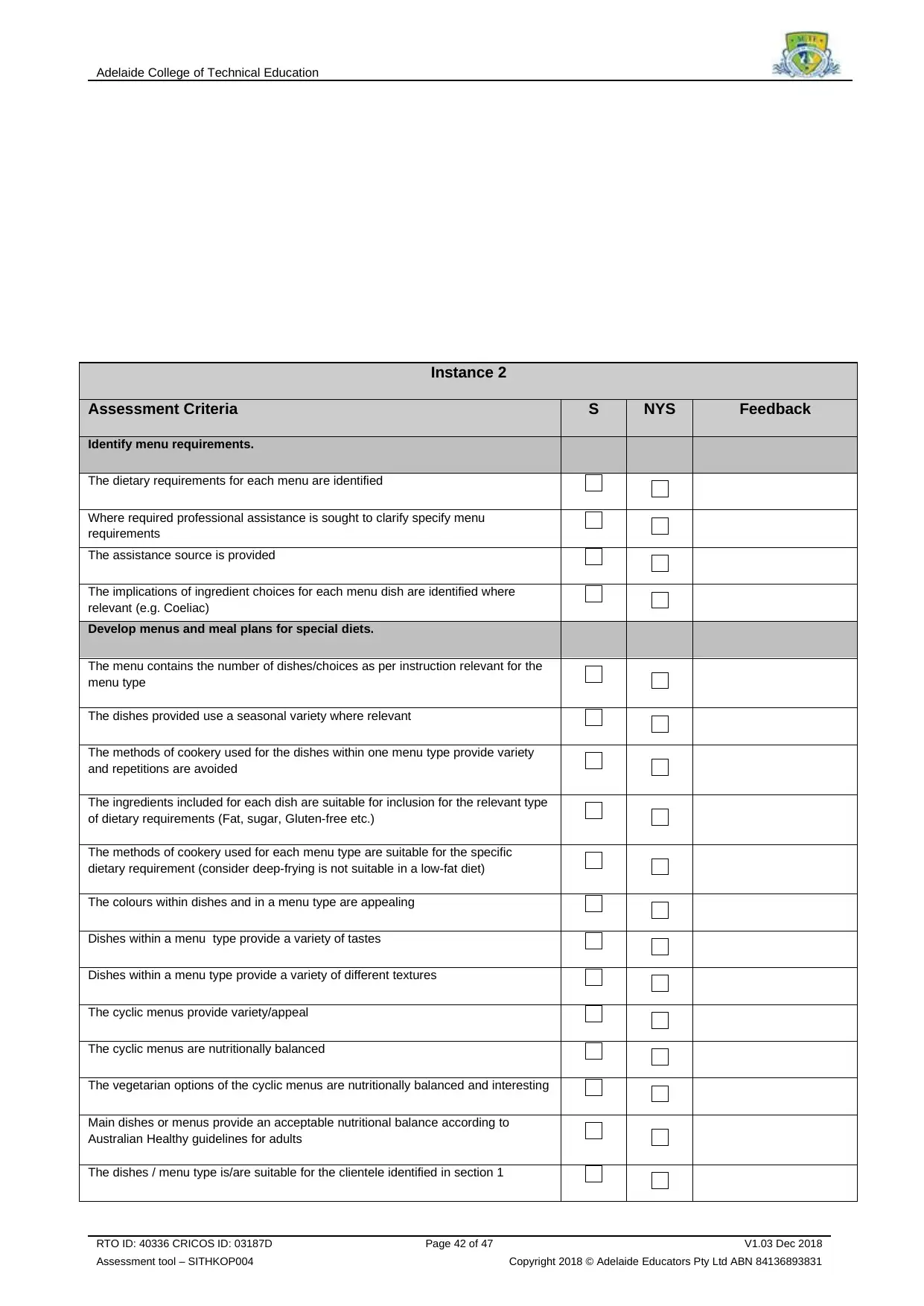
Adelaide College of Technical Education
Instance 2
Assessment Criteria S NYS Feedback
Identify menu requirements.
The dietary requirements for each menu are identified
Where required professional assistance is sought to clarify specify menu
requirements
The assistance source is provided
The implications of ingredient choices for each menu dish are identified where
relevant (e.g. Coeliac)
Develop menus and meal plans for special diets.
The menu contains the number of dishes/choices as per instruction relevant for the
menu type
The dishes provided use a seasonal variety where relevant
The methods of cookery used for the dishes within one menu type provide variety
and repetitions are avoided
The ingredients included for each dish are suitable for inclusion for the relevant type
of dietary requirements (Fat, sugar, Gluten-free etc.)
The methods of cookery used for each menu type are suitable for the specific
dietary requirement (consider deep-frying is not suitable in a low-fat diet)
The colours within dishes and in a menu type are appealing
Dishes within a menu type provide a variety of tastes
Dishes within a menu type provide a variety of different textures
The cyclic menus provide variety/appeal
The cyclic menus are nutritionally balanced
The vegetarian options of the cyclic menus are nutritionally balanced and interesting
Main dishes or menus provide an acceptable nutritional balance according to
Australian Healthy guidelines for adults
The dishes / menu type is/are suitable for the clientele identified in section 1
RTO ID: 40336 CRICOS ID: 03187D Page 42 of 47 V1.03 Dec 2018
Assessment tool – SITHKOP004 Copyright 2018 © Adelaide Educators Pty Ltd ABN 84136893831
Instance 2
Assessment Criteria S NYS Feedback
Identify menu requirements.
The dietary requirements for each menu are identified
Where required professional assistance is sought to clarify specify menu
requirements
The assistance source is provided
The implications of ingredient choices for each menu dish are identified where
relevant (e.g. Coeliac)
Develop menus and meal plans for special diets.
The menu contains the number of dishes/choices as per instruction relevant for the
menu type
The dishes provided use a seasonal variety where relevant
The methods of cookery used for the dishes within one menu type provide variety
and repetitions are avoided
The ingredients included for each dish are suitable for inclusion for the relevant type
of dietary requirements (Fat, sugar, Gluten-free etc.)
The methods of cookery used for each menu type are suitable for the specific
dietary requirement (consider deep-frying is not suitable in a low-fat diet)
The colours within dishes and in a menu type are appealing
Dishes within a menu type provide a variety of tastes
Dishes within a menu type provide a variety of different textures
The cyclic menus provide variety/appeal
The cyclic menus are nutritionally balanced
The vegetarian options of the cyclic menus are nutritionally balanced and interesting
Main dishes or menus provide an acceptable nutritional balance according to
Australian Healthy guidelines for adults
The dishes / menu type is/are suitable for the clientele identified in section 1
RTO ID: 40336 CRICOS ID: 03187D Page 42 of 47 V1.03 Dec 2018
Assessment tool – SITHKOP004 Copyright 2018 © Adelaide Educators Pty Ltd ABN 84136893831
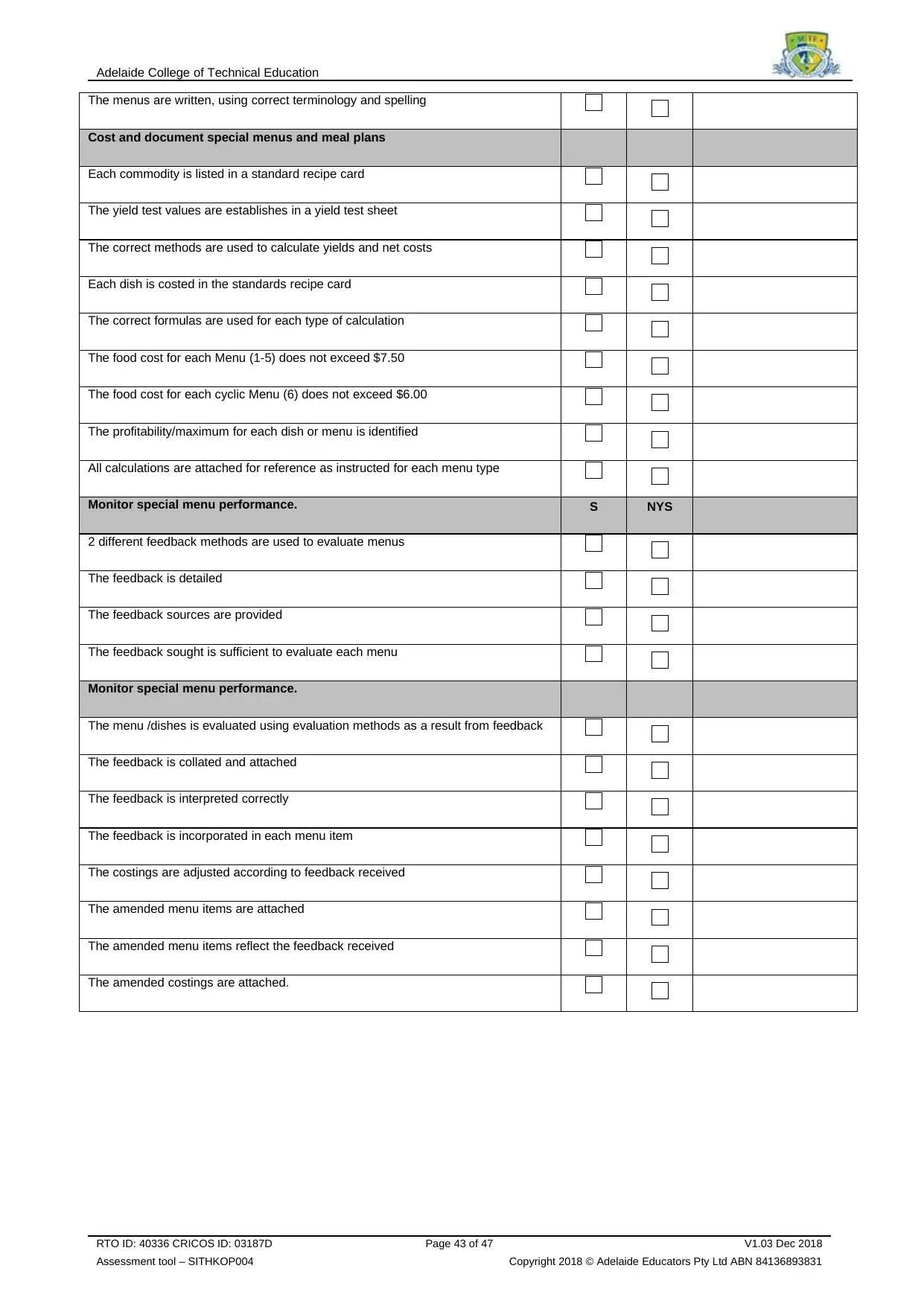
Adelaide College of Technical Education
The menus are written, using correct terminology and spelling
Cost and document special menus and meal plans
Each commodity is listed in a standard recipe card
The yield test values are establishes in a yield test sheet
The correct methods are used to calculate yields and net costs
Each dish is costed in the standards recipe card
The correct formulas are used for each type of calculation
The food cost for each Menu (1-5) does not exceed $7.50
The food cost for each cyclic Menu (6) does not exceed $6.00
The profitability/maximum for each dish or menu is identified
All calculations are attached for reference as instructed for each menu type
Monitor special menu performance. S NYS
2 different feedback methods are used to evaluate menus
The feedback is detailed
The feedback sources are provided
The feedback sought is sufficient to evaluate each menu
Monitor special menu performance.
The menu /dishes is evaluated using evaluation methods as a result from feedback
The feedback is collated and attached
The feedback is interpreted correctly
The feedback is incorporated in each menu item
The costings are adjusted according to feedback received
The amended menu items are attached
The amended menu items reflect the feedback received
The amended costings are attached.
RTO ID: 40336 CRICOS ID: 03187D Page 43 of 47 V1.03 Dec 2018
Assessment tool – SITHKOP004 Copyright 2018 © Adelaide Educators Pty Ltd ABN 84136893831
The menus are written, using correct terminology and spelling
Cost and document special menus and meal plans
Each commodity is listed in a standard recipe card
The yield test values are establishes in a yield test sheet
The correct methods are used to calculate yields and net costs
Each dish is costed in the standards recipe card
The correct formulas are used for each type of calculation
The food cost for each Menu (1-5) does not exceed $7.50
The food cost for each cyclic Menu (6) does not exceed $6.00
The profitability/maximum for each dish or menu is identified
All calculations are attached for reference as instructed for each menu type
Monitor special menu performance. S NYS
2 different feedback methods are used to evaluate menus
The feedback is detailed
The feedback sources are provided
The feedback sought is sufficient to evaluate each menu
Monitor special menu performance.
The menu /dishes is evaluated using evaluation methods as a result from feedback
The feedback is collated and attached
The feedback is interpreted correctly
The feedback is incorporated in each menu item
The costings are adjusted according to feedback received
The amended menu items are attached
The amended menu items reflect the feedback received
The amended costings are attached.
RTO ID: 40336 CRICOS ID: 03187D Page 43 of 47 V1.03 Dec 2018
Assessment tool – SITHKOP004 Copyright 2018 © Adelaide Educators Pty Ltd ABN 84136893831
Paraphrase This Document
Need a fresh take? Get an instant paraphrase of this document with our AI Paraphraser
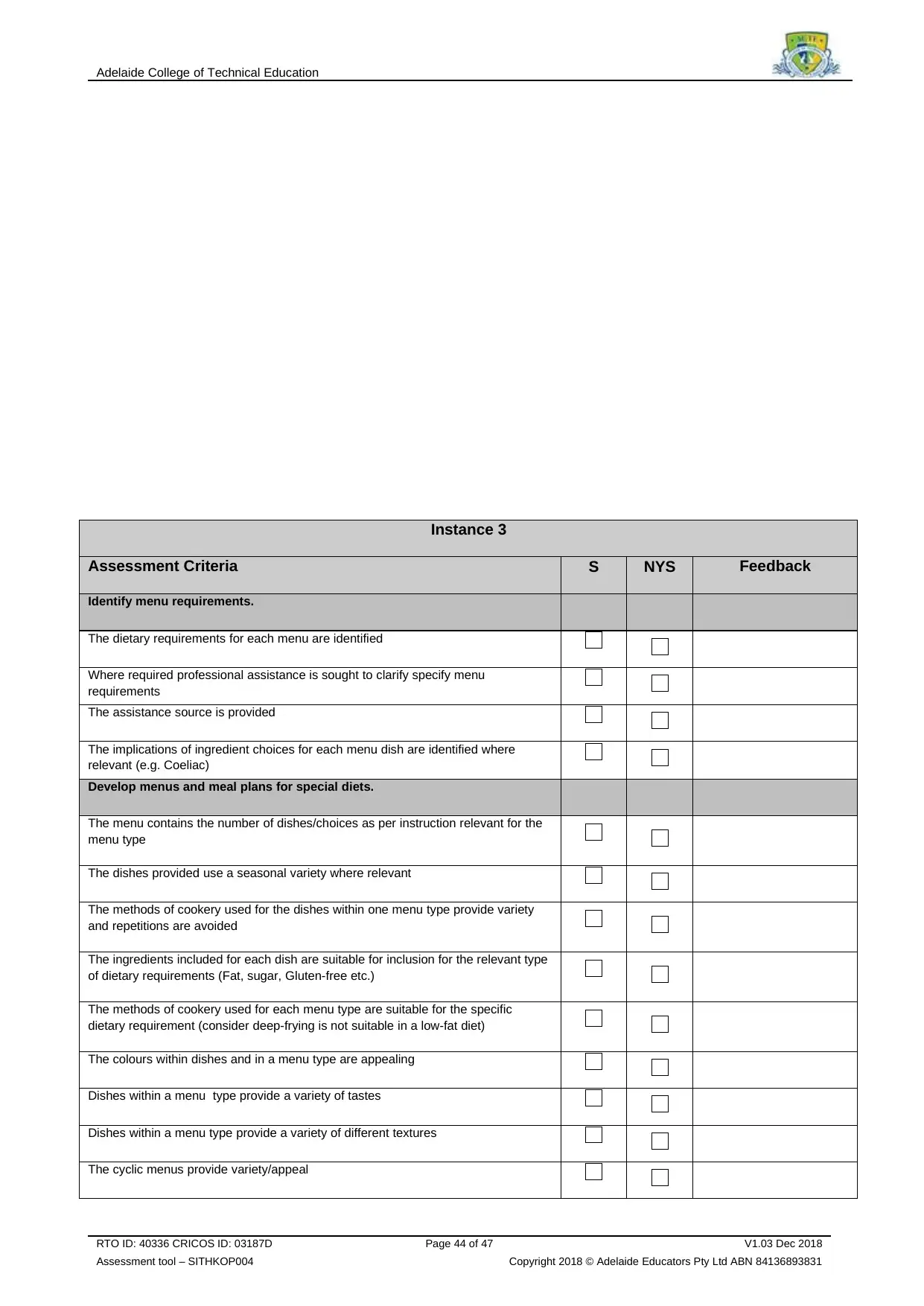
Adelaide College of Technical Education
Instance 3
Assessment Criteria S NYS Feedback
Identify menu requirements.
The dietary requirements for each menu are identified
Where required professional assistance is sought to clarify specify menu
requirements
The assistance source is provided
The implications of ingredient choices for each menu dish are identified where
relevant (e.g. Coeliac)
Develop menus and meal plans for special diets.
The menu contains the number of dishes/choices as per instruction relevant for the
menu type
The dishes provided use a seasonal variety where relevant
The methods of cookery used for the dishes within one menu type provide variety
and repetitions are avoided
The ingredients included for each dish are suitable for inclusion for the relevant type
of dietary requirements (Fat, sugar, Gluten-free etc.)
The methods of cookery used for each menu type are suitable for the specific
dietary requirement (consider deep-frying is not suitable in a low-fat diet)
The colours within dishes and in a menu type are appealing
Dishes within a menu type provide a variety of tastes
Dishes within a menu type provide a variety of different textures
The cyclic menus provide variety/appeal
RTO ID: 40336 CRICOS ID: 03187D Page 44 of 47 V1.03 Dec 2018
Assessment tool – SITHKOP004 Copyright 2018 © Adelaide Educators Pty Ltd ABN 84136893831
Instance 3
Assessment Criteria S NYS Feedback
Identify menu requirements.
The dietary requirements for each menu are identified
Where required professional assistance is sought to clarify specify menu
requirements
The assistance source is provided
The implications of ingredient choices for each menu dish are identified where
relevant (e.g. Coeliac)
Develop menus and meal plans for special diets.
The menu contains the number of dishes/choices as per instruction relevant for the
menu type
The dishes provided use a seasonal variety where relevant
The methods of cookery used for the dishes within one menu type provide variety
and repetitions are avoided
The ingredients included for each dish are suitable for inclusion for the relevant type
of dietary requirements (Fat, sugar, Gluten-free etc.)
The methods of cookery used for each menu type are suitable for the specific
dietary requirement (consider deep-frying is not suitable in a low-fat diet)
The colours within dishes and in a menu type are appealing
Dishes within a menu type provide a variety of tastes
Dishes within a menu type provide a variety of different textures
The cyclic menus provide variety/appeal
RTO ID: 40336 CRICOS ID: 03187D Page 44 of 47 V1.03 Dec 2018
Assessment tool – SITHKOP004 Copyright 2018 © Adelaide Educators Pty Ltd ABN 84136893831
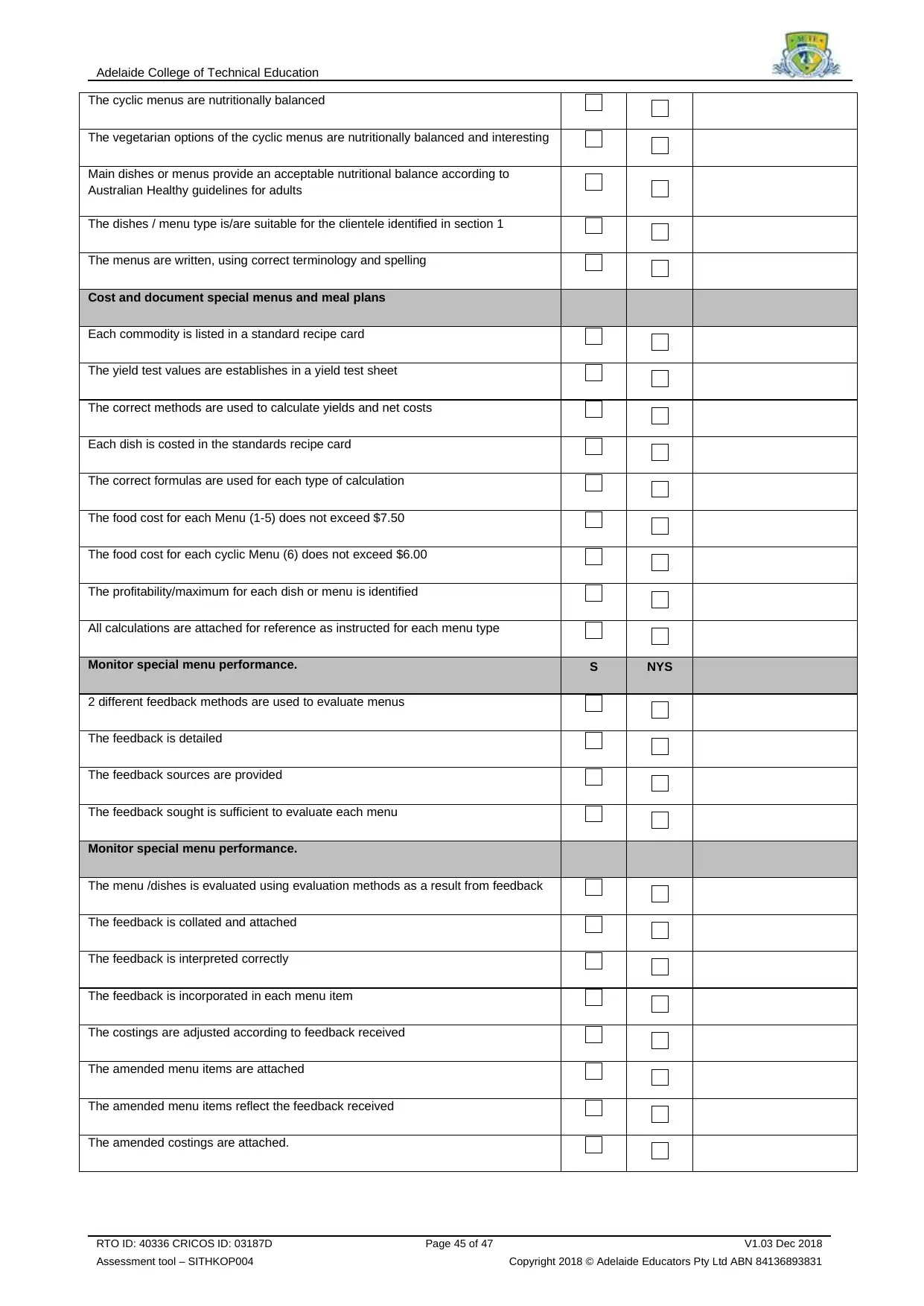
Adelaide College of Technical Education
The cyclic menus are nutritionally balanced
The vegetarian options of the cyclic menus are nutritionally balanced and interesting
Main dishes or menus provide an acceptable nutritional balance according to
Australian Healthy guidelines for adults
The dishes / menu type is/are suitable for the clientele identified in section 1
The menus are written, using correct terminology and spelling
Cost and document special menus and meal plans
Each commodity is listed in a standard recipe card
The yield test values are establishes in a yield test sheet
The correct methods are used to calculate yields and net costs
Each dish is costed in the standards recipe card
The correct formulas are used for each type of calculation
The food cost for each Menu (1-5) does not exceed $7.50
The food cost for each cyclic Menu (6) does not exceed $6.00
The profitability/maximum for each dish or menu is identified
All calculations are attached for reference as instructed for each menu type
Monitor special menu performance. S NYS
2 different feedback methods are used to evaluate menus
The feedback is detailed
The feedback sources are provided
The feedback sought is sufficient to evaluate each menu
Monitor special menu performance.
The menu /dishes is evaluated using evaluation methods as a result from feedback
The feedback is collated and attached
The feedback is interpreted correctly
The feedback is incorporated in each menu item
The costings are adjusted according to feedback received
The amended menu items are attached
The amended menu items reflect the feedback received
The amended costings are attached.
RTO ID: 40336 CRICOS ID: 03187D Page 45 of 47 V1.03 Dec 2018
Assessment tool – SITHKOP004 Copyright 2018 © Adelaide Educators Pty Ltd ABN 84136893831
The cyclic menus are nutritionally balanced
The vegetarian options of the cyclic menus are nutritionally balanced and interesting
Main dishes or menus provide an acceptable nutritional balance according to
Australian Healthy guidelines for adults
The dishes / menu type is/are suitable for the clientele identified in section 1
The menus are written, using correct terminology and spelling
Cost and document special menus and meal plans
Each commodity is listed in a standard recipe card
The yield test values are establishes in a yield test sheet
The correct methods are used to calculate yields and net costs
Each dish is costed in the standards recipe card
The correct formulas are used for each type of calculation
The food cost for each Menu (1-5) does not exceed $7.50
The food cost for each cyclic Menu (6) does not exceed $6.00
The profitability/maximum for each dish or menu is identified
All calculations are attached for reference as instructed for each menu type
Monitor special menu performance. S NYS
2 different feedback methods are used to evaluate menus
The feedback is detailed
The feedback sources are provided
The feedback sought is sufficient to evaluate each menu
Monitor special menu performance.
The menu /dishes is evaluated using evaluation methods as a result from feedback
The feedback is collated and attached
The feedback is interpreted correctly
The feedback is incorporated in each menu item
The costings are adjusted according to feedback received
The amended menu items are attached
The amended menu items reflect the feedback received
The amended costings are attached.
RTO ID: 40336 CRICOS ID: 03187D Page 45 of 47 V1.03 Dec 2018
Assessment tool – SITHKOP004 Copyright 2018 © Adelaide Educators Pty Ltd ABN 84136893831
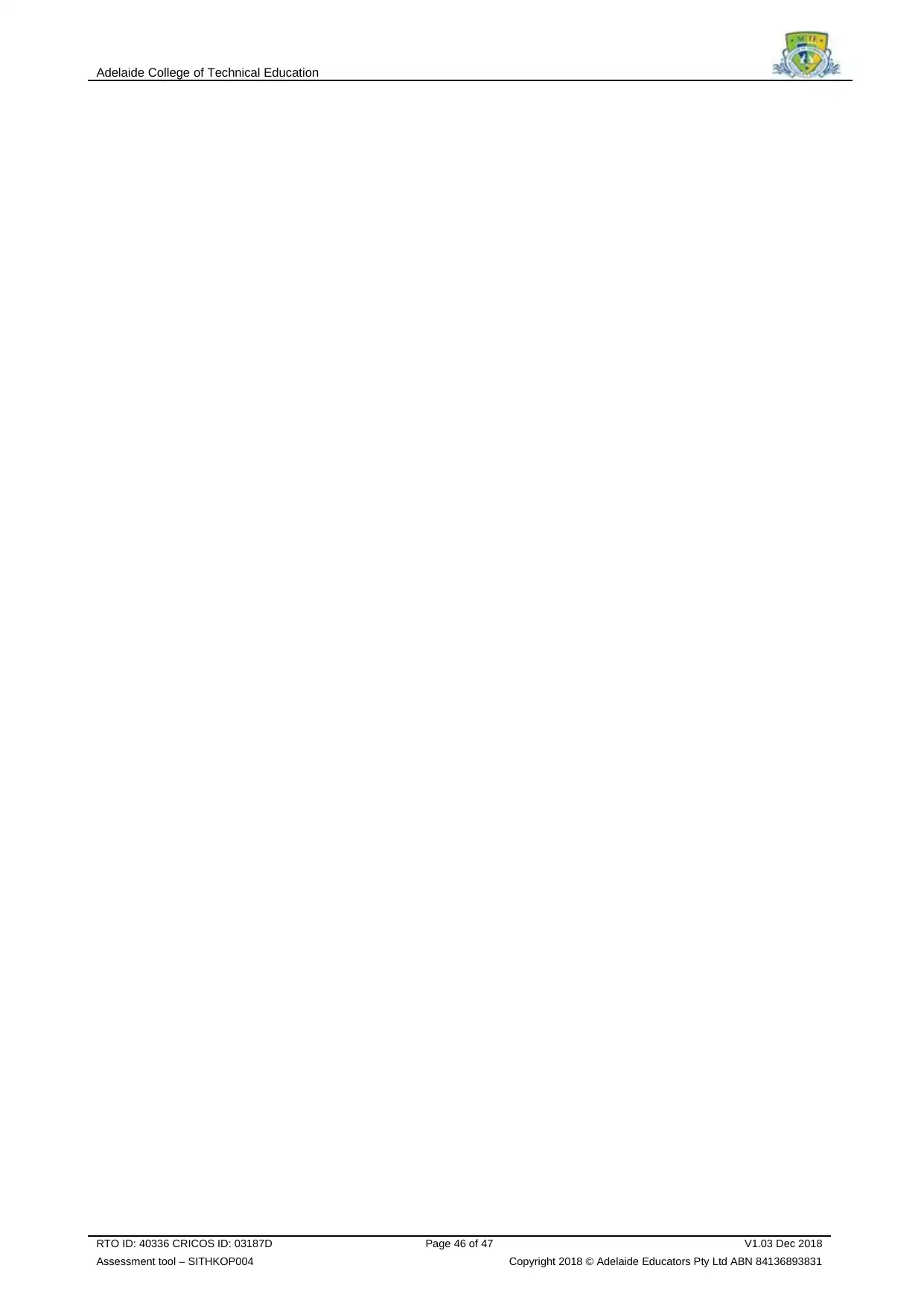
Adelaide College of Technical Education
RTO ID: 40336 CRICOS ID: 03187D Page 46 of 47 V1.03 Dec 2018
Assessment tool – SITHKOP004 Copyright 2018 © Adelaide Educators Pty Ltd ABN 84136893831
RTO ID: 40336 CRICOS ID: 03187D Page 46 of 47 V1.03 Dec 2018
Assessment tool – SITHKOP004 Copyright 2018 © Adelaide Educators Pty Ltd ABN 84136893831
Secure Best Marks with AI Grader
Need help grading? Try our AI Grader for instant feedback on your assignments.
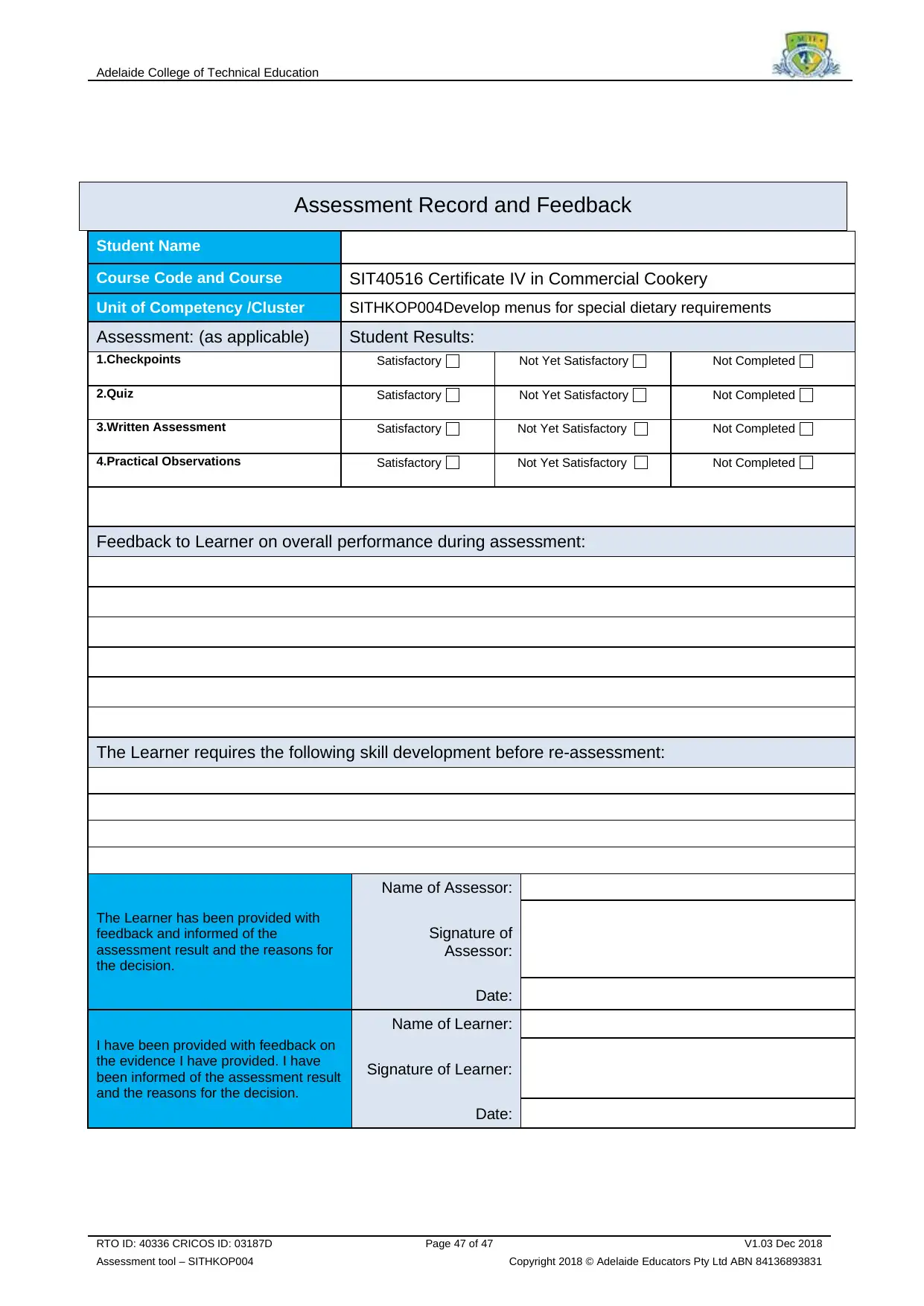
Adelaide College of Technical Education
Assessment Record and Feedback
Student Name
Course Code and Course SIT40516 Certificate IV in Commercial Cookery
Unit of Competency /Cluster SITHKOP004Develop menus for special dietary requirements
Assessment: (as applicable) Student Results:
1.Checkpoints Satisfactory Not Yet Satisfactory Not Completed
2.Quiz Satisfactory Not Yet Satisfactory Not Completed
3.Written Assessment Satisfactory Not Yet Satisfactory Not Completed
4.Practical Observations Satisfactory Not Yet Satisfactory Not Completed
Feedback to Learner on overall performance during assessment:
The Learner requires the following skill development before re-assessment:
The Learner has been provided with
feedback and informed of the
assessment result and the reasons for
the decision.
Name of Assessor:
Signature of
Assessor:
Date:
I have been provided with feedback on
the evidence I have provided. I have
been informed of the assessment result
and the reasons for the decision.
Name of Learner:
Signature of Learner:
Date:
RTO ID: 40336 CRICOS ID: 03187D Page 47 of 47 V1.03 Dec 2018
Assessment tool – SITHKOP004 Copyright 2018 © Adelaide Educators Pty Ltd ABN 84136893831
Assessment Record and Feedback
Student Name
Course Code and Course SIT40516 Certificate IV in Commercial Cookery
Unit of Competency /Cluster SITHKOP004Develop menus for special dietary requirements
Assessment: (as applicable) Student Results:
1.Checkpoints Satisfactory Not Yet Satisfactory Not Completed
2.Quiz Satisfactory Not Yet Satisfactory Not Completed
3.Written Assessment Satisfactory Not Yet Satisfactory Not Completed
4.Practical Observations Satisfactory Not Yet Satisfactory Not Completed
Feedback to Learner on overall performance during assessment:
The Learner requires the following skill development before re-assessment:
The Learner has been provided with
feedback and informed of the
assessment result and the reasons for
the decision.
Name of Assessor:
Signature of
Assessor:
Date:
I have been provided with feedback on
the evidence I have provided. I have
been informed of the assessment result
and the reasons for the decision.
Name of Learner:
Signature of Learner:
Date:
RTO ID: 40336 CRICOS ID: 03187D Page 47 of 47 V1.03 Dec 2018
Assessment tool – SITHKOP004 Copyright 2018 © Adelaide Educators Pty Ltd ABN 84136893831
1 out of 47
Related Documents
Your All-in-One AI-Powered Toolkit for Academic Success.
+13062052269
info@desklib.com
Available 24*7 on WhatsApp / Email
![[object Object]](/_next/static/media/star-bottom.7253800d.svg)
Unlock your academic potential
© 2024 | Zucol Services PVT LTD | All rights reserved.





